Driving in Spain
Driving requirements, rules of the road.
- Types of Roads & Speed Limits
- Law Enforcement

Road Safety
- Frequently Asked Questions
It's relatively easy to catch a train or bus to almost anywhere in Spain, but some destinations in the Spanish countryside are only accessible by car or on foot. There are a few rules of the road that differ from American driving laws; if you're considering buying or renting a car during your trip to Spain, here's what you need to know.
To drive in Spain, you'll need to carry your primary driver's license and an International Driver's Permit (IDP), and a collection of safety gear is required to help in an emergency, even though you are not required to have it at all times. For example, while you won't be punished for not carrying safety vests if the police stop you, you could be fined if any occupant of the vehicle exits the roadway in an emergency without wearing a vest.
- Driver's license and IDP (required)
- Insurance documents (required)
- Ownership documents or rental documents (required)
- Passport (required)
- Fluorescent jacket for all occupants (required)
- Two warning triangles (required)
- An extra pair of glasses, if you wear them (required)
- Fire extinguisher (recommended)
- First-aid kit (recommended)
Although Spanish motorists drive on the right side of the road as they do in the United States, there are many subtle and overt differences between the driving laws in the U.S. and those found in Spain. From being required to travel with a fluorescent jacket and warning triangles in the car to not being able to use your phone or screen-based navigation while driving, you'll need to learn these rules of the road before you drive in Spain.
- Seatbelts: All passengers in a car's front and back seats are required to wear a seatbelt.
- Driving age: You must be 18 years old to drive and 21 years old to rent a car in Spain.
- Alcohol: The legal blood alcohol limit for driving is 0.05 percent or 0.25 milligrams per liter in exhaled air. Drunk driving laws and punishments are strict in Spain, and you could be thrown in jail for having a high blood alcohol level.
- Cell phones: The use of cell phones while driving is prohibited. Hands-free kits are permitted, but they are not allowed to have earpiece attachments. Additionally, the use of screen-based navigation systems is not permitted.
- Yellow lines: In residential areas, don't park next to a yellow line. If you do, you will most likely be towed away (especially if you are in a foreign car).
- Gas stations: While you can typically fuel up almost anywhere in Spain, the major difference between Spanish gas stations and American ones is that fuel is labeled differently in Spain. Leaded gasoline is called super or super 68, unleaded is called sin plomo 98 or Eurosuper 95, and diesel is called gasoleo . Additionally, you must shut off the engine, radio, lights, and your mobile phone when refueling.
- Fines and tickets: Unless you have a permanent address in Spain, the Guardia Civil is entitled to ask you to pay your fine immediately as a tourist. If you are unable to pay immediately, they can impound the car. It is therefore wise to pay immediately, especially as there is a 20 percent reduction if you do so. Be sure to get a receipt, especially if you think the police officer has been unfair.
- Children: Kids 12 and under and measuring less than 4 feet, 5.5 inches (135 centimeters), or riding in the front seat must be seated in a child restraint system fitted to their height and weight.
- In case of an emergency: You can dial 112 from anywhere in Europe to be connected to local emergency services. There are also emergency telephones linked to the emergency network in Spain every mile or so along motorways across the country.
Types of Roads and Speed Limits in Spain
Spanish road names that begin with an "AP" are toll roads and, as a result, are usually relatively free from traffic. However, these toll roads will invariably have toll-free roads running more or less alongside them, which will be busier and probably more picturesque.
Fully-fledged expressways are actually few and far between. Most of the country is served by "N" roads, which can vary in design quite considerably. Some resemble expressways in all but name while others have traffic lights and people's driveways leading straight onto the road.
For the most part, speed limits on Spanish roads stay consistent across the country with expressways and major highways having the highest limits and residential and built-up areas having the lowest speed limits.
- Expressways and major highways: 75 miles per hour (120 kilometers per hour)
- Other roads: 56 miles per hour (90 kilometers per hour)
- Urban areas: 31 miles per hour (50 kilometers per hour)
- Built-up areas: 19 miles per hour (30 kilometers per hour)
Law Enforcement in Spain
Unlike in the United States, which is served by police departments across the country, Spain is protected by three main types of law enforcement officers: the Guardia Civil (Civil Guard), the Policia Nacional or Cuerpo Nacional de Policia (National Police Corps, CNP), and the Policia Municipal (Urban Guard). However, there are also regional police forces in Autonomous Communities across the country including Mossos d'Esquadra (Troopers) in Catalonia, the Ertzaintza in the Basque Country, and the Policia Foral in Navarre.
While most traffic stops are performed by the CNP or Urban Guard, you may run into the Guardia Civil, which was notorious for over-policing under the rule of the dictator General Francisco Franco from 1939 to 1975 and known for overstepping authority in pursuit of criminal and civil investigations and peacekeeping operations.
Members of the Guardia Civil are the authorities known for fining motorists for not wearing their fluorescent jackets when stepping out of the car. Since Spanish law requires all motorists to wear these jackets whenever stopping by the side of a highway, be sure to put yours on before getting out of the car, especially if you're stopped by the Civil Guard.
Parking in Spain
While parking is relatively easy in most rural towns and smaller cities, it can be difficult to find a spot outside of paid parking garages in major cities of Spain. Additionally, there are a few rules and laws governing where you can park that make it even more difficult to find a good parking spot:
- Parking is not allowed within 16 feet (5 meters) of a bend or intersection.
- In general, parking is permitted in blue parking zones called zona azul or zoa O.R.A., which are marked with signs in Spanish and have a maximum of two-hour limits during the day but no parking limits between 8 p.m. and 8 a.m.
- Cars must be parked on the right-hand side of the roadway, except on one-way streets, which may allow parking on both sides of the road.
- Paid parking spots typically have two-hour limits and are marked with signs and blue or green lines. These spots can be paid for at roadside meters or machines, or by using a mobile app in some cities.
Illegally parked cars may be towed, and in order to get them back, drivers will need to visit the nearest police station and pay the fine and all associated fees for towing and storing the illegally parked vehicle. Additionally, some municipalities use wheel clamps (known locally as cepo ) to enforce the fine—especially on rental vehicles. If your car's wheel is clamped, you will need to visit the nearest police station to pay the fine and schedule for it to be removed.
Driving in Spain will require you to be on guard. When merging with a motorway, don’t expect drivers to slow to let you on; you may have to stop at the end of the slip road. Many drivers show complete disregard for speed limits, and you may find some obstinant road users who deliberately straddle two lanes to prevent such speed freaks from passing.
Yes, you will need an International Driver's Permit, along with your primary driver's license.
In order to drive in Spain, you will need your driver's license and International Driver's Permit, passport, proof of insurance, and ownership or rental documents.
No, you cannot turn right at a red light in Spain; red means "stop" in all instances.
Spain.info. "Driving. How do you drive in Spain?" Accessed November 14, 2022.
Driving in Paris, France
Driving in Scandinavia
Driving in Arizona
Driving in Denmark
Driving in Greece
Driving in Italy
Driving in Germany
Driving in Sweden
Driving in South Africa
Driving in Peru
Driving in Thailand
Driving in Cancun
Driving in Wales
Driving in Martinique
Driving in Canada
Driving in Argentina

18 Tips for Driving in Spain
By: Author Hannah Cooper
Posted on Last updated: September 27, 2023

Provided you brush up on the road rules and follow some essential tips for driving in Spain, renting a car is a wonderful means of getting around the country. Having your own wheels frees you up to explore independently, get off the beaten track, and generally have greater flexibility in your itinerary.
Beyond the main cities where a car isn’t necessary, the Spanish roads are wide and accommodating. They’re in excellent condition and super safe to drive on in a standard sedan. Many of the best day trips from such cities as Málaga and Barcelona can be enjoyed with a rental car.
Read on for practical advice, driving rules, and key tips for driving in Spain as a tourist.
Requirements for Driving in Spain as a Tourist
The minimum age for driving a car in Spain is 18 years old. However, you need to be at least 21 to rent a car and a surcharge usually applies to drivers under the age of 25. This varies from firm to firm but some might require you to have held your license for at least a year.
In terms of renting a car as a foreigner, it’s straightforward if you’re from the UK, EU, or any other country on this list . All you need to do is bring your driver’s license. However, you may also need to carry an International Driver’s Permit (IDP) if you do not have a photocard-style driving license.
Plus, if you’re staying longer than 90 days you will also need to carry an IDP. Do double-check with your relevant authority before traveling.
If your driver’s license was issued in the US, Canada, or any country that is not on that list, then you will need to carry an IDP. These are cheap and fast to procure either in person at your local post office or via the AAA / CAA websites.
As it’s only possible to apply for an IDP in your home country, getting this sorted out in good time is one of the most crucial tips for driving in Spain.
When it comes to renting a car, you will also be required to show your passport and proof of valid insurance. You’ll also need to leave the details of your credit card on file. This is strictly a credit card only – namely, Visa, Mastercard, or American Express – not a debit card.
Once you’ve got the green light, you need to always drive with a fluorescent jacket and two warning triangles in the vehicle. This is one of the compulsory driving in Spain requirements.
Enjoy the wide open road in Spain with a rental car and explore the lesser visited places on your own schedule.
Driving to Spain from the United Kingdom
It’s possible to drive to Spain from the UK via France provided that you adhere to all necessary driving in Spain requirements.
If you intend on driving to Spain from the UK with your own car then you will need to gather the correct documents. Essentially, that’s your driving license plus, in some cases, an International Driver’s Permit. You may also need to take your vehicle log book (V5C). On the other hand, if you’re driving to Spain in a hire vehicle you’ll need to bring a VE103 to show you’re authorized to take your rental abroad.
Further details about driving to Spain from the UK are available on the gov.uk website.
Where to Rent a Car in Spain
What to have in your car in spain.
Whether you are renting a car in Spain or you are driving your own car into Spain from elsewhere, there are a few safety items that you are legally required to have in your car.
If you are renting, these things should be provided. Just be sure to check that all are in the trunk of the car before renting.
- A spare tire and all of the tools required to change it
- Two warning triangles
- High-visibility vests or jackets – there must be one for every person traveling in the vehicle
Safety Tips for Driving in Spain – Rules and Regulations
It’s always important to obey all driving rules in Spain– the most important ones are detailed below.
Explore the countryside of Spain with ease with a car.
1. Drive on the right
One of the easiest things about driving in Spain as a tourist from the United States is that they drive on the right-hand side of the road. In fact, most countries in Europe do – with the exception of the United Kingdom, Ireland, Malta, and Cyprus.
2. Adhere to speed limits when driving in Spain
Avoid getting stopped by the police by always staying on top of the speed limit while driving in Spain. As with the rest of Europe (bar the UK) Spain uses the decimal system of kilometers rather than miles.
In general, the limit is set to 120 km/h (74.5 mph) on the major motorways (highways) known as autopistas and autovías and 90 km/h (56 mph) on minor motorways known as carreteras nacionales , autonómicas , and comarcales .
A limit of 50 km/h (31 mph) applies to built-up urban areas or 20 km/h (12 mph) in residential urban areas. Of course, you’ll want to keep an eye peeled for the signs on top of memorizing the standard speed limits.
3. Never drive under the influence
While a nice cold beer is hard to resist on a sunny day in Spain, driving under the influence will land you in far hotter water than the Mediterranean Sea in the peak of summer.
Should the police stop you, Spain driving rules dictate officially that it is legal to have a reading of no more than 0.5 g/l in the bloodstream (0.25 mg/l in exhaled air). However, if you are drinking in the heat the alcohol might impact you harder than it would back at home. Therefore, it’s advisable to not drink at all when you are the designated driver.
If you do have a drink while out and about with your rental, leave the car and have a taxi take you back to your hotel. Uber in Spain operates as it does around the world – alongside similar ride-hailing apps.
Driving in Spain.
4. Wear a seatbelt at all times
Seatbelts are a legal requirement for all passengers in a car in Spain. This applies to those in the backseats as well as the front. According to Spanish law, children under the height of 135 cm (4’4”) must always sit in the rear of the car in a restraint seat.
5. Mobile phones are prohibited while driving
It is illegal to use a cell phone or any other mobile device while driving in Spain. That applies to making phone calls, writing text messages, and mapping the route. If you need to look at your maps or amend your journey, you’ll need to pull over or ask your co-pilot to take over.
You can use a hands-free or Bluetooth device to make phone calls when behind the wheel. However, you are not permitted to use any earpiece attachments while driving.
6. Child Seat Requirements
Children under 4.5 feet (135 cm) or under 12 years of age must be in a car seat and must be seated in the backseat of the vehicle. They are not allowed to sit in the front seats of any vehicle. If you are pulled over and breaking one of these laws, there is a fine of €200.
Children who are taller than 4.5 ft (135cm) may use an adult seat belt.
You can explore the Costa Brava easily with a rental car from Barcelona or Girona.
7. Red always means red
Whereas it’s permitted to turn right on a red light in the US, this doesn’t apply to the driving rules in Spain. Any red light means you need to stay put until green.
Tips for Driving in Spain as a Tourist
Safety aside, these are other essential tips for driving in Spain.
8. Keep your documents to hand
Once you’ve gone to the effort of gathering all the relevant documents required to drive in Spain, the last thing you want to do is leave them in the hotel. Just as you would at home, remember to keep all relevant paperwork while driving in case the police perform a routine check.
9. Mind the cyclists
Spanish is extremely popular with cyclists and those taking biking vacations. Always be prepared to encounter cyclists on the road and overtake them with care. Note that as per the driving rules in Spain, the maximum speed at which you can overtake a cyclist is 20 km/h inferior to the speed limit on the road where you are currently driving. Therefore, if the maximum speed is 90 km/h, you cannot overtake a cyclist at a speed greater than 70 km/h.
Alicante is a great base with a hire car as you can explore so many different beaches and towns.
10. Plan your route with care
Much of the Spanish countryside is blissful and uncomplicated when driving in Spain as a tourist. However, certain coastal roads and hilly interior areas are more challenging. As an example, the route to the White Towns of Andalucia is pretty gnarly and best reserved for experienced, confident drivers.
11. Prepare for a manual drive
The vast majority of cars in Spain have a manual transmission. Automatic vehicles are quite rare. However, you can request one from the rental agency. It’s not a guarantee that all places will be able to accommodate this so you might need to shop around. One of the most practical tips for driving in Spain is to familiarize yourself with driving a manual car prior to travel.
12. Download essential apps for driving in Spain
There are a couple of apps that will make a world of difference while driving in Spain as a tourist.
Google Maps is the obvious as the GPS will navigate you without the need of a printed map.
Waze is an alternative with lots of added perks including real-time road alerts and intuitive navigation. You can download it for iOS here and Android here .
If you’re headed to remote areas, you’ll also benefit from MAPS.ME . This app is adored by hikers and travelers as it works offline – a bonus that also extends to drivers.
GasAll locates the closest petrol stations and provides pricing details. This means you can shop around for the best deal on gas.
13. Carry cash for toll roads
Most motorways within Spain’s national network are free to use. However, there are a couple of routes where tolls apply – these are marked as autopistas de peaje . On a map they are indicated as AP and then the route number.
These roads tend to be fast and clear of traffic, which means they’re handy for covering long distances efficiently.
One of the useful tips for driving in Spain is to have a couple of euros in your wallet to pay for these. In some cases, you can pay by credit or debit card but this might be more expensive if you have a foreign card.
On the other hand, you can bypass the toll roads with alternative routes. Navigational apps give you the option to avoid toll roads. While these free roads may be busier, they’re usually far more scenic.
You can find out which motorways require toll payment on this website .
If you rent a car from Alicante, you can easily reach the beautiful palm tree forest of Elche.
14. Book accommodation with parking
If you rent a car in Spain, you’ll want to ensure that you have secure parking every night. There are usually options with free parking although central hotels are likely to apply a surcharge to any parking space. All the classic accommodation apps such as Booking, Agoda, VRBO, and Airbnb let you filter out properties with free or paid parking.
15. Note the different types of gas in Spain
Check what type of gas your rental requires. Leaded gasoline in Spain is called super or super 68 while unleaded is called sin plomo 98 or Eurosuper 95 . Diesel is called gasoil or gasoleo .
16. Do not leave valuables in the rental
One of the most important tips for driving in Spain is to not leave your important possessions in the car. As with all countries, petty criminals tend to target those shiny rental vehicles in Spain. Always keep your valuables and important documents with you when you leave the car.
A great day trip from Valencia that you can get to by car is Xátiva.
17. Heed parking rules
One thing you don’t want to happen while on vacation is to be slapped with a parking fine. Cars must always be parked on the right-hand side of the road in Spain (except on one-way streets). Never park on a curb painted yellow or red and always pay for parking where it is required. Paid parking spots in cities typically impose a two-hour maximum and are marked with blue or green lines. If you disobey parking rules, it’s pretty likely that your car will be towed.
18. Dial 112 in the case of an emergency
Hopefully, this isn’t a phone call you’ll ever need to make while driving in Spain! However, in the case of an accident or crisis, dialing 112 gets you through to the emergency network in Spain. It should work on your smartphone at all times but there are also emergency telephones dotted across the Spanish motorway system.

Travel Ninja

Essential Driving Strategies for Spain [Tourist’s Guide]
Navigating the sun-drenched roads of Spain can transform a simple holiday into an unforgettable adventure! Renting a car is not just a convenience but a passport to discovering the hidden gems of the Iberian Peninsula. Away from the hustle of main cities, the Spanish roads unfold in wide, accommodating stretches, making driving in Spain a true pleasure. The roads are in excellent condition and considered super safe for any tourist looking to venture beyond the usual.
Whether you’re aiming to explore the historic alleys of Málaga or the vibrant scenes of Barcelona, having your own wheels offers the flexibility to explore independently and make the most of your itinerary. Before you set off, make sure to brush up on the local driving rules and requirements—a little practical advice can go a long way in ensuring your road trip through Spain is both safe and exhilarating.
- 1 Know The Types Of Roads And Gas
- 2 Requirements For Driving In Spain As A Tourist
- 3 Driving To Spain From The United Kingdom
- 4 Where To Rent A Car In Spain
- 5 What To Have In Your Car In Spain
- 6.1 Drive On The Right
- 6.2 Adhere To Speed Limits When Driving In Spain
- 6.3 Never Drive Under The Influence
- 6.4 Wear A Seatbelt At All Times
- 6.5 Mobile Phones Are Prohibited While Driving
- 6.6 Child Seat Requirements
- 6.7 Red Always Means Red
- 7.1 Keep Your Documents To Hand
- 7.2 Mind The Cyclists
- 7.3 Plan Your Route With Care
- 7.4 Prepare For A Manual Drive
- 7.5 Download Essential Apps For Driving In Spain
- 7.6 Carry Cash For Toll Roads
- 7.7 Book Accommodation With Parking
- 7.8 Note The Different Types Of Gas In Spain
- 7.9 Do Not Leave Valuables In The Rental
- 7.10 Heed Parking Rules
- 7.11 Dial 112 In The Case Of An Emergency
- 8 Follow These Safety Tips When Driving In Spain
- 9 Respect The Rules To Avoid Fines
- 10 Keep The Mandatory Documents And Gear In The Car
- 11 Don’t Panic If You’re Stopped
- 12 Pay Your Driving Fines As Soon As Possible
Know The Types Of Roads And Gas
Navigating Spain’s road system is a breeze once you understand the layout of motorways and main roads. The Highways, or autopistas, marked with an A or E and the road number, connect major cities and regions efficiently. If you find yourself on a Toll road, indicated by AP before the road number, prepare to pay a fee for these usually less congested routes. Don’t forget to watch for exits, or salidas, which are helpfully numbered.
Fueling your vehicle is also straightforward but carries its peculiarities in Spain. The most commonly used gas types are Sin Plomo 95 (Regular Unleaded) and Sin Plomo 98 (Premium Unleaded), with Gasóleo (Diesel) as a popular option for heavier vehicles. Since Leaded gas was abandoned in 2006, it’s essential to use the right type for your rental car to avoid engine damage. Filling procedures at gas stations may vary—some require you to pay first, especially during night hours from 23:00 to 6:00, while others let you fill the tank before paying. Remember, Gasoline is relatively inexpensive compared to other parts of the EU and Japan, but still pricier than in the US.
Requirements For Driving In Spain As A Tourist
Venturing into Spain with the intention to drive? Knowing the requirements is crucial, especially for tourists. Firstly, you must be at least 18 years old to drive a car, but to rent one, you’ll need to be 21, and often there’s a surcharge for drivers under the age of 25. Renting a car as a foreigner is straightforward if you’re from the UK, EU, or countries recognized on a specific list—just bring your driver’s license. However, an International Driver’s Permit (IDP) may be necessary, especially if you lack a photocard-style license or plan to stay longer than 90 days.

Make sure to check with your authority before traveling. If you’re from the US, Canada, or a non-listed country, carrying an IDP is a must, which you can easily procure from your local post office or via the AAA/CAA. As for the vehicle itself, always have a passport, valid insurance, and credit card on file—debit cards are usually not accepted. Remember, when you drive, it’s compulsory to carry a fluorescent jacket and two warning triangles in your vehicle, essential driving requirements in Spain.
Driving To Spain From The United Kingdom
Embarking on a road trip from the UK to Spain? Crossing through France might be your scenic route, but it demands careful preparation and adherence to specific driving in Spain requirements. Whether you’re driving your own car or steering a hire vehicle, ensuring you have the correct documents is essential. This checklist not only includes your driving license but, depending on your situation, might also require an International Driver’s Permit (IDP) and your vehicle’s log book (V5C). If you’re in a rental, don’t forget the VE103 form which proves you’re authorized to take the car abroad. For comprehensive guidance and the latest requirements, always check the gov.uk website before you set off on your adventure.
Where To Rent A Car In Spain
Planning to rent a car in Spain? Discover Cars offers a streamlined way to compare prices and packages from various car rental firms, ensuring you know exactly what’s included in your lease before you commit. Whether you’re starting your journey in Málaga, Madrid, or Seville, this platform makes it easy to secure the perfect vehicle for your Spanish adventure.

By aggregating options, you can efficiently find a rental that fits both your needs and budget, allowing you more time to enjoy the vibrant sights and experiences of Spain.
What To Have In Your Car In Spain
When renting a car in Spain, or even driving your own car, there are certain safety items that are not just advisable but legally required to have on board. Before you hit the road, make sure to check the trunk of your car—whether it’s your personal vehicle or a rental—to ensure all essentials are in place. Spain’s law mandates that each vehicle carry a spare tire and the tools necessary to change it, along with two warning triangles. Additionally, for every person traveling in the vehicle, there must be a high-visibility vest or jacket. These items are crucial for your safety and compliance with local regulations, so never assume they’re included; always verify before you depart.
Safety Tips for Driving in Spain – Rules and Regulations
Drive on the right.
Embarking on a road trip across the scenic landscapes of Spain might feel just like driving back in the United States since both countries share the practice of driving on the right-hand side of the road. This commonality simplifies the adjustment for American tourists, offering a slice of familiarity far from home. Unlike some of its European neighbors—specifically the United Kingdom, Ireland, Malta, and Cyprus—Spain follows the majority of Europe in this regard, easing the transition for visitors from most other countries.

This consistent rule of the road helps to mitigate some of the usual stress associated with driving in a new country, allowing you to focus more on the breathtaking views and less on the logistics of driving.
Adhere To Speed Limits When Driving In Spain
When driving in Spain, staying aware of the speed limits is crucial to avoid unwanted attention from the police and hefty fines. Unlike the UK, Spain, like most of Europe, measures speed in kilometers per hour instead of miles, so it’s vital to adjust your speedometer accordingly if it doesn’t automatically convert. On motorways and highways, known locally as autopistas and autovías, the limit is generally set at 120 km/h (74.5 mph), while on minor motorways—including carreteras nacionales, autonómicas, and comarcales—it drops to 90 km/h (56 mph).
In built-up, urban areas, the speed limit can further reduce to 50 km/h (31 mph), and in some residential urban areas, it’s as low as 20 km/h (12 mph). Familiarize yourself with these standard speed limits and always keep an eye out for local signs indicating changes, as these can save you from speeding tickets and ensure a smoother journey through Spain’s diverse landscapes.
Never Drive Under The Influence
While the allure of a cold beer on a sunny day near the Mediterranean Sea might be tempting, especially in the summer heat of Spain, never drive under the influence. Spain driving rules are strict, allowing only up to 0.5 g/l of alcohol in the bloodstream, or 0.25 mg/l in exhaled air. Given that alcohol can have a stronger impact in the heat, it’s wise to avoid drinking altogether if you’re the designated driver.

If you’ve indulged, leave the rental behind and use a taxi or Uber—widely available across Spain just as they are around the world—to return to your hotel safely. Remember, adhering to these rules not only keeps you safe but also ensures you enjoy your Spanish getaway without legal complications.
Wear A Seatbelt At All Times
In Spain, seatbelts are a legal requirement for all passengers in a car, whether they’re in the backseats or the front. This rule is rigorously enforced to enhance safety on the roads. According to Spanish law, children under the height of 135 cm (approximately 4’4″) must not only wear seatbelts but must also be seated in the rear of the car in a proper restraint seat designed for their safety. This regulation aims to protect young passengers in case of sudden stops or accidents, making it crucial for all drivers to comply and ensure that everyone in the vehicle is securely buckled up at all times.
Mobile Phones Are Prohibited While Driving
In Spain, using mobile phones or any other mobile device while driving is strictly illegal. This law includes making phone calls, sending text messages, or using maps to navigate during your journey. If you need to check your route or make adjustments, you’re required to pull over safely or have your co-pilot manage the device. Although hands-free or Bluetooth devices are allowed for making phone calls, earpiece attachments are prohibited to ensure that drivers remain focused on the road.

This rule helps prevent distractions and maintain safety for all road users, making it a critical point of awareness for anyone behind the wheel in Spain.
Child Seat Requirements
In Spain, the child seat requirements are stringent to ensure the safety of young passengers. Children under 135 cm (about 4.5 feet) or under 12 years of age must be secured in a car seat located in the backseat of the vehicle. It’s illegal for them to sit in the front seats. If this rule is violated, drivers can face a fine of €200.

Once children surpass this height, they may transition to using an adult seat belt, reinforcing the importance of proper safety measures for all ages while driving.
Red Always Means Red
In Spain, unlike in the US, the driving rules about traffic lights are quite strict: red always means red. This means you must stay put at an intersection and not turn right on a red light—you can only proceed when it turns green. This rule reinforces the importance of patience and adherence to local laws to ensure safety on the roads.
Tips For Driving In Spain As A Tourist
Navigating Spain’s roads as a tourist can be a seamless experience with the right preparation. Beyond safety, knowing a few local driving quirks can enhance your journey. Unlike in the US, you must drive on the right-hand side of the road. Adjusting to this can take a moment, so it’s prudent to remain extra vigilant, especially at intersections and roundabouts. Additionally, understanding the speed limits is crucial—Spain uses kilometers per hour, not miles. Keep an eye out for the ubiquitous speed cameras, particularly in urban areas where limits drop significantly.

Remember, integrating smoothly with local traffic habits not only keeps you out of trouble but also enriches your driving experience in this beautiful country.
Keep Your Documents To Hand
When you drive in Spain, keeping your relevant documents at hand is more than just a convenience—it’s a necessity. Whether you’re venturing through the bustling streets of Barcelona or navigating the serene sierras, make sure to have all paperwork readily available, not tucked away in your hotel room. This includes your driver’s license, passport, and proof of insurance, which may be requested during a routine check by the police. By having these documents accessible, you ensure that any stops are brief and hassle-free, allowing you to continue your exploration of Spain’s rich landscapes and vibrant cities without undue delay.
Mind The Cyclists
Driving in Spain offers picturesque routes that are popular with cyclists, especially those on biking vacations. Given this popularity, it’s crucial to encounter cyclists with care. According to driving rules in Spain, when you overtake a cyclist, the maximum speed difference allowed is 20 km/h below the speed limit of the road you’re on. For instance, if the speed limit is 90 km/h, your overtaking speed should not exceed 70 km/h. This rule helps ensure safety for both drivers and cyclists, making it essential to adjust your speed accordingly while sharing the road.
Plan Your Route With Care
When driving in Spain as a tourist, the serene Spanish countryside offers breathtaking views, but it’s wise to plan your route with care. Some of the coastal roads and hilly interior areas can be particularly challenging, especially the routes to the White Towns of Andalucia, known for their winding and steep paths. These roads are best tackled by experienced and confident drivers who can navigate the “gnarly” stretches safely. Taking the time to map out your journey and understanding the demands of these routes will ensure a more enjoyable and safe travel experience through Spain’s diverse landscapes.
Prepare For A Manual Drive
Driving in Spain often means adapting to manual transmission cars, as automatic vehicles are relatively rare. Most rental agencies will have a predominantly manual fleet, and while you can request an automatic, not all places may be able to accommodate this preference. One of the most practical tips for driving in Spain is to familiarize yourself with operating a manual car before your travel. This preparation can significantly smooth your transition to the Spanish roads, ensuring that gear shifts and clutch use don’t detract from your driving experience across the scenic landscapes.
Download Essential Apps For Driving In Spain
Navigating Spain as a tourist behind the wheel becomes much easier with the right apps. Google Maps is a reliable GPS tool that helps you navigate without needing a printed map, while Waze offers additional perks such as real-time road alerts and more intuitive navigation; both are available for iOS and Android. For those venturing into remote areas, MAPS.ME provides an invaluable offline capability, ensuring you stay on track even without mobile data.

Additionally, GasAll helps locate nearby petrol stations and displays pricing details to help you find the best deal on gas. These apps collectively enhance driving safety and convenience, making them essential tools for any driver in Spain.
Carry Cash For Toll Roads
When driving across Spain, it’s prudent to have cash on hand for toll roads. While many motorways within the national network are free, some autopistas de peaje, marked as AP on the map, do charge tolls. These roads are notably fast and clear of traffic, making them ideal for covering long distances efficiently. Although tolls can be paid with a credit or debit card, carrying a few euros in your wallet can save on surcharges that might apply to foreign cards. Moreover, navigational apps offer alternative routes to avoid toll roads; these free roads are often more scenic but might be busier. It’s always helpful to check a website to see which motorways require toll payment and plan accordingly.
Book Accommodation With Parking
When planning to rent a car in Spain, securing accommodation with parking can save you a lot of hassle, especially at night. Many hotels in central locations may add a surcharge for parking spaces, so it’s wise to explore options beforehand. Utilize apps like Booking, Agoda, VRBO, and Airbnb which allow you to filter properties by free or paid parking. This feature ensures you can find a place to stay without worrying about additional parking costs, making your driving experience much smoother and more enjoyable.
Note The Different Types Of Gas In Spain
Navigating the types of gas available for your rental car in Spain is crucial to avoid misfuelling mishaps. Leaded gasoline, once common, is no longer available; drivers must choose between unleaded options and diesel. The main unleaded fuels are Sin Plomo 98 (equivalent to Super 68) and Eurosuper 95, with the latter being more commonly used and slightly less expensive. For diesel engines, the options are Gasoil or Gasoleo. Always double-check what type of fuel your rental requires before filling up to ensure optimal vehicle performance and avoid any potential damage.
Do Not Leave Valuables In The Rental
When driving in Spain, one of the most important tips to remember is to never leave your important possessions in the car. In Spain, as in many countries, petty criminals often target rental vehicles looking for easy pickings. Always take your valuables and important documents with you when you exit the vehicle, even if it’s just for a quick stop. This precaution helps avoid tempting thieves and ensures you don’t lose vital items necessary for your travels.
Heed Parking Rules
While enjoying a vacation in Spain, nothing disrupts the fun like a parking fine. Remember, cars must be parked on the right-hand side of the road, except on one-way streets. Avoid spots where the curb is painted yellow or red, as these indicate no parking zones. If parking is required, make sure to pay for it; many cities have Paid parking spots marked with blue or green lines, typically imposing a two-hour maximum stay. Failing to obey parking rules can lead to your car being towed, turning an easy stop into a costly hassle.
Dial 112 In The Case Of An Emergency
If you find yourself in an emergency while driving in Spain, whether due to an accident or a crisis, remember that dialing 112 connects you directly to the emergency network across the country. This critical number can be reached from your smartphone or any of the emergency telephones located along the Spanish motorway system, ensuring you have quick access to assistance.

It’s a universal solution for urgent help, seamlessly linking you to necessary services no matter where you are on the road.
Follow These Safety Tips When Driving In Spain
- In Spain, always remember to drive on the right side of the road; this is the norm, unlike some left-side driving nations. Traffic coming from the right generally has the right of way, which can be a new concept for left side drivers.
- When on the highway, don’t be alarmed by cars flashing their headlights at you; it’s not aggression but a warning sign that they are about to overtake.
- At intersections of highways, a roundabout may be present under the overpass, but remember, making a U-turn in these is forbidden in Spain.
- Never cross a solid white line on the highway; wait for a broken line to safely indicate before pulling out or moving back in after overtaking—Spanish authorities are strict about enforcing this law.
Respect The Rules To Avoid Fines
In Spain, road accidents once stood as the leading non-natural cause of death, prompting the government and the DGT (Dirección General de Tráfico or Traffic General Direction) to tighten traffic rules and fines significantly. Driving in Spain requires strict adherence to these regulations to avoid hefty penalties.
For instance, both driver and passengers must wear seat belts, and drivers must not exceed the blood alcohol level of 0.5 g/l in the bloodstream to dodge severe penalties including fines, loss of license, and even imprisonment.
Furthermore, the speed limit varies by road type—120 km/h on highways and 50 km/h in urban areas. Using a mobile phone while driving is prohibited unless it’s a hands-free system; even when refuelling, turning off engines, lights, car radios, and especially mobile phones is a must to prevent any ignition or explosion risk.
Also, if you wear glasses, keeping a spare pair in the car is recommended, and always wearing a helmet on a motorbike or bicycle is mandated. These are just a few of the critical regulations that enhance safety and minimize the risk of fines.
Keep The Mandatory Documents And Gear In The Car
Navigating Spain by car necessitates having all mandatory documents and gear in your vehicle to comply with local laws and avoid potential hitches. Always carry your home country drivers’ license and an international driver’s licence if required, along with your car’s insurance documents and ownership or rental documents to verify your legal use of the vehicle. For emergencies, equip your car with a reflective vest readily accessible in the glove box, and ensure warning triangles are present to set up around your vehicle if you stop on the roadside.
Additionally, keep a spare tire and the necessary tools to install it, alongside a set of bulbs and tools for their replacement, should any lights fail while on the road. These preparations not only enhance safety but also ensure compliance with Spanish regulations, helping you enjoy a hassle-free journey.
Don’t Panic If You’re Stopped
When driving in Spain, encountering traffic police can be routine, especially outside of towns where the Policía Municipal handles traffic control and on highways monitored by the Guardia Civil de Tráfico via cars, motorcycles, and helicopters. If stopped, it’s crucial to calmly follow the instructions provided. Authorities often set up checkpoints to check drivers’ identity and vehicle documents, sometimes looking for drugs or criminals.
Under Spanish law, you’re required to wear a fluorescent jacket if you exit your vehicle along a highway; failing to do so may lead to an on-the-spot fine. Cooperation and preparation can ensure these stops are nothing more than a brief interruption to your journey.
Pay Your Driving Fines As Soon As Possible
In Spain, addressing traffic offenses promptly can save you from compounded troubles. If issued on-the-spot fines, which can reach up to 300€, it’s prudent to pay immediately to avoid your vehicle being impounded or immobilized. The authorities might even escort you to a bank’s ATM to ensure payment. For speeding fines, exceeding the speed limit can lead to severe penalties including the potential loss of your license and even jail time, with speeds 30% above the limit considered a serious offense.
Unmanned radar traps might send a photograph of your number plate to your rental company as irrefutable evidence of the violation. If you receive a notification (boletín de denuncia) detailing the offense and fine, it is possible to settle it at a post office, banks, or the local traffic department, and always ensure to get a receipt for your payment.
Leave a Comment Cancel reply
Save my name, email, and website in this browser for the next time I comment.
- Historical sites
- Architecture
- Cafes & Restaurants
- Gardens & Museums
- Libraries & Bookstores
- Things to do
- Sant Antoni
- Barceloneta
- Books & Media
- City stories
- Weekend trips
- Costa Brava

The Best Road Trips in Spain and Their Self-Drive Itineraries
March 11, 2021

From rocky volcanic coasts to medieval city charm, driving in Spain can be an absolute joy. After years on the road as a travel writer and resident, I bring you the best road trips in Spain, plus the ultimate Spanish road trip itinerary. Bucket lists at the ready? Let’s go! Updated 2021.
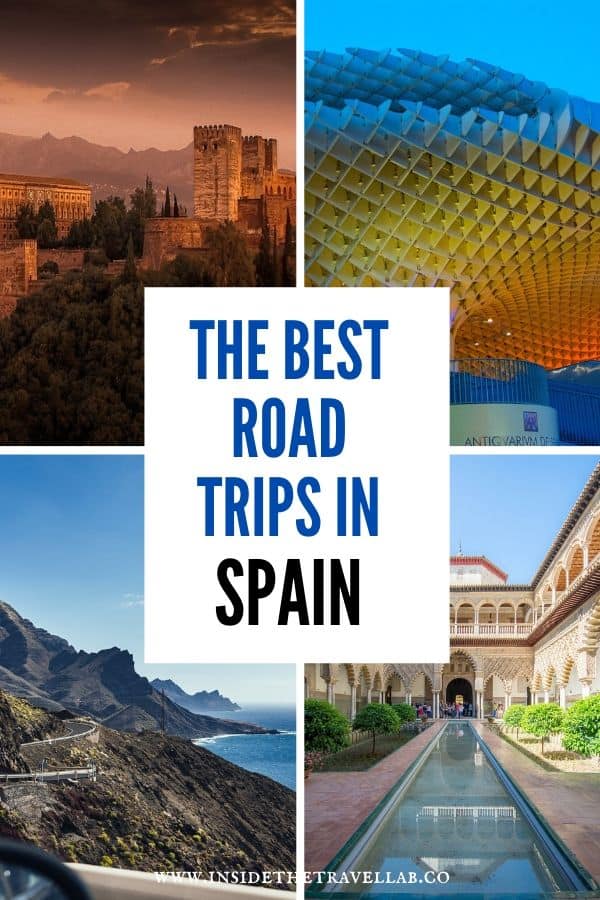
Table of Contents
THE BEST ROAD TRIPS IN SPAIN
If walking is one of the best ways to see a city, then driving is one of the best ways to see a country. Driving in Spain has brought me deep, deep joy, rising through the red dust of Andalusia and plunging through the deep green of Galicia.
You can find the separate road trip itineraries through Spain dotted throughout the article, but this article focuses on the best road trips in Spain.
- Download your free road trip essentials list and road trip packing list.
- Download the road trip planner and toolkit here.
Recommended
I love sharing the best travel resources I can find.
- I never book a flight without looking on Skyscanner first
- My favourite one stop shop for airport transfers, food tours & excursions is Get Your Guide
- Out of the big accommodation machines, I use Expedia and Booking.com the most
- I’ve hand-picked useful travel gear and tools for you in my Amazon shop . Never leave home without a travel adapter or collapsible water bottle . I’d also recommend these soft ear plugs and a sleep mask .
- Access all our planners and budget spreadsheets in the Travel Toolbox ©
- Plan the perfect road trip with our Road Trip Planner & Toolkit ©
- Use these packing cubes to make life so much easier on the road.
- Save on mobile phone roaming charges with an eSIM from Airalo .
TRAVEL SPAIN BY CAR
We start with the ultimate Spain road trip itinerary, taking in the mainland for first time visitors. But don’t forget Spain’s islands, not to mention delving deeper into the regions to find a richer, more authentic experience when you have more time.
Whether you call it fly-drive, self drive or want someone else to help you travel Spain by car, this is the collection of the best road trips in Spain.
Happy planning!
The Ultimate Spain Road Trip Itinerary
If all you have is two weeks, then this is the best Spain road trip itinerary for you. This two week self-drive Spain itinerary brings you the highlights of the country at a reasonable, but not relaxed, pace.
However, I’d always advise that you take is slow if you can. It’s far more enjoyable to spend more time out of the car than in. With that in mind, check out some of the other regional road trip ideas below.
Of all the places in the world, Spain is disinclined to rush. People here like to take their time and savour the joys of everyday life. Racing to fit your busy schedule does not usually rank highly in that regard.
The Ultimate Spain Road Trip Itinerary At a Glance
- Day 1: Arrive Barcelona
- Day 2: Barcelona
- Day 3: Girona and the Pyrenees
- Day 4: Valencia
- Day 5: Valencia to Madrid
- Day 6: Madrid
- Day 7: Madrid to Toledo
- Day 8: Toledo to Granada
- Day 9: Granada and the Alhambra
- Day 10: Alpujarras Mountains
- Day 11: Seville via Cordoba
- Day 12: Seville
- Day 13: Cadiz via Doñana National Park
- Day 14: Malaga to fly home
Historical city centres in Spain were designed for pedestrians and, at a stretch, horses. They were not designed for cars! Be careful when following SatNav instructions into steep, old towns. You can find yourself unable to make some tight turns and then somehow need to reverse backwards down a narrow road. Stick to the main roads in town!
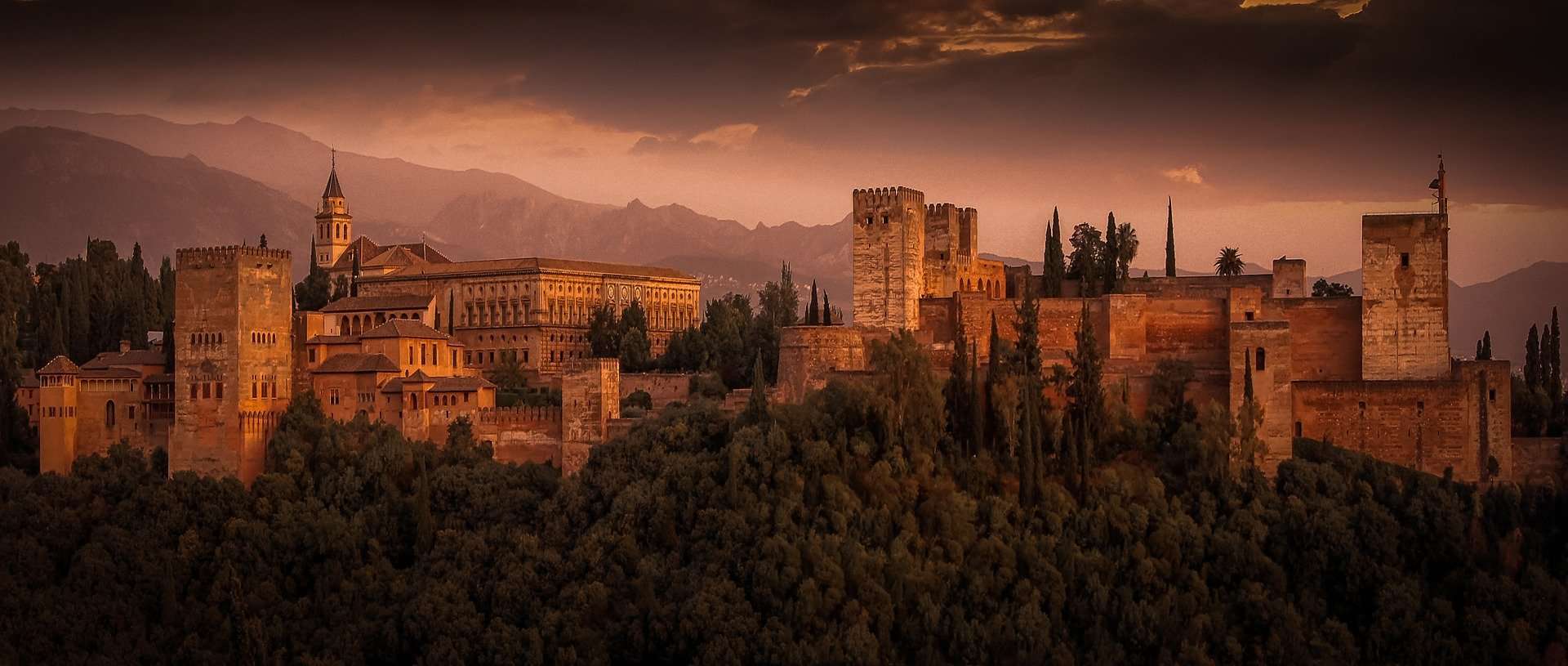
Southern Spain Road Trip Through Andalusia
A road trip through Andalusia, Spain’s biggest region, unsurprisingly covers a lot of ground. This passionate place is the home of flamenco, jamon and sherry, as well as staggering, world-renowned monuments.
You can easily fill two weeks with UNESCO World Heritage Sites like the Alhambra in Granada, the Real Alcazar in Seville and the unbeatable mosque turned cathedral in Cordoba.
But a self-drive road trip through Spain allows you to visit off the radar places and explore local traditions like joining the olive oil harvest in the mountains. From the beaches to the snowy peaks of the Sierra Nevada, driving through Andalusia really is one of the best road trips in Spain.
Andalusia Road Trip Itinerary At a Glance
- Day 1: Arrive Malaga.
- Day 2: Drive to Cadiz
- Day 3: Cadiz to Seville via Doñana National Park
- Day 4: Seville
- Day 5: Seville to Granada via Cordoba
- Day 6: Granada & Alpujarras Mountains
- Day 7: Back to Malaga to fly home. Find the complete southern Spain road trip itinerary here.
- Malaga is the biggest international airport but you can also fly into Seville and Granada with relative ease.
How about the Madrid to Seville drive?
With so many international flights arriving in Madrid, you may be wondering whether or not you should drive from Madrid to Seville or take the train instead.
A Madrid-Seville Road Trip can pass through many off the beaten path destinations, like Zafra and Merida, but in my opinion, it’s not one of Spain’s best road trips.
If you are short on time, I’d highly recommend taking the extremely fast and efficient Madrid-Seville train and then picking up your rental car in Seville to tour Andalusia.
It’s also possible to drive from Madrid to Granada by car, swerving up and down the Alpujarras Mountains, but again, I’d suggest picking up your wheels in Andalusia instead.
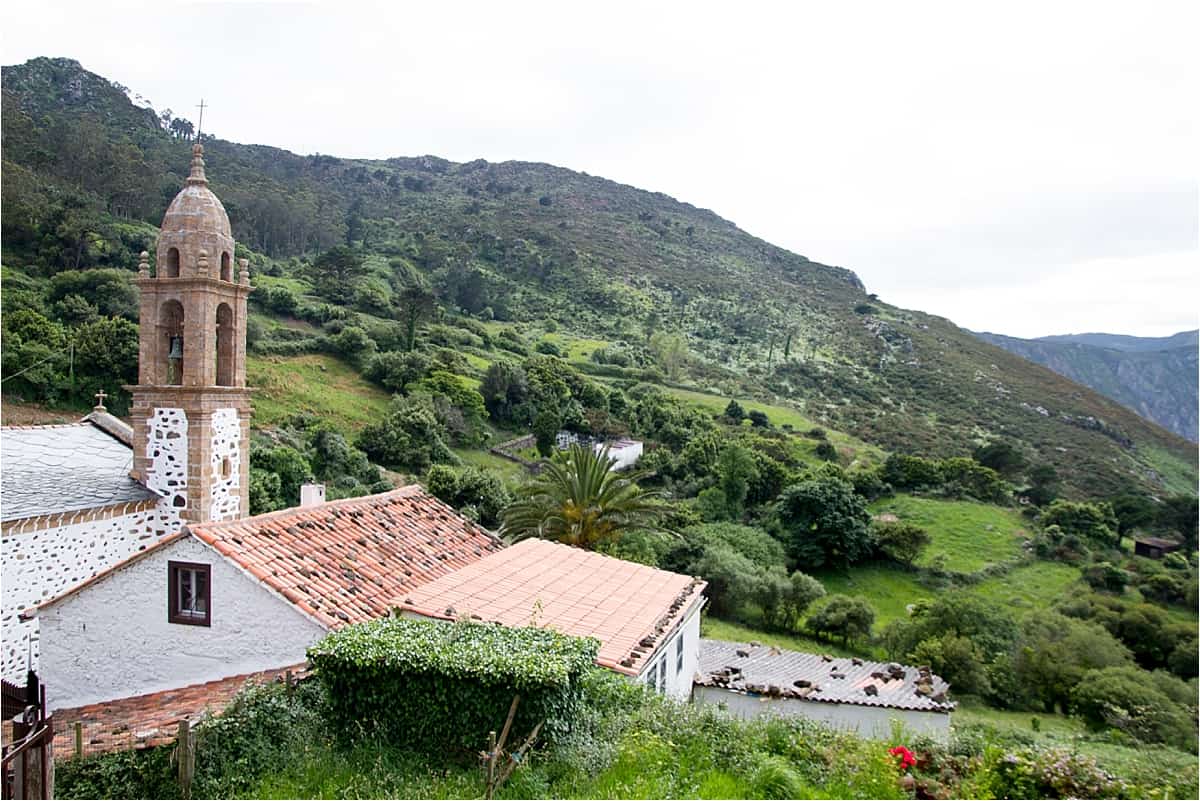
The Sanctuary of Dismembered Wax Body Parts
Northern Spain Road Trip Itinerary
Prepare to be surprised when you find out what makes this one of the best road trips in Spain.
The northern area of Spain swaps dry plains for rocky coves, and bull rings for lighthouses and salt marshes amid the green. Famed for its seafood and as the finishing point for the Santiago de Compostela pilgrimage route, this northern Spain road trip itinerary will show you a different side of the country.
- Want more detail? Explore this Galicia road trip itinerary.
Northern Spain Road Trip Itinerary At a Glance
- Day 1: Arrive San Sebastian
- Day 2: San Sebastian to Bilbao
- Day 3: Bilbao to Aviles
- Day 4: Aviles to A Coruña
- Day 5: A Coruña to Santiago de Compostela
- Day 6: Santiago de Compostela to Vigo
- Day 7: Back to San Sebastian to fly home
Recommended reading: Road Trip Galicia, Spain; The Undiscovered Northern Coast
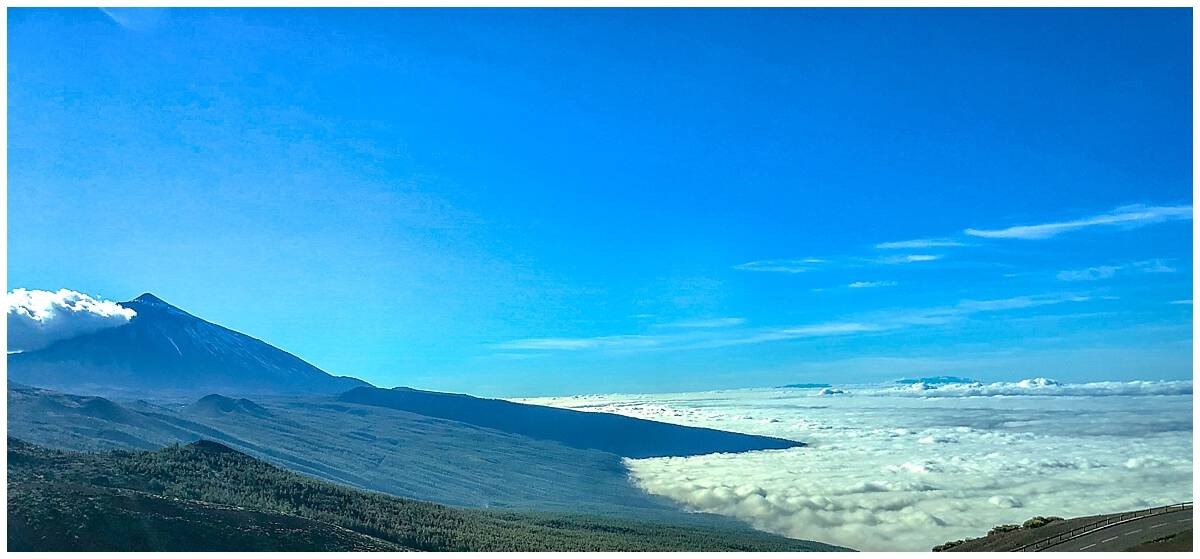
View above the clouds on El Teide in Tenerife
Road Trip Through Tenerife (Canary Islands)
As the largest Canary Island off the northwest coast of Africa, Tenerife is famous for its fly and flop beach holidays. But there are so many unusual things to do in Tenerife , from UNESCO World Heritage cities like Laguna to primitive biosphere reserves in Anaga. It’s a hiking paradise and if tight turns and steep roads don’t phase you, a great wild landscape awaits.
Driving through Spain takes on new and heady heights when you’re bounding over black volcanic stones and watching the clouds appear beneath you. This is one of the best road trips in Spain because it is also one of the most beautiful.
It’s also easy to combine with staying in one place and organising a series of day trips around the island. So if packing and unpacking on a road trip becomes a chore for you, try this instead.
Road Trip Through Tenerife at a Glance
- Day 1: Arrive and stay in UNESCO World Heritage La Laguna
- Day 2: Drive El Teide Volcano
- Day 3: Los Gigantes for a whale watching excursion
- Day 4: Hiking in Anaga National Park
- Day 5: Orotava, Icod de los Vinos and Garachico
- Day 6: Pyramids of Guimar
- Day 7: Explore La Laguna and fly home

Casa Mila: worth it on any Barcelona itinerary
Road Trip Through Catalonia (Catalunya)
Barcelona is the most famous part of Catalunya but to see more of the Catalan character, get behind the wheel and enjoy one of the best road trips in Spain.
Travel by car in Spain to discover the curious city of Girona, the sandy coast of Costa Brava and the smoky peaks of the Pyrenees.
Costa Brava offers volcanoes, sleepy coves and some of the best restaurants in the world. That’s not a boast. That’s actually a validated claim (read more about that here. )
You’ll also find flamboyant artwork from local household name Salvador Dalí, a great spot for a hot air balloon ride and a renewed appreciation for the difference between Catalan and Castilian Spanish.
- How to spend three days in Barcelona, an inside guide
- Unusual things to do in Barcelona
Road Trip from Barcelona At a Glance
- Day 3: Barcelona to Girona
- Day 4: Figueres and Cadaques
- Day 5: Garrotxa Natural Park
- Day 6: Tarragona
- Day 7: Return Barcelona to fly home
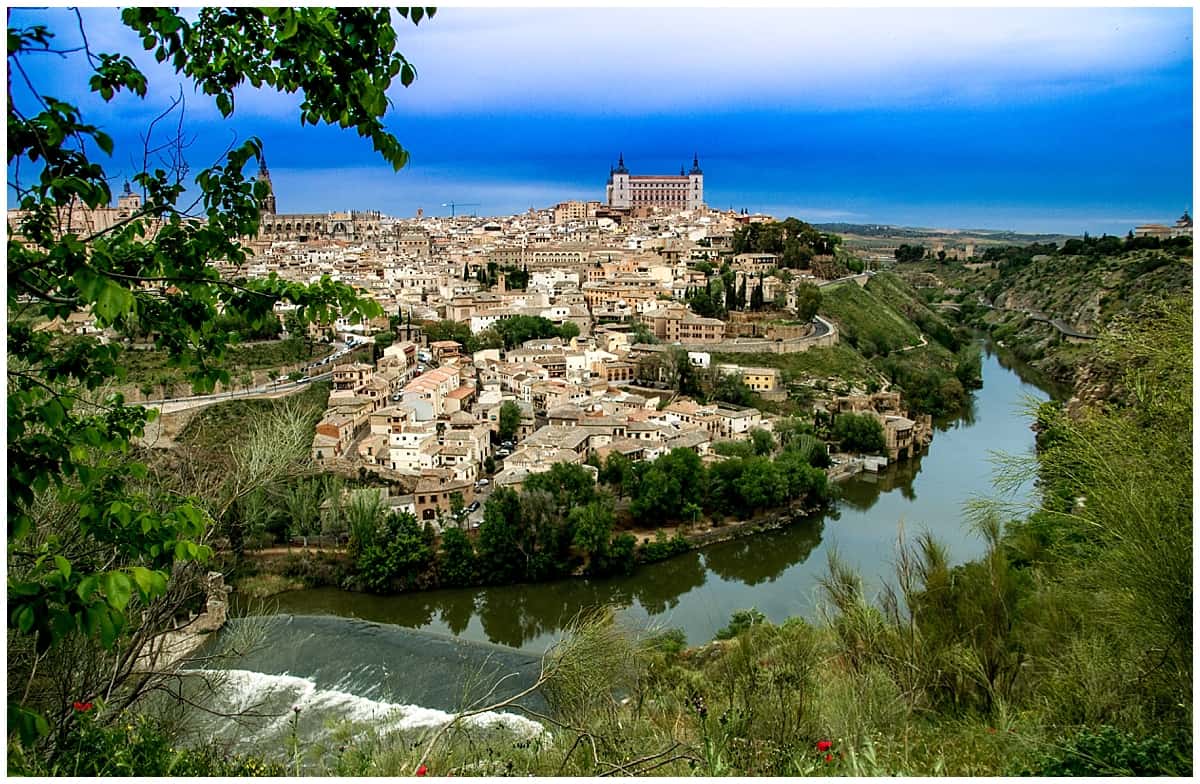
Road Trip Through Central Spain
Treat yourself to a literary, gastronomic and thoroughly authentic journey through this central part of Spain, the region of Castilla La Mancha. It’s one of the best road trips in Spain for hidden gems and a sense of exploration.
Take in Toledo, the former capital and UNESCO World Heritage Site. Search the hills for the windmills made famous by Don Quixote. Hike through one of the best bird reserves in the country. And relish taking your time amid small Spanish villages, far from the crowds.
Road Trip Through Central Spain at a Glance
- Day 1: Arrive Madrid
- Day 2: Madrid
- Day 3: Madrid to Toledo
- Day 4: Toledo
- Day 5: Don Quixote Countryside
- Day 6: Hike through the Tablas de Daimiel
- Day 7: Return Madrid to fly home
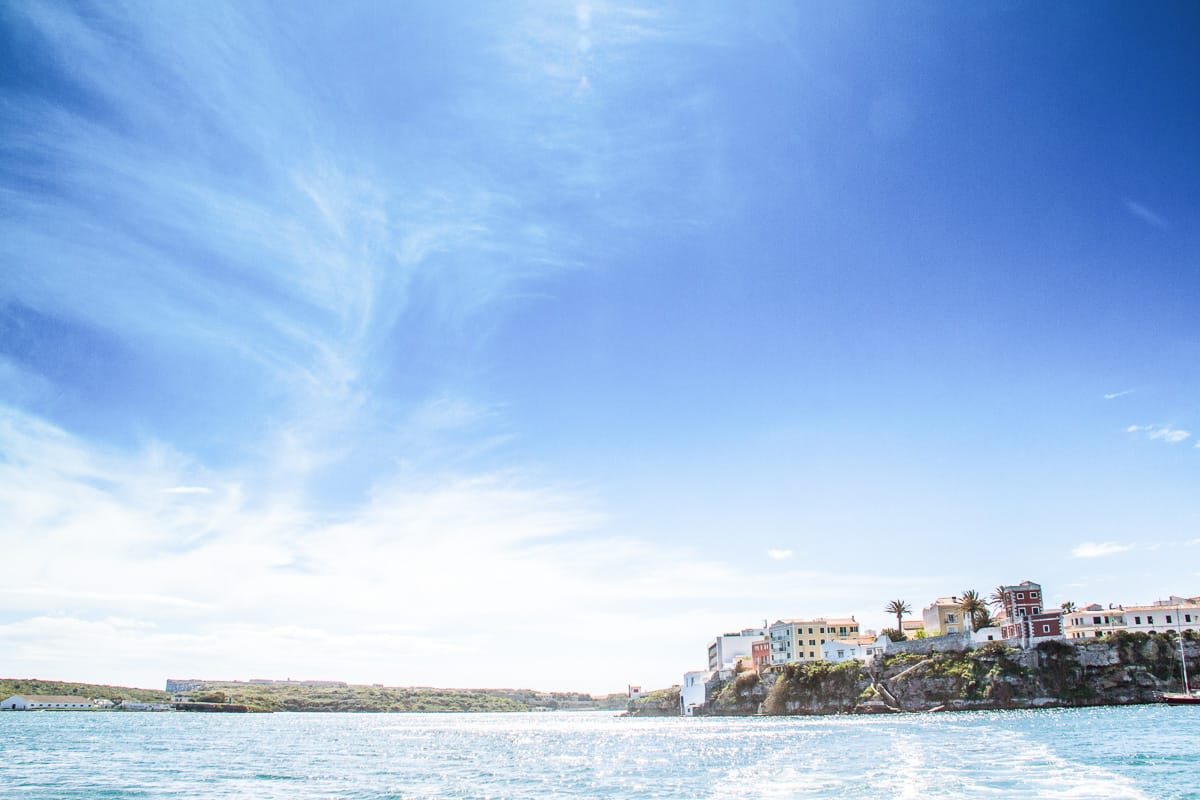
Both islands have stunning coastlines (but this place is Menorca!)
Driving the Balearic Islands
One of the best road trips in Spain involves flying to one of her smaller islands and taking a laid back approach to plans and itineraries all together. Mallorca and Menorca are the two main Balearic Islands and each has a distinctive character. Mallorca has party spots, UNESCO World Heritage and wild hiking routes. Menorca specialises more in family beaches, quiet streets, small towns and an awful lot of gin.
- Menorca or Mallorca for your Balearic Island holiday?
Set yourself up with one home base for a week and take a series of day trips to explore either island.
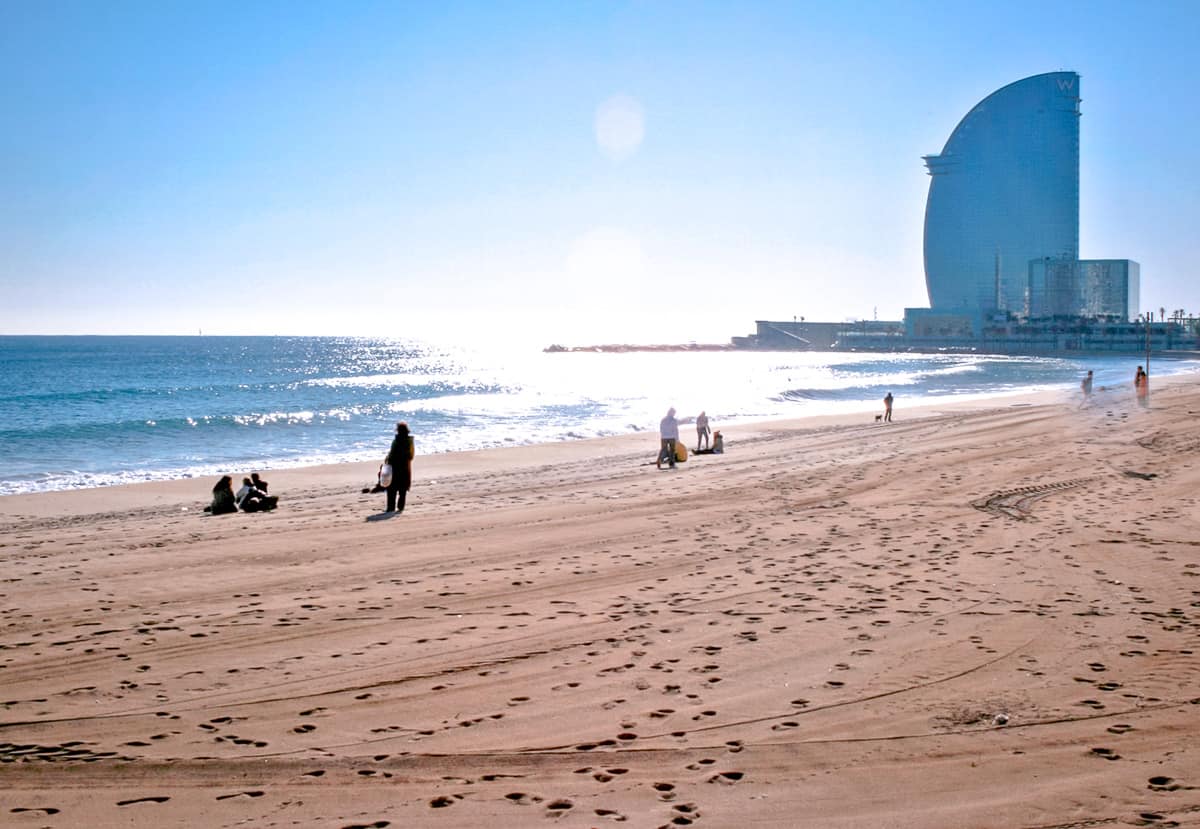
One of the best things about Barcelona is that it leads right onto a sandy beach…
Road Trip Along Spain’s East Mediterranean Coast
Drive from Barcelona to Valencia to experience two of Spain’s most interesting cities and her sparkling coastline as well. Find the Roman amphitheatre at Tarragona and the rice fields that gave us paella outside Valencia. If you have more than one week to ten days, continue south to the Moorish fortress in Amería as part of a road trip through Andalusia.
Road Trip Through the East Coast of Spain At a Glance
- Day 2: Barcelona and Girona
- Day 3: Valencia via Tarragona
- Day 5: Alicante and the Costa Blanca
- Day 6: Almeria and Cabo de Gata
- Day 7: Back to Barcelona to fly home (or to Malaga)
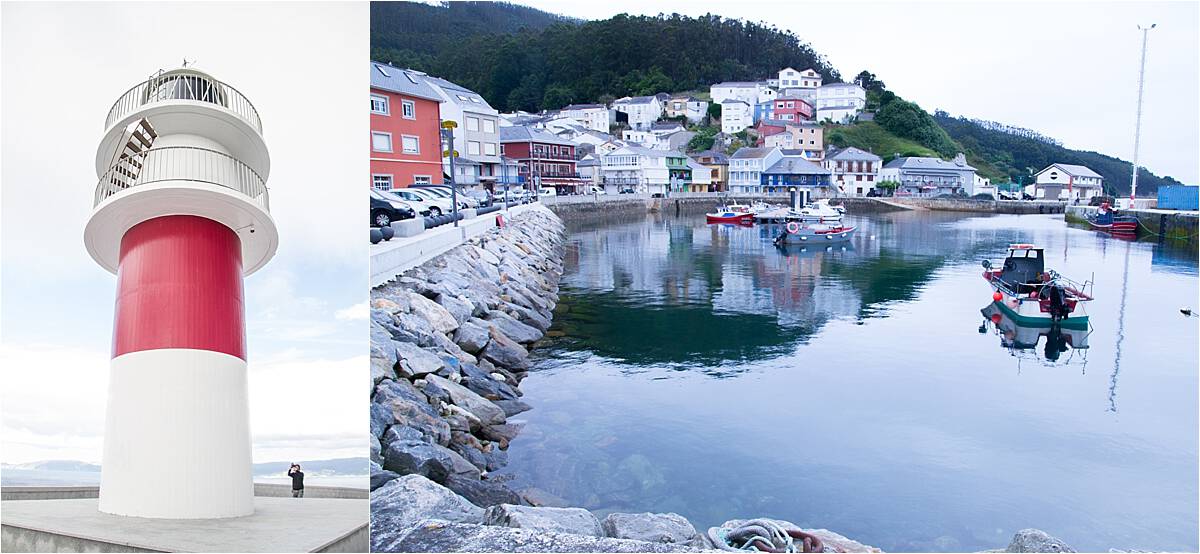
Road Trip Across Galicia
Decked out in deep green hues and bursting with salty seafood, a road trip through Galicia provides a completely different experience of Spain.
With a coastline more reminiscent of the rugged, craggy inlets of Ireland than the white sand of the south, it’s no surprise that Galicia offers seafood to make even the uncertain smile. Expect lighthouses, green fields, great walking routes and great food.
- A Galicia Road Trip: Northern Spain’s Rugged Green Coast
Road Trip Around Galicia at a Glance
- Day 1: Arrive La Coruña
- Day 2: Pontedeume and Redes
- Day 3: Porto do Barqueiro & Viveiro
- Day 4: Praia das Catedrais
- Day 5: Torre de Hercules Lighthouse & home

Road Trip Around the Basque Country
Link up San Sebastián, Bilbao and Santander for an epic road trip through Spain’s Basque country. Taste arguably the best food in the country in the pintxos bars in San Seb and take in the curls and swirls of the Guggenheim in Bilbao.
Add in secluded coastal curves and surprise museums, like the Balenciaga museum in Getaria , and you will find yourself with an unforgettable Spanish Road Trip.
Road Trip Through the Basque Country at a Glance
- Day 1: Arrive Bilbao
- Day 2: Bilbao
- Day 3: Bilbao to Logroño via Pamplona
- Day 4: Logroño to San Sebastian
- Day 5: San Sebastian
- Day 6: Hiking in Getaria
- Day 7: Back to Bilbao to fly home
What to know if you travel Spain by car
Cars drive on the right and you’ll need a full and valid driving license.
Tips for Spain Road Trip Itineraries
If you book through these links, we may earn a small commission at no extra cost to you. Cheers!
Typically, it’s best to pick up a vehicle at at the airport unless you have your heart set on exploring an historic city centre first. Bring your full driving license and book in advance. I’d highly recommend booking your car rental through Hertz.
Planning in Detail
I rely on the AA Route Planner to give me times and directions in Spain. Make sure you check for:
- Tolls (or factor them into your budget anyway)
What You Need to Drive in Spain
For a robust rundown of what you need to drive in Spain head to the Government website . From here you can check the latest recommendations and legal requirements, including information on an international driving permit.
Booking Hotels
Many smaller, boutique hotels in the centre of cities will not have parking options. It’s best to either park on the outskirts of town and walk in (in some places, such as Seville, taxis will struggle to get in as well) or if that’s too difficult for you then book a hotel on the outskirts of town and use their transport to travel in.
Highlights of Driving in Spain
Travel Spain by car and you’ll find all the following benefits.
While the big cities can get the pulse racing, for the most part, driving in Spain is a beautiful experience. Here are five reasons why:
1) THE ROADS ARE EMPTY
Outside the main cities that is. Gleaming wide main roads covered with smooth tarmac are the rule rather than the exception. Drive from Granada to Seville or Segovia to Merida and you’ll hardly see another car for miles.
2) THE SCENERY IS STUNNING
Low swirling mist rising over olive groves, intense sunshine hugging the contours of rust-red rock. Sparkling coastlines and white-washed towns with church towers spiking out of scorched plains. The green cloaked mountains of Galicia, the almond-scented mountains of Alpujarras and the Catalan curves of the eastern Pyrenees. Unlike driving in some countries, these views are visible from the windscreen of the car – you don’t have to wait until you park and get away from the roads.
3) GIANT BULLS ON THE HORIZON
Not real ones, of course. But building-sized, black, one-dimensional bull cutouts. Apparently, these first appeared as part of an advertising campaign for sherry. They were due to be removed until people clamoured for them to stay. Now, they add to the fun, as you never quite know when the next one will appear.
4) FRESH TAPAS AT SERVICE STATIONS
Forget about crisps, biscuits and overpriced coffee. Most petrol stations along the road in Spain are family run affairs with a chef on site. Coffee costs less than a euro while a plateful of patatas bravas, chocos, gambas or more is only a few minutes away. And if you’re feeling too hot? Try refreshing gazpacho instead.
5) FREEDOM AND GETTING OFF THE BEATEN TRACK
For reasons I’ll never quite understand, Spain has a reputation as a sand-and-sea destination and that’s about it. Visitors tend to cling to the coast and never realise just what they’re missing. Hiring a car and hitting the roads is the first step towards fixing that. Stop off in one of Andalucia’s pueblos blancos, for example, and you’ll probably be the only foreigner in town.
And that’s just for starters.
What is the best way to travel across Spain? Road trip or by train?
Great question. And the answer is: it depends.
Driving through Spain is an absolute joy, once you are out of the cities. Road tripping through Spain allows you to reach hidden villages and hike through unspoilt landscapes. It also makes life much easier if you are travelling with your children.
If you mainly wish to city hop between the big cities like Madrid, Barcelona and Seville, then the train is the better option. If you want to get off the beaten track and explore, go for a road trip.
Tools & Planners for the Best Road Trips in Spain
You’re in road trip heaven here, as we have everything from a full list of road trip essentials to the Ultimate Road Trip Planner for people who love freedom and hate spreadsheets.
And just for fun, we have the best road trip quotes and some road trip questions and games to help everyone get along.
Also, check out our road trip planning series on YouTube:
- The 5 biggest road trip planning mistakes people make (and how to fix them)
- The 7 best road trip planning tools.
1 thought on “The Best Road Trips in Spain and Their Self-Drive Itineraries”
The scenery is stunning indeed. I didn’t have to go driving to notice that. It’s wonderful!
Comments are closed.

Driving in Spain
Driving in spain – be safe be legal.
Spain is generally a very safe country to drive around as long as you follow some simple rules. The country has moved well into the modern era and so have the driving laws, recent legislation has now made some driving offences criminal rather than civil and therefore the consequences can be much more serious than a simple fine.
Our checklist will hopefully help you understand what you need to do to enjoy a safe secure driving experience in Spain.
Driving in Spain Checklist
What you will need to carry with you or in your vehicle to be able to legally drive in Spain.
1. Full and valid driving licence - ( permiso de conducir ) or a valid EEC driving licence.
2. Insurance documents - ( Poliza de Seguro ).
3. Identification - Some form of identification such as your passport, national ID or residence permit ( permiso de residencia ).
4. Vehicle Registration Documents ( Vc5 if you're British ) and if the vehicle is Spanish registered ( ficha tecnica and the permiso de circulacion ).
5. Warning Triangle
6. Reflective Jacket/s
7. GB Sticker if you do not have a EU symbol on your number plates
8. Headlamp beam deflectors
Stay On The Right Side Of The Law
Always carry the following documents in your vehicle when driving in Spain.
» Your driving licence - ( permiso de conducir ) or a valid EEC driving licence.
» Insurance documents - ( Poliza de Seguro ).
» Identification - Some form of identification such as your passport or residence permit ( permiso de residencia ).
» Vehicle Registration Documents ( V5 if your British ) and if the vehicle is Spanish registered ( ficha tecnica and the permiso de circulacion ).
Definite Don'ts
Drive carefully and you will probably never come into contact with any of the law enforcement agencies patrolling the roads in Spain, however here is a reminder of the definite don’ts.
- Do not drive under the influence of drugs or drink. Penalties here can range from fines, community service, prison sentences and loss of driving licence.
- Children up to 12 years old should be seated in the rear of the vehicle and children up to the age of 3 must be seated in an approved child seat again in the rear of the vehicle.
- Mobile Phones are a definite no-no with police strictly enforcing this law, only true hands-free units may be used, and speakers may not be attached to the driver's ears. You are not allowed to use audio earphones or headsets except for
- You don’t need to worry about buying a breathalyser kit for driving in Spain, but you should make a note of the more stringent drink-drive limits. The blood alcohol limit in Spain is 0.05 per cent and even lower for drivers with less than three years of experience, currently just 0.01 per cent.
- Blue tooth devices, music players etc are also prohibited.
- Drivers are not allowed to use DVD players, videos or internet screens.
- You are not allowed to use radar speed checking devices which can be part of or separate from GPS systems.
What Is The Alcohol Limit For Driving In Spain?
The Spanish authorities have really cracked down on drunk drivers with new laws being passed in 2014, now many driving offences are classed as criminal ones rather than civil.
The blood alcohol limit in Spain was reduced to just 0.05 per cent, this limit is even lower for drivers with less than three years of experience which is now 0.01 per cent.
Enforcing the Laws!
There are two types of law enforcement agencies operating on Spain’s roads which you should be aware off when driving in Spain.
The local police ( Policia Local ) are responsible for maintaining order on a local scale in and around the municipal boundaries of each town or city. This force also deals with pretty crime and general low-level law enforcement along with other municipal duties.
The main police force you will encounter on open roads and motorways will be the more serious and well prepared Civil Guard ( Guardia Civil ) patrol units. Their vehicles are usually white with green bonnets which show there official coat of arms.
They use very well equipped vehicles, powerful bikes, 4 x 4s, helicopters and high powered speed boats to carry out their duties to the max.
Petrol – Fuel
There are a number of companies offering petrol, the main ones being:
There are also many petrol stations run by smaller independent companies so it's well worth shopping around as the price per litre can vary quite a lot.
In the busy areas, most petrol stations are open all night but will have limited personnel on duty, out of normal hours and for security reasons you will be required to pay for the fuel before filling up the car.
There are several fuels on offer in Spain with Diesel and Unleaded being the most popular.
The most used unleaded petrol is 95 Octane Gasolina ( Sin Plomo ) and the superior version, usually, 98 Octane Gasolina ( Sin Plomo ) both are distributed from the green pumps. Diesel fuel ( Gasoleo ) from the black pumps is 97 Octane Gasolina which has a lead replacement chemical for older vehicles. Diesel ( Gasoleo “A” ) is a cheaper lower quality diesel on offer for the owners of older engines so best not to use this on a modern diesel car.
Charger stations are becoming more popular although are not readily available in all areas. There are currently around 6.000 chargers in Spain which are far lower than in most EU countries. Luckily you can check your nearest car charger using websites such as Electromaps which offers users an easy-to-use interface.
Credit cards are widely accepted in all stations these days.
It is advisable to lock your doors when leaving the vehicle to fill up the tank and when you go to pay for the fuel as many vehicles have been reported stolen from the forecourts while the driver has left it unattended for a few minutes to pay their bill at the cashier's desk.
General Rules For Driving in Spain

EEC Country stickers showing where the vehicle has been registered are no longer required when driving in European Union countries.
H eadlamp converters are compulsory.
Lights: dipped headlights should be used in poor daytime visibility. Motorcycles must use dipped headlights during the day at all times.
The minimum age for driving, For holders of the full UK driving licence you are allowed to drive class B vehicles which are cars, bikes up to 75cc and light goods and vans up to 3500 Kilos in weight. If you wish to drive motorbikes over 75cc you will need to take the corresponding test either in Spain or abroad.
Motorcycle and moped ( 49cc) drivers and passengers must wear crash helmets.
Motor insurance : The vehicle must be insured for a minimum third-party cover, all other types of Insurance are freely available in Spain such as Fire, Theft, Fully Comprehensive, extended roadside assistance etc. Carrying a green card is no longer obligatory within the EEC.
A replacement bulb set is compulsory.
Seat belts are compulsory for front and rear seat occupants if fitted.
Snow chains If you are planning a trip up to one of the Spanish mountain resorts during the winter season then it is highly recommended to carry snow chains, if you do not have them the police can prevent you from continuing your journey if they feel the conditions are too hazardous.
Speed Limits and Road Types
As in other EEC countries, there are varying speed limits in Spain depending where on the type of road and the area you are driving in.
Carretera Locale or Via Urbana – Urban Driving, within built-up areas, towns, villages, cities etc. The normal speed limits here are 30 kms p/h although some stretches maybe 50 depending on the area, keep a good eye out for the signs which are clearly marked.
Autopista (motorway) – The Maximum speed is 120 kph (73 mph), this also applies to the toll roads ( Peajes ).
Autovia – dual carriageways which may or may not have a central reservation. Speed limits vary from 80 to 110 kph, again these roads clearly mark the speed limits in each case.
Carretera Nacional – N or CN, main roads vary from 50 to 100 Mph.
Children and Passenger Safety
All children must be carried in a manner which ensures a maximum chance of survival in case of an accident or forced to make a sudden stop. All persons in vehicles up to nine seats must wear an approved seat belt and in the case of children, an approved seat specially designed for that purpose.
Babies up to 9 months old and up to 10kg should travel in a carrycot which must be laid across the back seat and secured with the car's safety belts or other approved safety attachments. From 10 to 13kg up to 2 years old should be sat in a child’s car seat fitted in the rear of the vehicle facing rearwards.
From 9kg to 18 kg or from 9 months to 3 years old a child’s seat facing forwards or rearwards may be used although it should be in the rear of the vehicle. From 15 to 25kg o up to 6 years old, a seat elevator can be used to lift up the child and travel more comfortably. From 22 to 36kg or 6 to 12 years old a combination of a seat elevator and the car's seat belts is acceptable. Children up to the age of 12 years old are not allowed to sit in the front seat.
Parking ( Estacionamiento/Aparcamiento )
As anyone knows who has visited and driven in Spain before, most of the typical Spanish villages were never built to handle the high and sometimes disproportionate amount of traffic that exists on Spain roads today.
In some cases it will never be easy, however here are some good pointers to watch for.
If you plan to visit small villages where dead-end streets or very narrow ones are commonplace, it is well-advised to park on the outskirts and walk into the town's centre.
Whenever possible parking should be in the same direction as the traffic flow in one-way streets or on the right-hand side of roads with two-way traffic.
In some areas, parking is permitted on one side of the street for the first half of the month (blue and red parking restriction signs marked 1-15 ) and on the other side for the second half of the month (signs are marked 16-31 ).
Always try to park in a correct and tidy manner, leaving two wheels mounted on the kerb infuriates pedestrians, irritates the locals and could get your vehicle towed away for good measure.
Resident parking areas can be found around Spain and are marked with black bands on street lighting posts or telephone posts. Residents may park here by obtaining a parking card from the local town hall ( you will need proof of residence for this ) and display it on their windscreen.
Some towns have zones where parking is regulated during working hours ( horas laborables ), when you need a permit covering the period you intend to stay.
Most Spanish towns and city centres now have blue zones (zonas azules), indicated by blue street markings, to park here you will need to pay for a ticket which is paid via the blue ticket machines which can be located throughout the blue zone area.
Parking usually has to be paid for from 9 or 9.30 am until 2 pm and from around 4 pm until 9 pm, Mondays to Fridays, and from 9.30 am until 2 pm on Saturdays. Parking is free on Sundays and public holidays.
Parking costs are approximately 70 cents to 1 Euro per hour, depending on the town. You can usually park from 30 minutes up to a maximum period of two hours.
Once the ticket has been purchased be sure that is correctly displayed behind your windscreen where it can be easily seen by the parking attendant.
If you exceed your time limit and find a parking ticket with a small envelope placed on your windscreen you can in many cases cancel it out immediately by paying a small penalty of 3 Euros. This is done by purchasing another ticket from the machine for 3 Euros, then placing the new ticket in the small envelope provided with the parking fine and then posting it in a special slot at the bottom of the ticket machine or by giving it to the parking attendant. This must be done within a limited period, usually 24 hours, otherwise, you will be liable for a fine of up to 40 Euros or more.
Some towns operate a monthly card system costing around 15 Euros a month.
Towns and cities are creating more parking areas, mostly in the form of underground or multi-story car parks, although at the moment the number of places available is still insufficient.
Parking rates vary considerably and are usually from around 1 Euro an hour.
Spaces available in a multi-storey or underground car park (aparcamiento subterráneo) are indicated by a FREE ( libre ) sign at the entrance, while COMPLETO indicates that it’s full.
Hiring a Car Hire in Spain
To hire a car in Spain you will need a valid driving licence recognised within the EEC, rental companies will also place age limits on people wishing to hire cars with them, usually between 21 and 70, it is best to check with the rental company their policy before hiring a vehicle.
Whether you pre-book the car hire online or directly from a supplier in the country the following rules and checks should be made BEFORE driving in Spain.
Make sure the car hire cost covers the insurance you are paying for. i.e. fully comprehensive with or without excess or a waiver which will exclude any general excess payments should you be responsible for the accident.
Ask if the insurance covers things like mirrors, wheels, windows, etc.
Full roadside assistance should also be standard and most policies in Spain nowadays is provided in English by the insurer, make sure you have a standard EEC-compliant road accident form in English.

See our quick guide on how to save money when hiring a car in Spain .
What Items Should Be In Your Car Hire Vehicle
Check in the vehicle for the following items which should be carried at all times before driving in Spain.
» The Insurance documents. » The Rental contract » At least one reflective jacket. » 2 approved breakdown triangles
Is Your Vehicle Insured In Spain?
Before setting off on your journey it is strongly advisable to check the level of insurance cover you have for your vehicle and its passengers whilst driving in Spain.
Make sure you understand the level of cover when it comes to third-party liability, fire, theft, and fully comprehensive. Also, does it cover you fully to drive within the EU for the duration of your visit?
Roadside Breakdown Assistance
For UK-registered vehicles insured via UK-based roadside assistance companies, it is advisable to contact them before driving within the EU. Most UK companies will limit the amount of time you are covered during any one visit to Spain, usually around 90 days maximum.
It is also advisable to check the level of cover, for example, will it cover the cost of repatriation of a damaged vehicle and you and your family members.
If you have UK-based cover make sure you carry the current contact numbers and emails should you need urgent assistance?
Driving In Spain After Brexit
In the case of a No-Deal between the EU and the UK then you may be required to carry the old-style IDP - International Driving Permit. Check the RAC website for further details on the types of permits and how to apply for them.
Disclosure: Please note that some of the links included in the above content may be affiliate links. We may earn a commission if you make a purchase at no extra cost to you. Rest assured, we only recommend products and services that we personally use or have used and are happy to recommend. Any commission we earn helps toward the site's running costs.

Travel Smarter - Not Harder
Download free e-guides and travel tips.
Start your Journey today and get access to exclusive FREE content.
Username or Email Address
Remember Me
- WHY VISIT SPAIN?
- TRAVELLING TO SPAIN
- SPAIN ON A BUDGET
- TRAVEL REQUIREMENTS – ETIAS
- SPAIN ENTRY REQUIREMENTS
- SPANISH CUISINE
- SPANISH FOOD
- HOLIDAY IDEAS
- PUBLIC HOLIDAYS
- TOURISM BOARDS
- AIRPORT GUIDE
- DRIVING IN SPAIN
- WEATHER IN SPAIN
- FREE WEB CAMS
- BEST BEACHES SPAIN
- FESTIVALS & FIESTAS
- MUSEUMS IN SPAIN
- CAMPING IN SPAIN
- MARINAS IN SPAIN
- SKIING IN SPAIN
- WATER PARKS
- UNESCO WORLD HERITAGE SITES
- 80 BEST ATTRACTIONS
- 71 BEST PLACES TO VISIT
- REGIONS OF SPAIN
- COSTA DEL SOL
- CANARY ISLANDS
- SAN SEBASTIAN
- Complete List:
- SAGRADA FAMILIA BARCELONA
- BARCELONA FC STADIUM TOUR
- BARCELONA FLAMENCO SHOW
- SEVILLE FLAMENCO SHOW
- SEVILLE CATHEDRAL
- GAUDI`S CASA BATLLO
- THE ALHAMBRA GRANADA
- SANTIAGO CATHEDRAL
- CITY OF ARTS & SCIENCE VALENCIA
- MOSQUE-CATHEDRAL CORDOBA
- CAMINITO DEL REY
- PRADO MUSEUM MADRID
- REINA SOFIA ART MUSEUM
- SCUBA DIVING
- BEST TAPAS TOURS
- BEST WINE TASTING TOURS
- TOUR GUIDES
- HOTELS IN SPAIN
- LUXURY HOTELS
- LUXURY BEACH HOTELS
- HOLIDAY RENTALS
- PARADOR HOTELS
- CHEAP FLIGHTS
- TRAVEL INSURANCE
- FREE TRAVEL BROCHURES
- WIN FREE HOLIDAYS

- Travel recommendations
- The taste of travel
- Tips & tricks
- Travel experiences

Renting a car and driving in Spain: the guide for your Spanish vacation

Whether you’re considering taking your car or renting a vehicle for your next trip to Spain, read on to find out all the requirements and get some useful tips for driving in Spain.
In this post
Requirements for driving in Spain
Renting a car in spain, rules of the road in spain, driving in spain – faqs.
Before you head off on your vacation or business trip in Spain, make sure you have examined all the rules and requirements for renting and driving a car.
Documents needed to drive in Spain
The minimum driving age in Spain is 18 years and you must have an International Driving Permit (IDP) as well as your valid US driving license with you at all times.
Car equipments
When renting a car and driving in Spain, check that your car is stocked with the following items:
- Warning triangle
- High-visibility jacket
- Spare bulbs for headlights and indicator lights
- Headlight beam deflectors
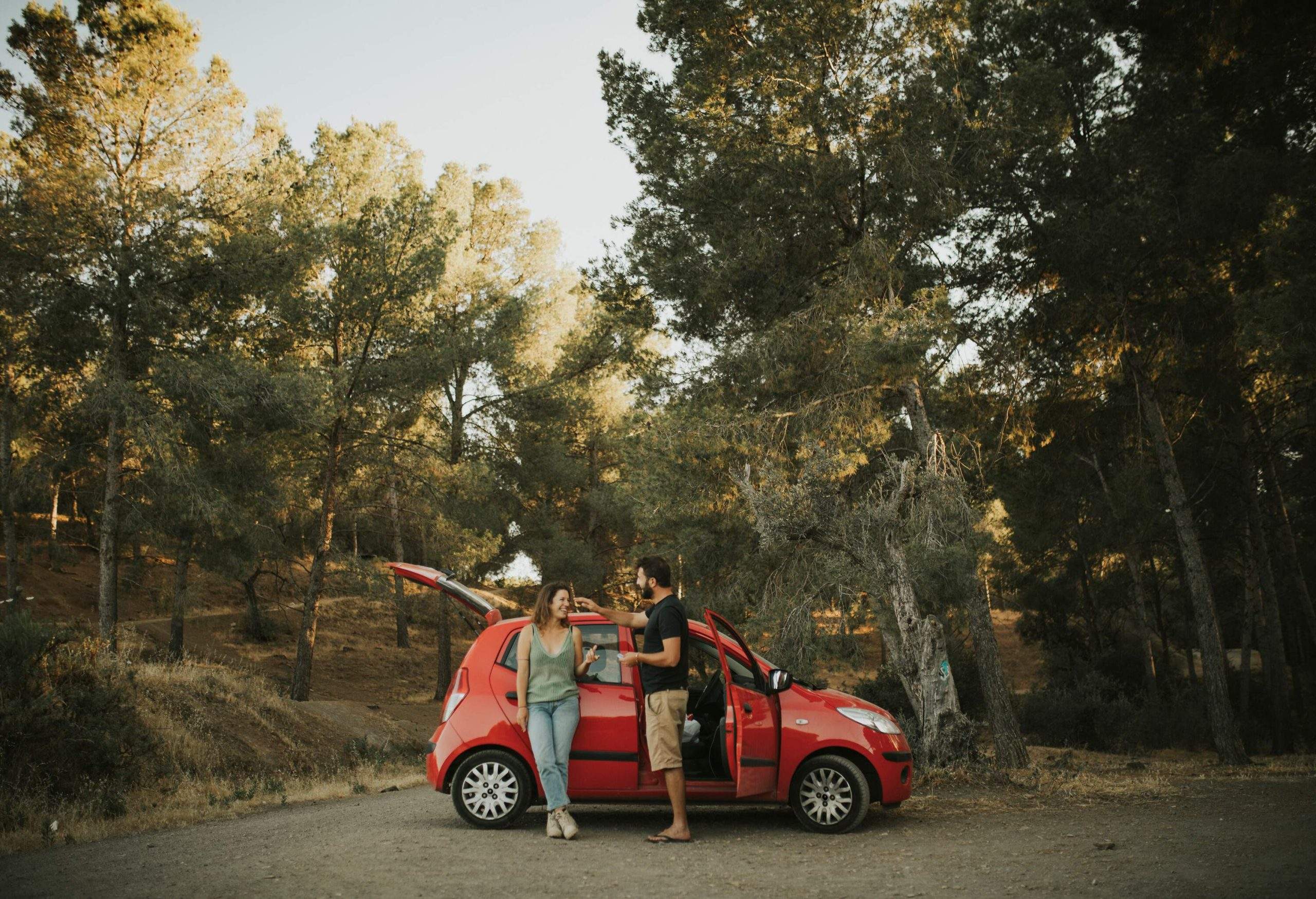
Read on to learn everything you need to know about renting a car in Spain and get some useful tips on things to look out for.
What do you need to rent a car in Spain?
While the minimum legal driving age in Spain is 18, most car rental companies require drivers to be at least 21 years of age before they consider renting them a car. In addition to meeting the age requirements, you will need to have a full valid driver’s license, and a valid passport. You will also need a credit card to pay for the car rental deposit, though a few car rental agencies will also accept debit cards. As a minimum requirement, you will also need to have third-party liability insurance in order to rent a car in Spain.
Tips for renting a car in Spain
When picking up your rental car , make sure you inspect it well and note down or photograph any existing marks and scratches . Then, when you return it, take some good photos of the inside and outside the car as proof of its condition upon return.
If you don’t have your own third-party insurance policy, make sure you double-check that insurance is included in the rental contract. If you do have third-party insurance, make sure that you’re not paying twice for the same coverage.
If you plan on crossing the border and driving into other countries, you must tell the agency beforehand as they need to ensure you have adequate insurance for all the locations you’ll be visiting. To avoid paying money for driving a few extra miles, make sure you try to negotiate unlimited mileage .
If you’ve been asked to return the car with a full tank, be sure to remember to check that it is also full when you pick it up. When you return the car, remember to stop at the closest gas station to the agency to refuel it.

Search for rental cars
Learn everything you have to know when driving in Spain, and enjoy your vacation.
Minimum driving age
The minimum legal driving age in Spain is 18 for cars, but you can drive mopeds from the age of 15 and 125cc motorcycles from the age of 16. As mentioned before, rental car agencies often have their own age requirements.
Speed limits
The speed limit in Spain is 50km/h (about 30mph) for cars and motorcycles driving on ordinary roads in built-up areas, while on motorways in more populated areas the speed limit is generally 80km/h (about 50mph).
When you go outside these areas, the limit on ordinary roads is 90km/h (about 55mph), while on roads that have more than one lane for each direction you can drive as fast as 100km/h (about 60mph). On motorways, the speed limit is 120km/h (about 75mph).
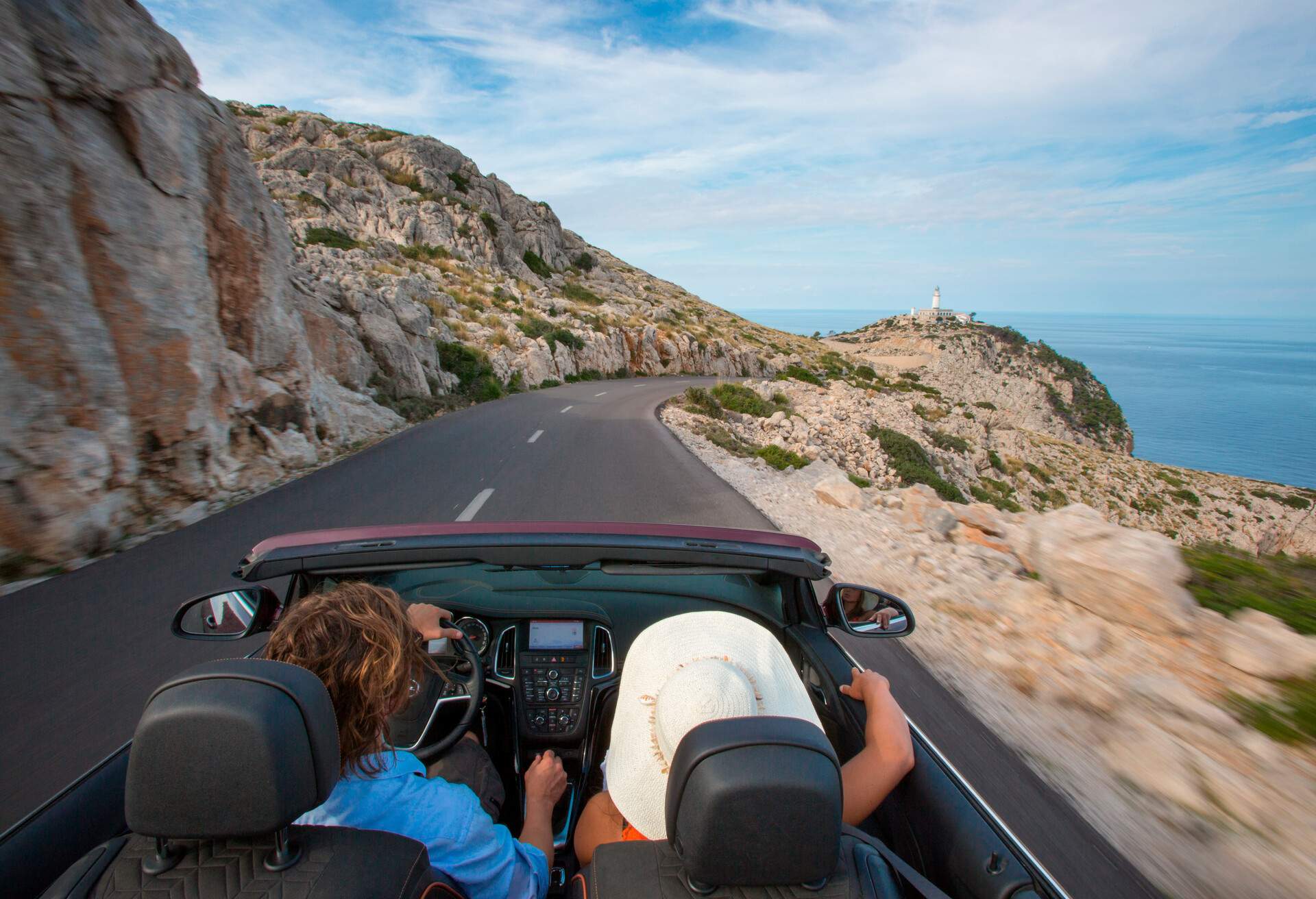
Highways & tolls
Only 20% of the highways in Spain have tolls. However, they are not distributed equally between the regions: about half of the toll roads are in Catalonia.
Tolls can be paid with cash or card. Usually, you’ll get a ticket when you get on the paid road. When you exit, you’ll go through another toll booth, where you can insert the ticket into the automated machine to have your fee calculated.
Priority & roundabouts
One key difference between driving in Spain and driving in post parts of the United States is the prevalence of roundabouts. When entering a roundabout, vehicles that are already on the roundabout have the right of way. You can only exit a roundabout from the outside lane.
If you are entering a roundabout with multiple lanes, you need to choose your lane according to where you’re planning on exiting, starting from the right-hand lane if you are taking the next exit, with the left lane for drivers who will be taking the last exit.

Alcohol allowance & drunk driving
For cyclists and drivers of private vehicles the limit for alcohol in the blood in Spain is 0.05%, which is lower than the US limit of 0.08%. There are some cases where the limit is even lower, sitting at 0.03% for drivers of vehicles carrying eight or more passengers, vehicles transporting goods, vehicles used to transport children, and public and emergency service vehicles.
In addition, the lower percentage applies to (young) drivers who have held their driving license for less than two years.
Car seats regulations for children
Children who measure less than 4.5ft (or 135cm) must travel in a car seat appropriate for their size. Children who measure over 4.5ft but are under 12 years of age are allowed to use normal seats.
Penalties & Fines
Speeding fines in Spain can range from €100 (about $108) to €600 (about $648) for more serious speeding offenses. Other reasons you might get fined include not having the right paperwork in your car, parking offenses, or using a mobile phone while driving. If your driving license states that you must wear glasses or contact lenses while driving, and you do not, you will be breaking the law and will be fined €200 (about $216).
It is possible to get fined on the spot by a police officer. You can pay for your fine immediately or later at the post office or by mail. If you pay within 20 days, you can often get the amount reduced by 50%.

In Spain you can usually pay with cash in euros or with credit and debit cards.
Paid parking spots are generally indicated by a blue zone and you will find a parking meter located within walking distance. You must purchase a ticket and display it clearly on your dashboard. Make sure you read the signpost to find out the maximum time allowed; usually the limit is one to two hours.
At some hours of the day, parking may be free, such as during siesta time or between 8pm and 8am. Other curb colors usually indicate residential car parks, and you are not allowed to park there unless you have a resident’s permit.
Disabled parking is available for those who have a permit issued by the municipality. Cars with the disabled permit can park in a wider range of spaces, such as loading zones for an unlimited time or pedestrian zones for a limited time.
When refueling your car in Spain, look for the words “gasolina sin plomo” if you are after unleaded gas, while diesel is called “gasóleo A”, and LPG is indicated by “autogas.” You can usually pay in cash or by card at most gas stations, and automatic gas pumps can be found in all major areas.

How KAYAK knows what to put in this guide
KAYAK prides itself in its ability to leverage its extensive expertise in all areas of travel. KAYAK’s team of seasoned writers has curated and fact-checked this content, ensuring it reflects the latest and most accurate information. KAYAK’s goal is to provide you with a reliable resource for all things travel—from insider tips to exclusive deals.
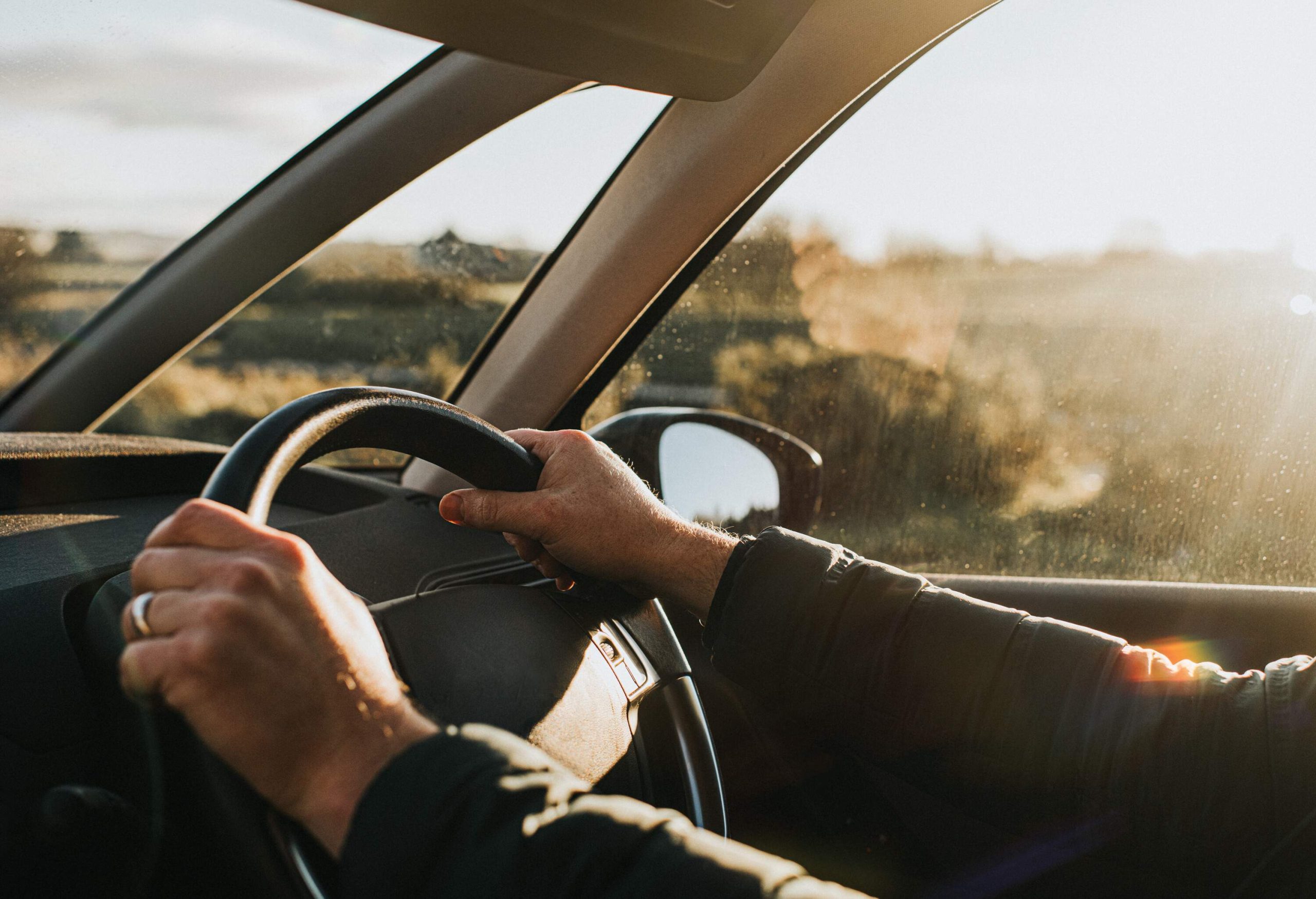
Popular car hire locations in Spain
Barcelona car rentals
Madrid car rentals
Palma de Mallorca car rentals
Málaga car rentals
Seville car rentals
Alicante car rentals
Valencia car rentals
Ibiza car rentals
Bilbao car rentals
Granadilla car rentals
Mahón car rentals
Santa Cruz de Tenerife car rentals
Las Palmas de Gran Canaria car rentals
Granada car rentals
Arrecife car rentals
Santiago de Compostela car rentals
Girona car rentals
Puerto del Rosario car rentals
San Sebastian car rentals
Marbella car rentals
About the author

Explore more articles
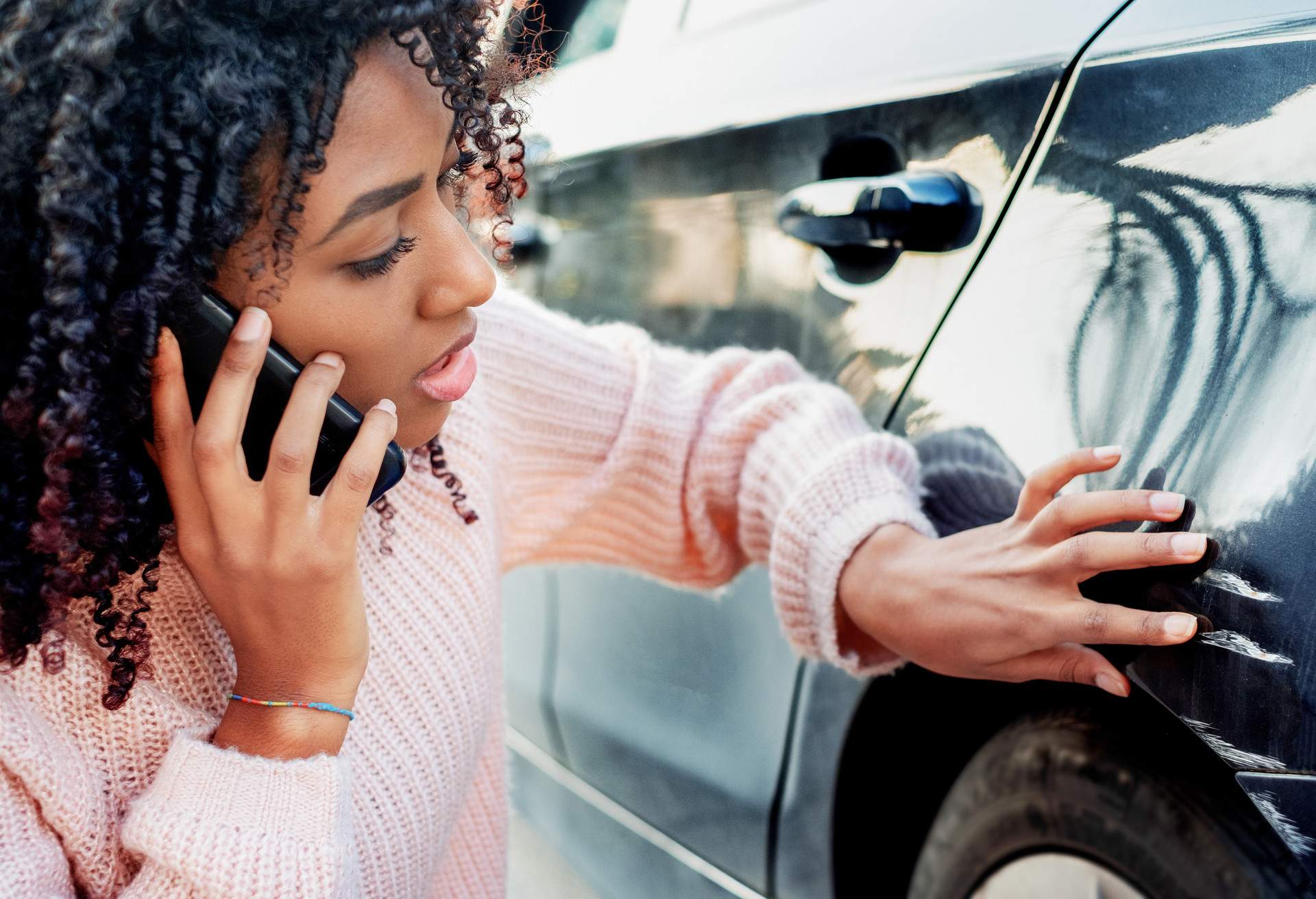
California consumers have the right to opt out of the sale * of their personal information. For more information on how we securely process personal information, please see our Privacy Policy .
Do not sell my info ON
* The definition of "sale" under the California Consumer Privacy Act is applicable only to California consumers.
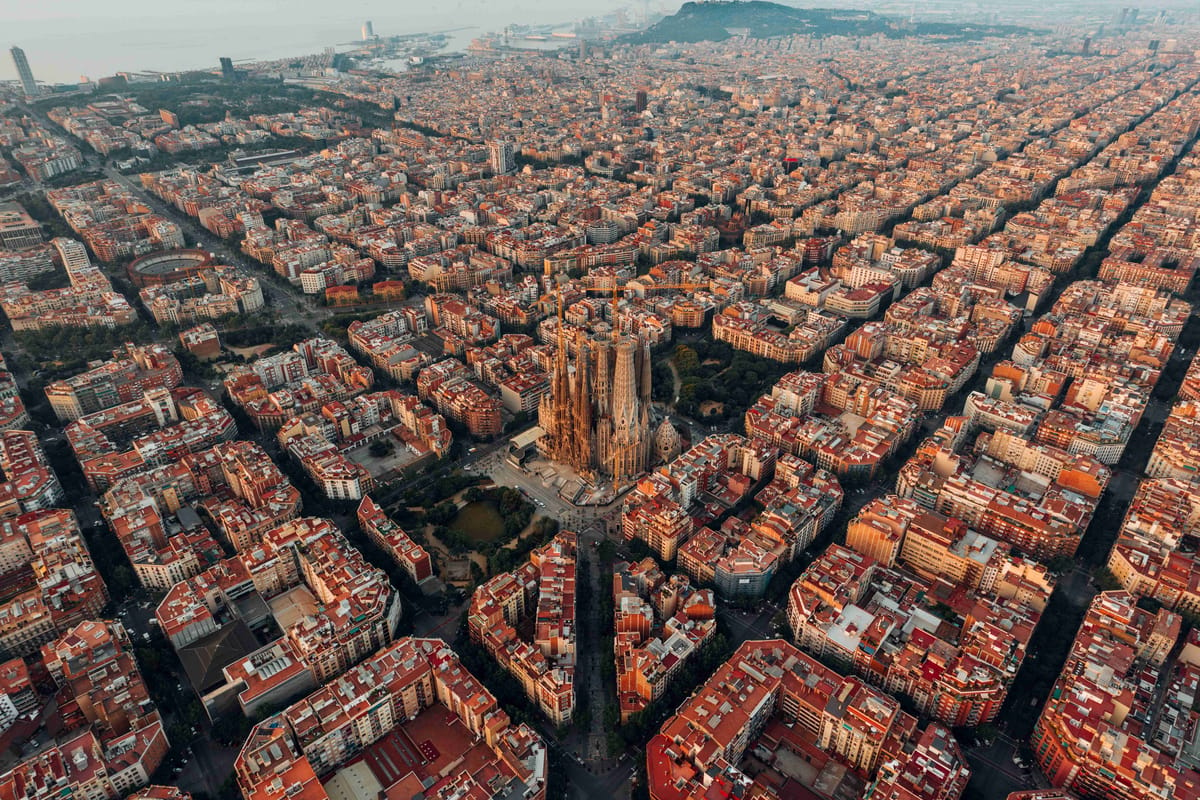
Spain Driving Guide
Explore Spain by driving with International Driving Permit
Driving in Spain for First Time Visitors
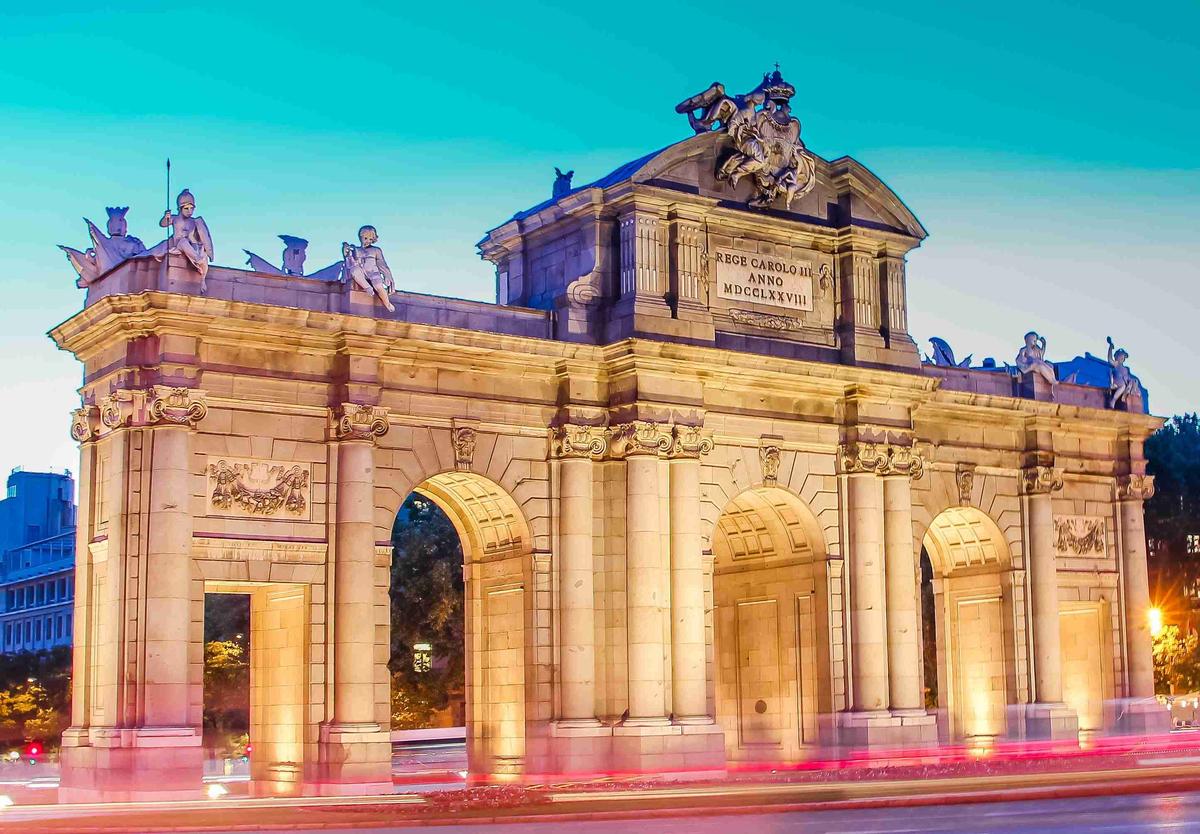
Dreaming of exploring the breathtaking landscapes of Spain at your own pace? Driving in the major city of Spain unveils the real magic of this diverse country, taking you beyond typical tourist routes and into the heart of Spanish culture.
Imagine cruising through rolling vineyards, historic Spanish cities, and along the stunning Mediterranean coast while graced with the flexibility to discover hidden gems at your whim.
If you're a first-time visitor, don't let the uncertainty of driving in a foreign country stop you. This guide will discuss everything you need to know about driving in Spain.
How can this guide help you?
This driving guide is designed to provide crucial information for your journey to Spain. The next sections offer valuable tips on essential aspects such as obtaining an International Driver’s Permit in Spain, navigating the car rental process, understanding driving etiquette, and observing local laws.
Whether you've already booked your flight or are in the early stages of planning, explore this guide to enhance your understanding and ensure a memorable and smooth travel experience.
Let's take a closer look at Spain
Geographic location.
Spain is geographically located in the southwestern part of Europe and proximally situated near the south of France and Andorra.
It is also adjacent to the bordering country in the east, which is Portugal. The country shares maritime borders with Italy and Algeria, and it also shares territorial rights in some parts of Morocco and some significant islands in the Mediterranean Sea.
Languages Spoken
The Spanish language has transformed into numerous dialects in many culturally diverse regions, contributing to the diversity the country celebrates. These dialects made each area distinctly unique in terms of its linguistic diversity, tone inflection, and overall intonation, such as the following:
Spain’s historical background shares some valuable insights into its diverse ethics. The monarchy's attempts to explore distant and inhabited areas, such as the Pacific and parts of Asia, played a significant role in uncovering uncharted territories.
As a result, the formation of Spain's constitutional monarchy contributed to a notable increase in socioeconomic stability.
Spain ranks number one in the 2019 World Economic Forum’s global ranking of countries best equipped to welcome tourists.
Considerably, the country’s tourism efforts have helped transform its tourist spots’ global competitiveness, making it one of the world’s leading travel destinations as of September 11, 2020. Also, it is noteworthy to indicate that the number of tourist arrivals has increased to 129.4 million as of 2017.
International Driving Permit FAQs
Do i need an international driver’s permit (idp) to drive in spain.
Yes, it is advisable to obtain an International Driver’s Permit in Spain along with your valid driver’s license. It serves as a translation of your license and is generally required for renting a car.
What if I get involved in an accident?
Actions to take in the event of a car accident in Spain depend on the severity of the situation. In general, promptly stop your car, assess injuries among passengers, wear a reflective jacket, activate hazard warning lights, and, if possible, document the scene with photos. Exchange information with other involved parties, call the police and emergency services.
Once local authorities arrive, complete an accident report for submission to your insurance company. If there's disagreement about the events, refrain from signing any documents until a resolution is reached. Notify your insurance provider within seven days, as delays may impact your claim. You have a two-month window to file charges against the other party.
How can the Spanish traffic map help you?
The traffic map offers a comprehensive view of the potential traffic congestion that may happen on a particular road. If you are driving in Spain, it is critical that you also learn what the traffic maps imply. To elaborate on this, the following are some of the essential things to remember
Traffic flow lines:
- Red lines indicate heavy traffic flow and congestion in an area
- Yellow/orange lines indicate medium flow
- Green signifies normal traffic
- Black lines or No traffic flow lines could point out that a particular road is closed. Also, it may indicate that there is not enough vehicle flow to register the road activity.
Is Spain using Kph or Mph?
In Spain, they measure speed using the unit of Kilometers per hour (Km/hr), consistent with the metric system adopted by most European countries. Adhering to maximum speed limits is crucial to avoid accidents, injuries, and fatalities. Following driving rules ensures safety on the road.
Is It safe to drive at night?
Renting a car in spain.
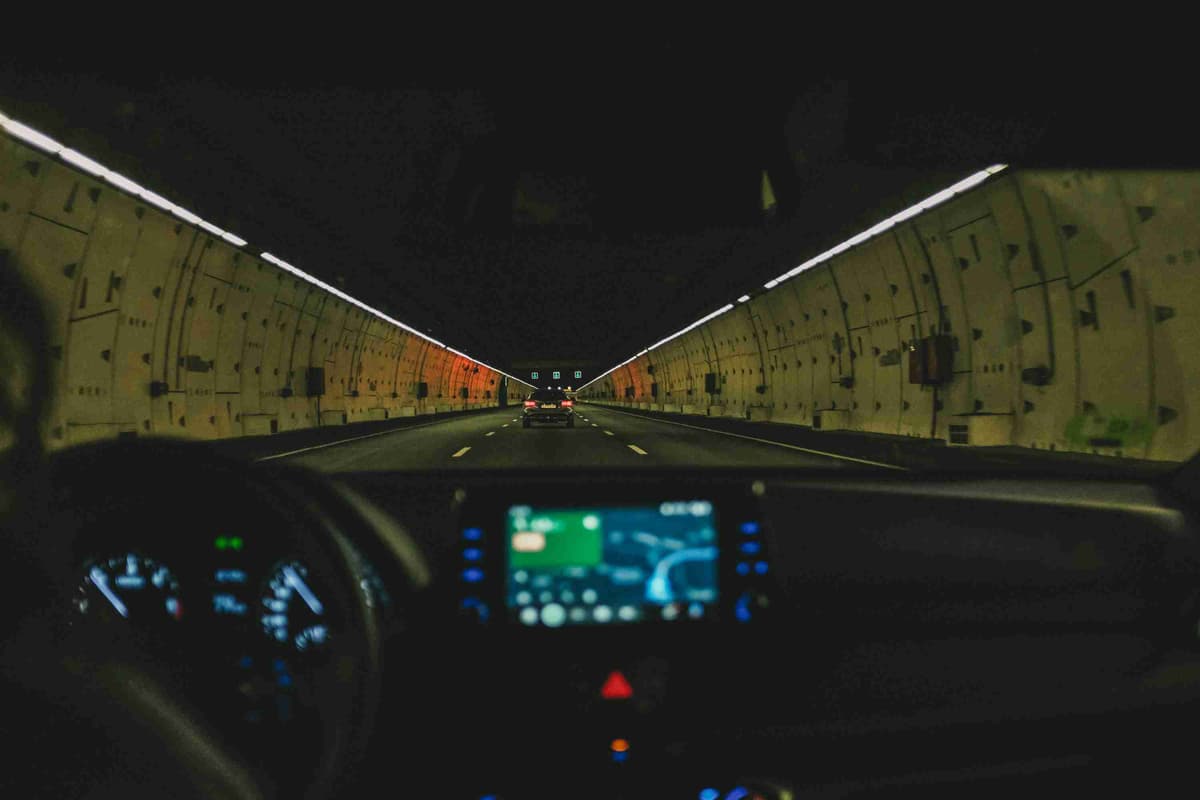
If you want to make the best out of your day trips to Spain, then driving through the outskirts is a great idea.
But before you go through the specifics of your planned activities, do you have a car already? If not, this section will help you navigate how car rentals are processed and how you can get your car insurance in case your rental agency requires it.
Car Rental Companies
A car rental agency can offer unparalleled advantages, affordable prices, and convenience for foreign travelers, especially in Spain.
Thus, you can find several car rental companies online. You can also book a reservation by contacting their main page online. To make it easier for you, here are some rental companies:
- All-In Car Hire
- Coys Rent A Car
- Centauro Car Hire
- Fetajo Rent a Car
- Helle Hollis Car Rental
- Libra Budget (Rent A Car)
- Malaga Airport Car Hire
- Malco Rent A Car
- OK Rent A Car
- Victoria Rent A Car
- Terry’s Car Hire
Get the best deal by booking in advance and comparing the rental companies’ rates and prices. Pay attention to the price of a car rental with unlimited mileage and insurance.
Last-minute rentals will cost you more and tend to be more inconvenient. Also, note that Spain charges a 15% tax on car rentals, so ask whether the price you see already covers that tax amount.
Documents Required
To rent a car in Spain, ensure you have the following:
- A valid European Union driver’s license with at least 12 months of validity in the Western alphabet.
- An identification document such as a passport or tax identification number.
Note: If you don’t possess a European Union driver’s license, obtain an International Driving Permit and include the driver’s name on the hire agreement.
Additionally:
- Have a credit or debit card for explicit coverage of rental and insurance expenses, with the full coverage fees varying among companies.
- Read the company’s policy to prevent discrepancies with transactions and comply with traffic laws.
- Inquire with the rental company representative about any other required vehicle registration documents before renting.
Vehicle Types
Consider your preferred vehicle type carefully, taking into account your needs and preferences. Prioritize selecting the right car size, especially for trips with friends or family. Spanish car rental companies, such as AutoEurope, offer a diverse range of options to meet various needs during long trips and vacations.
AutoEurope provides choices, including miniature and economy-sized vehicles for navigating narrow spaces in cities like Madrid. Additionally, they offer spacious SUVs and Sprinter vans, ideal for accommodating 6-7 people on family trips.
Car Rental Cost
The cost of renting a car in Spain varies based on the duration. On average, it's around $29 per day or $204 per week.
Comparing this to public transportation, where seat reservations typically range from $10 to $20, or $35 for solo trips in Spain, renting a car becomes a preferable option for tourists wanting to explore the country with long drives.
Most tourists visiting Spain opt for car rentals due to their cost-effectiveness and convenience. Choosing a rental car is advantageous, providing a cheaper and more convenient option for wandering tourists. With a car, you can skip long lines, and you have the freedom to decide your destinations!
Age Requirements
For car rentals in Spain, the minimum age is typically 21, but some companies set it at 23. There's no maximum age limit imposed by the government as long as you are fit to drive with a valid license.
Drivers under 25 may face additional surcharges, usually around €20 per day.
Car Insurance Cost
When renting a car in Spain , the cost is determined by the rental company. Before going on road trips, contact your car insurance and credit card agencies to understand coverage.
Typically, rentals in Spain include minimum required insurance, with the option to add more based on the renter's preference. It's crucial to be aware of your liabilities in case of accidents.
Most car rental companies permit driving across Western Europe, but if you plan to cross borders, confirm limitations with the rental company. Additionally, be mindful of drop-off times, as late returns may incur extra charges.
Car Insurance Policy
Understanding Spain's auto insurance is crucial for a hassle-free road trip. Key points to note:
- Coverage types include Injury liability, personal injury protection, property damage liability, collision, comprehensive, and uninsured/underinsured motorist.
- Insurance generally covers the car, with age restrictions (usually 25-30 years old).
- Full comprehensive insurance covers material damage, injuries, and accidents for the insured and third parties.
- Always carry essential documents: driver’s license, IDP, log book, passport, MOT or ITV certificate, and car registration details.
Road Rules in Spain
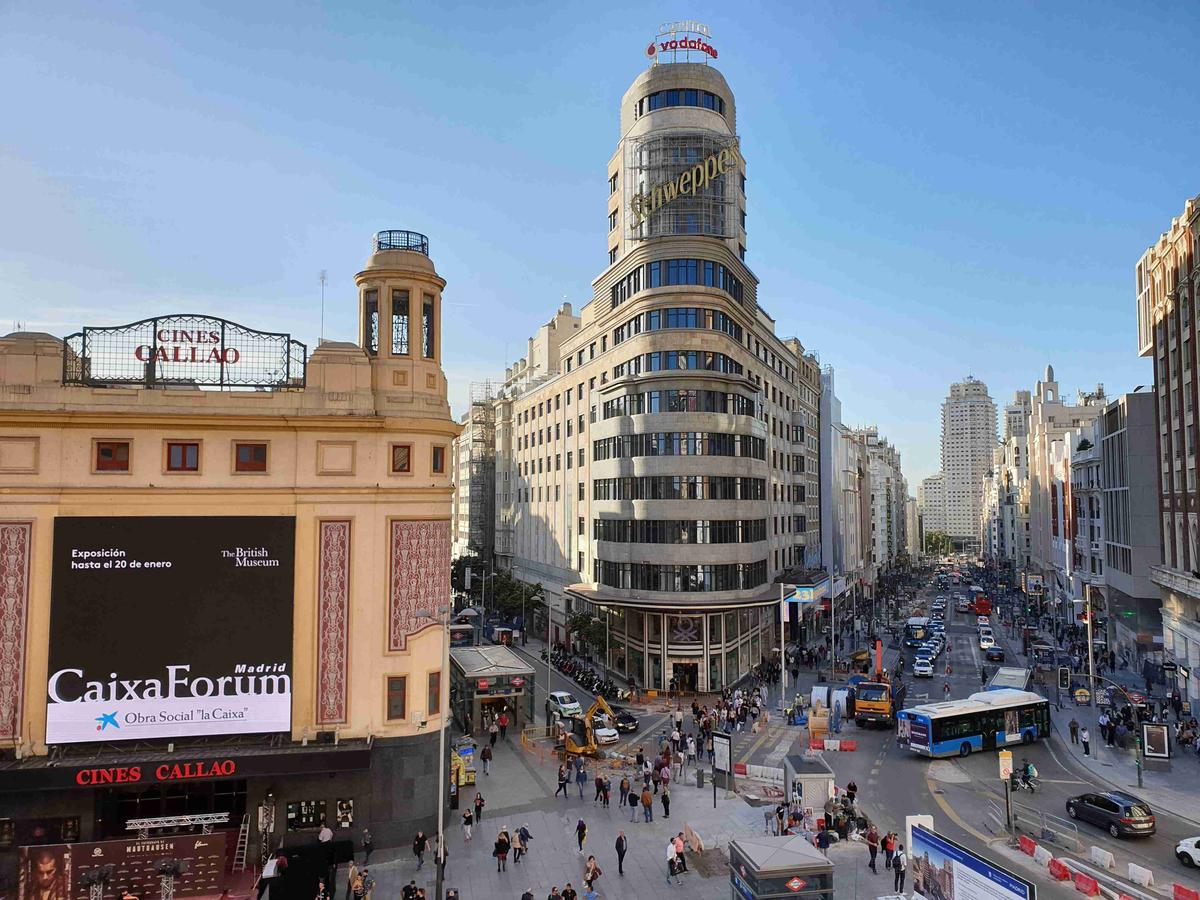
Navigating the roads in Spain requires a thorough understanding of driving rules, with the government strictly enforcing regulations for road safety and order.
Notably, individuals under 18 are prohibited from driving, and tourists must possess essential documents, including an Identification card, an International Driver's Permit, and a local driver’s license.
Adhering to road rules is vital for ensuring everyone's safety and preventing car accidents. Several activities are strictly prohibited when driving in Spain. Here are some essential tips to keep in mind when driving in the country:
Drunk-Driving
In Spain, driving under the influence of alcohol or drugs is strictly illegal. The blood alcohol limit is 0.5 mg. Exceeding this limit can result in an €800 fine, with a maximum penalty of €1,000 and a driving license suspension for up to four years. Authorities strictly enforce this law, conducting breath tests on suspected drivers.
Driving While Distracted
Using a cell phone or talking while driving is prohibited. Actions that distract the driver, such as holding a mobile phone, can lead to a €200 fine and 3 points on your driver’s license.
If the case goes to higher courts, the penalty may escalate to €1,000. Wearing a recommended safety device, like a reflective jacket, is essential for visibility when exiting your car.
Seatbelt Laws
When driving in Spain, it's crucial to adhere to seatbelt laws to ensure safety on the road. All drivers are required to wear seat belts, providing a crucial defense against potential accidents and injuries caused by aggressive or distracted drivers. Seatbelts secure you inside your vehicle, preventing injury during sudden stops or crashes.
Non-compliance with these regulations is a serious offense, outlined in Article 65.4 of the Spanish Law on Traffic, with spot fines of 200 euros. Special considerations apply when driving with children. Here are important details to remember:
- Children up to 135 centimeters must use child restraint systems.
- For children aged 6 to 9 months, weighing up to 10kg, they should be seated at the back facing backward.
- Children aged 6 to 15 months, with a weight of up to 13 kg, must also be seated at the back facing backward.
- For children aged 1 to 4 years, weighing between 9 and 18 kg, they should be seated in the back facing forward.
- Children aged 2 to 6 years, with a weight between 15 and 25 kg, must be seated in the back facing forward.
- For children aged 6 to 11 years, with a weight between 22 and 36 kg, they should be in the back facing forward.
Ensuring compliance with seatbelt laws is not just a legal requirement but a crucial step in prioritizing road safety for both adults and children.
Driving Directions
There are about 38,000 roundabouts in Spain, making it the third European nation behind France and Portugal, with high density per capita of this type of intersection.
So when you are driving in the country, be ready to navigate your way through roundabouts or “Rotonda.” When you are driving in a roundabout, you need to go counter-clockwise, and the driver on the right always has the right of way.
In Spain, the rule is simple: exit the roundabout from the outer lane. The Department of Traffic in Spain advises that if you can't merge into the outer lane immediately, it's better to complete another lap around the roundabout.
Right of Way
Ensuring road safety in Spain involves understanding right-of-way rules. At intersections, vehicles from the right always have priority. If you find yourself on the left side of the road, yield to those on the right. In roundabouts, drivers already inside hold the right of way over those entering.
Additionally, always carry two red warning triangles in your vehicle to handle breakdowns or accidents effectively.
Legal Driving Age
The legal driving age in Spain is 18 years old. Any individual who is 18 years old and above can secure a driver’s license given that they have passed all of the written and practical examinations.
It can be tempting to try to drive in the country, especially if you’re young, but it’s best to get training first for everyone’s safety. Irresponsible driving can cause road accidents.
You may ask yourself: Why do I need an IDP? If you're at a legal driving age, you can secure this essential requirement with us to make your journey smoother and worry-free.
Laws on Overtaking
If you're gearing up to drive in Spain, it's crucial to be aware of specific driving norms designed to enhance road safety and communicate your intentions to fellow motorists. As a visitor, keep the following practices in mind when considering lane changes:
1. Use Signals Effectively:
- Always signal your intent to change or rejoin a lane, either through your vehicle's indicators or with appropriate arm signals.
2. Use Signals Effectively:
- Slow down when executing lateral maneuvers to ensure a safe transition.
3. Hand Signals as Backup:
- If your indicator malfunctions, be prepared to use hand signals as a substitute.
4. Horn Use for Communication:
- Intuitively use your car's horn to alert other drivers to your intention to change lanes, ensuring they understand and can adjust accordingly.
By adhering to these practices, you contribute to a safer driving environment and foster better communication on the roads of Spain.
Driving Side
If you are driving in Spain, the side of the road that you should always stay on is the right-hand side of the road. The cars in Spain are designed for right-hand driving.
It is also important to know that most of the cars in Spain have their steering wheel situated on the left side of the car. This configuration may be quite challenging for those drivers who are used to driving on the left side with the steering wheel on the right side.
Additional Important Rules
- Driving with one hand or arm outside the car can result in a €100 fine.
- Playing excessively loud music near quiet areas, like hospitals, can lead to a €100 fine. Disturbing homeowners may result in a hefty €2,400 charge. Always park away from residential spaces to avoid disturbances.
- Use horns only in emergencies or when avoiding an accident, such as alerting other motorists when planning to overtake a lane.
- Refrain from filling up your car with petrol while the radio is on to avoid a €91 fine.
Stay informed and follow these rules to ensure a safe and pleasant driving experience in Spain!
What are the essential items to carry when driving around Spain?
Driving in Spain is one of the best ways to see what the country offers. But before you head out on long weekend drives, here is a checklist of the things that you should never forget when you are driving:
- Passport as proof of ID
- V5C Certificate
- Warning Triangle
- GB Sticker or Euro Plates
- Headlamp Adjustment
- High-Visibility Jacket
- Native Driver’s License
- International Driving Permit (IDP)
For European Union Citizens, carrying these items is a must. However, if you are new to the policies, then you should always remember these things. More importantly, whenever you are driving in Spain as a tourist, it is crucial to secure an IDP to be permitted to drive.
For an effortless transaction, see our International Driving License packages and see which one best fits your journey in Span.
Driving Etiquette in Spain
Driving is universally acknowledged as a social privilege that demands adherence to established laws. Upholding good driving etiquette is crucial globally to prevent road-related accidents. In Spain, driving expectations are notably strict, necessitating an understanding of local rules and regulations for a smooth experience. Here are essential tips for navigating the Spanish roads:
Car Breakdown
In case of a breakdown:
- Safely pull over to the side, avoiding obstruction.
- Call the emergency hotline (112) for breakdown assistance.
- Display a warning triangle behind your vehicle to alert other drivers.
- Await assistance patiently, refraining from attempting DIY fixes in traffic.
Police Stops
If stopped by the police:
- Comply with requests, presenting identification and relevant documents.
- Verify the authenticity of a police vehicle by dialing 062.
- Exercise patience and avoid potential issues by acknowledging uniformed police personnel.
Asking Directions
When seeking directions, you can use the following Spanish phrases:
- ¿Nos podrías ayudar a ubicarnos en el mapa? - Could you help us locate where we are on the map?
- ¿Cómo llego a la calle principal? - How do I get to the main road?
- ¿Cómo llego al parque? - How do I get to the park?
- ¿Sabes si está por aquí el centro comercial? - Do you know if the mall is around here?
- ¿Hay un hospital cerca de aquí? - Is there a hospital around here?
- ¿Qué tan lejos está el/la… del/de la…? - How far is the… from the…?
- ¿Cuál es la mejor forma de ir a…? - What is the best way to go to…?
- Estoy perdido/a. - I’m lost.
When navigating on the streets:
- Calle - Street
- Avenida - Avenue
- Bulevar - Boulevard
- Callejón - Alley
- Carretera - Highway
- Plaza - Square
Checkpoints
When encountering a checkpoint while driving in Spain, it's best to follow the instructions provided by the police. Typically, these checkpoints involve inspecting the driver's permit and relevant travel documents to confirm your eligibility to drive and ensure compliance with laws prohibiting contraband items.
Spanish police conduct themselves professionally, and concerns are unnecessary as long as you present the required documents proving your qualification to drive. For foreign drivers, possessing an International Driving Permit (IDP) is crucial to avoid any disruptions during these encounters.
Driving Road Conditions in Spain
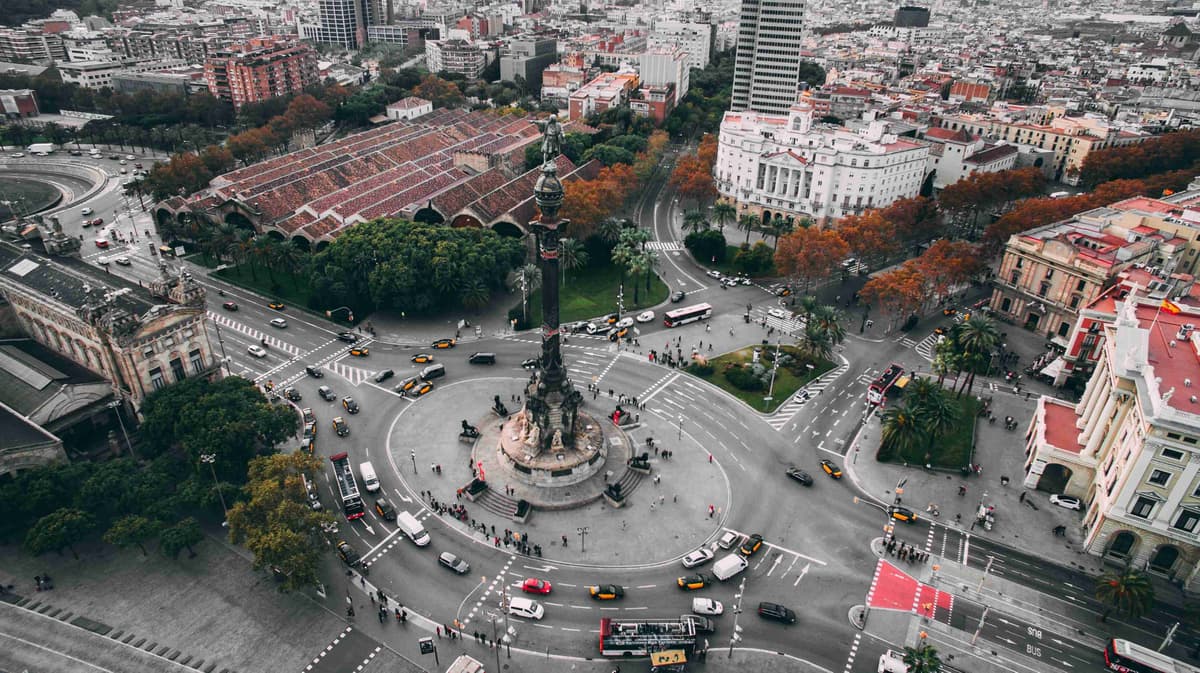
Driving conditions in Spain differ significantly from the US and neighboring countries. Spain generally has fast-paced traffic, well-maintained roads, and affordable gasoline.
To navigate effectively, understanding road signs and consulting the Spanish traffic map is essential. Overall, driving in Spain is a pleasant experience.
Accident Statistics
In 2018, Spain recorded 102,299 accidents, with passenger cars being the most commonly involved vehicle type in 2017. Emphasizing the "right of way" is crucial for road safety.
Strict implementation of driving laws, enhanced road safety measures, and increased infrastructure contributed to the significant decrease in road-related deaths, with only 1,098 recorded in 2019.
Common Vehicles
There are different vehicles you can use when driving in Spain. The most commonly used cars in Spain are the following:
- Seat León (the locals used it 21,204 times in 2018),
- Seat Ibiza (which was voted by 19,519),
- Volkswagen Polo (voted for effectiveness and quality),
- Dacia Sandero (voted 16,728 times by people as the most cost-effective choice)
- Volkswagen Golf (known for its excellent transmission efficiency),
- Citroen C4 (known for its quality safety features and exceptional steering ability)
- Nissan Qashqai (quality SUV type),
- Fiat 500 (one of the most purchased cars in Spain)
- Renault Clio (one of the top-rated cars in Spain)
Roads labeled with "AP" followed by a number in Spain fall under the classification of "Autopistas" or tollways, necessitating motorists to pay for passage. Toll fees can be settled using a ticket upon entry, in cash when leaving the booth, or by credit card at specific machines. Spain follows the metric system for measuring road speeds, making it one of the countries to implement this unit of measure.
The toll charges vary based on the national government's rates and the specific driving location in Spain. Typically, ticket prices are determined by the road's length. Here are the costs for some sample routes:
- AP-7 from Ferrol to Vigo: 180 km; €19.50; approximately 1 hour 45 minutes.
- AP-9 from La Jonquera to Vera: 696 km; €79.40; approximately six and a half hours.
- AP-68 from Bilbao to Zaragoza: 302 km; €29.00; approximately two and three-quarter hours.
To avoid these charges, planning ahead and exploring alternative routes is advisable. Although numerous national highways are toll-free, they might add an extra hour to your journey.
Road Situation
Gran Via in Madrid claims the title of the busiest street in the country. Despite the challenges posed by heavy traffic flow, the street's lively atmosphere, diverse shops, restaurants, and hotels compensate for the congestion.
Driving Culture
Driving in Spain is generally straightforward, with motorists navigating tight corners and spaces aided by systematic driving regulations and road signage. Spanish drivers are recognized for their law-abiding nature and courtesy, particularly in yielding to others, especially during emergencies.
Notably, the well-maintained roads, coupled with the efficiency of roadworks and infrastructural designs, make lane changes reasonably easy. However, it's essential to acknowledge toll payments as a means of contributing to road maintenance.
The Top Destinations in Spain
Spain has remained to be one of the top tourist destinations in Europe. It is home to one of the world’s greatest ancient sites and it has also been widely regarded for its unique cuisine. It is said that the best way to appreciate its cultural value and historical significance is to visit its different regions.
Spain is one of the famous tourist destinations due to its captivating Mediterranean beaches, luxurious resorts, and stunning landmarks that have continuously accentuated its rich cultural and historical origin. If you plan to visit the country, you surely would not want to miss these top tourist spots.
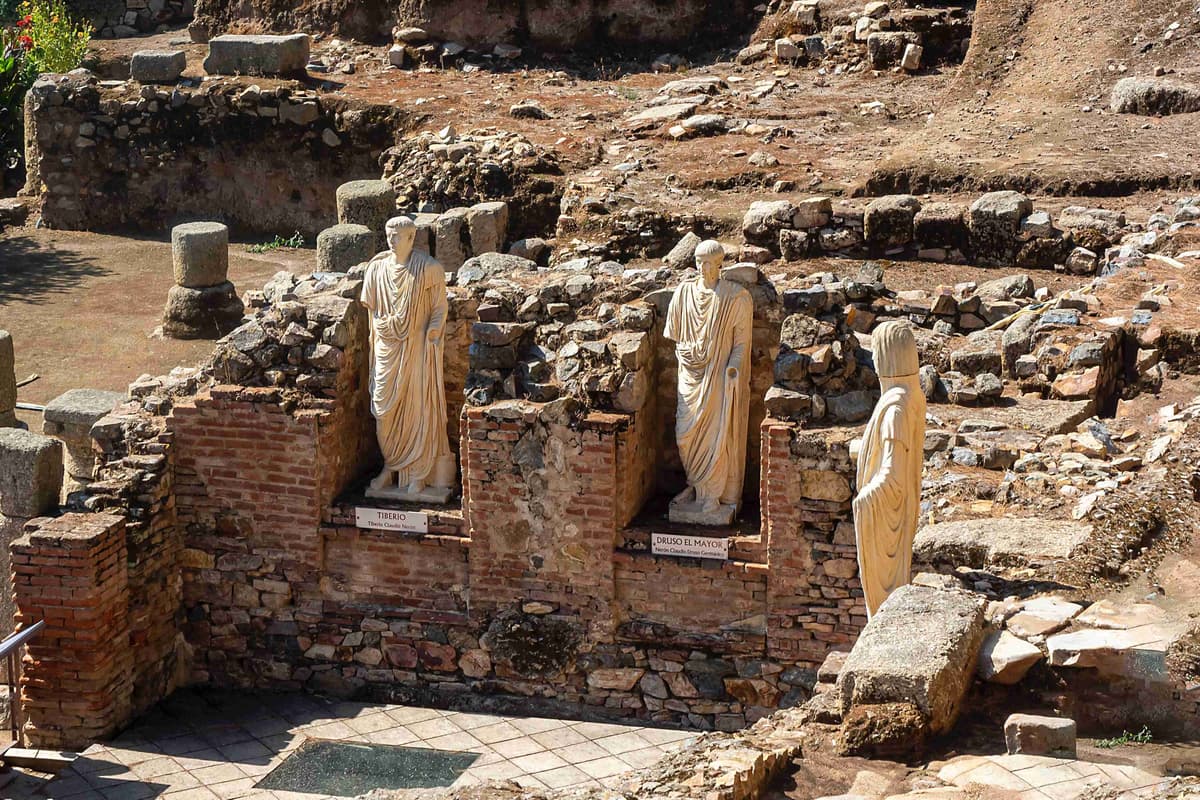
Madrid, the vibrant capital of Spain, is renowned worldwide for its bustling streets, adorned with restaurants, shops, and museums like Reina Sofia, Prado, and Thyssen Museums. The city boasts historical landmarks such as the Royal Palace and Gran Via, offering an unbeatable authenticity. Madrid is undeniably one of the most exciting and diverse destinations in the country.
From Madrid-Barajas Adolfo Suarez Airport, a 25-minute drive to Madrid’s Royal Palace via the M-40 route awaits you. Here's your driving guide:
- Get on M-14, merge onto M-40 toward A-3/R-4/A-4/A-42/R-5.
- Take exit 15-AB for M-30, and follow signs for Moratalaz and Centro Ciudad.
- Merge onto M-30, and take the Glorieta Pirámides exit.
- Slight right onto Calle de Toledo, then onto Gran Vía de San Francisco.
- At Glorieta de la Puerta de Toledo, take the 3rd exit onto Calle de Bailén, keeping right to reach the Royal Palace.
Explore the city's highlights:
1. Royal Palace: Explore the 18th-century palace with its major attractions like Sabatini, the Staircase of Honor, Puerta del Principe, the Royal Guard’s Room, the Hall of Mirrors, and the Columns Room.
2. Thyssen-Bornemisza Museum: Immerse yourself in thousands of artworks from the 13th to 20th century, featuring movements such as Impressionism and Fauvism.
3.Casa de la Villa City Hall and Casa de Cisneros House: Discover Plaza de la Villa, Casa de la Villa (17th-century prison), and Casa de Cisneros House (16th-century palace).
4. Reina Sofía National Art Centre: Visit this art center with a collection spanning from the late 19th century to the present day, showcasing over 18,000 artworks.
5. Buen Retiro Park: Relax in the heart of Madrid, exploring prominent spots like the Crystal Palace, Rosaleda Rose Garden, Alfonso XII monument, and Parterre.
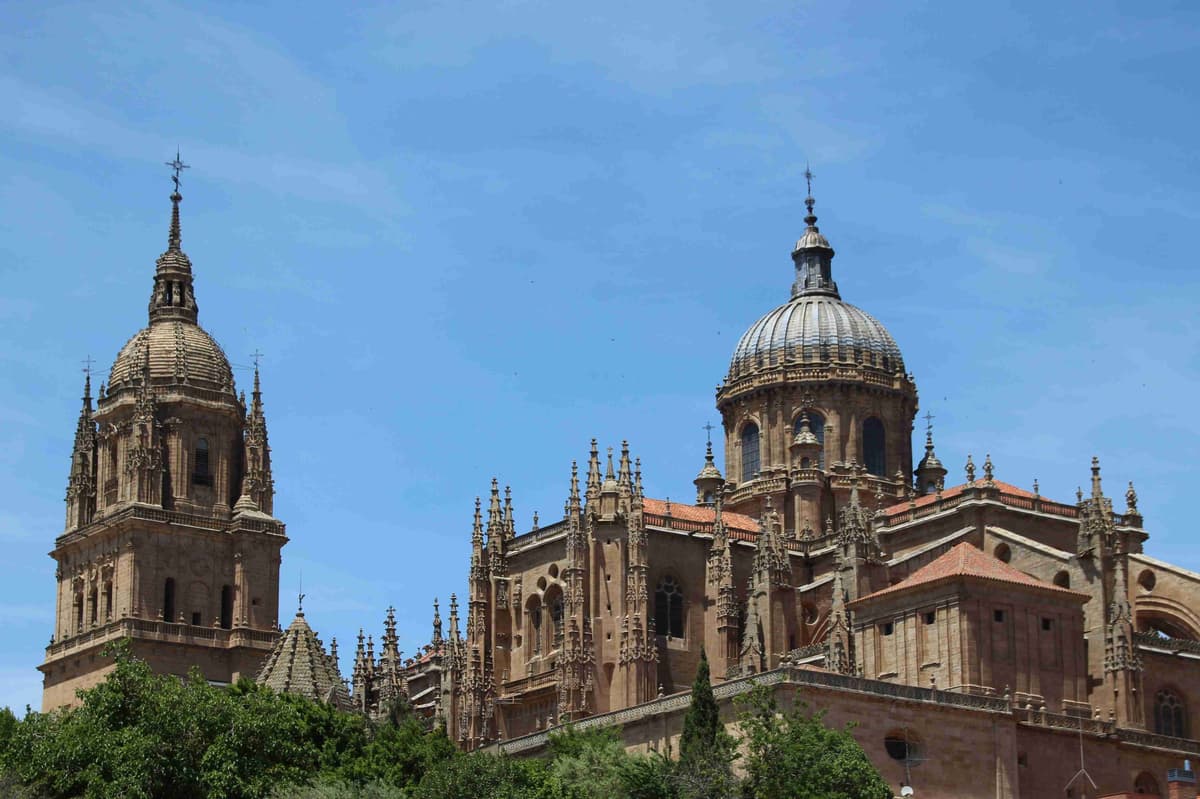
Salamanca, a UNESCO World Heritage city , captivates with distinctive architectural designs and a rich historical imprint. Notable historical figures like Miguel de Cervantes and Christopher Columbus have left their mark. The city's vibrant atmosphere reflects Spain's cultural background.
From Madrid, a 2-hour and 30-minute drive to Salamanca awaits. Take the AP-6 path or the fastest route via A-50 with a toll road. If taking the AP-6, follow these steps:
1. Head south on Calle de Esparteros toward Calle de Postas.
2. Turn right onto Plaza de la Provincia.
3. Follow streets like Calle Imperial, Cl. de Tintoreros/Pza. de Segovia Nueva, and P.º de la Virgen del Puerto.
4. Take A-6, AP-6, A-6, and A-50 to reach Salamanca.
Explore Salamanca:
- Salamanca Cathedrals: Visit two joined churches, the Old Cathedral (12th-13th century) and the New Cathedral (16th century).
- Plaza Mayor Square: Discover one of Spain's most beautiful squares, built in Baroque style, vibrant with locals and diverse buildings.
- Domus Artium 2002: Explore this contemporary art museum, which opened in 2002, coinciding with Salamanca as the European Cultural Capital.
- La Clerecía Building: Admire this baroque-style church and college, now housing the Salamanca Pontificia University.
- Las Dueñas Convent: Interact with Dominican nuns in a convent founded in 1419, featuring Moorish-style architecture.
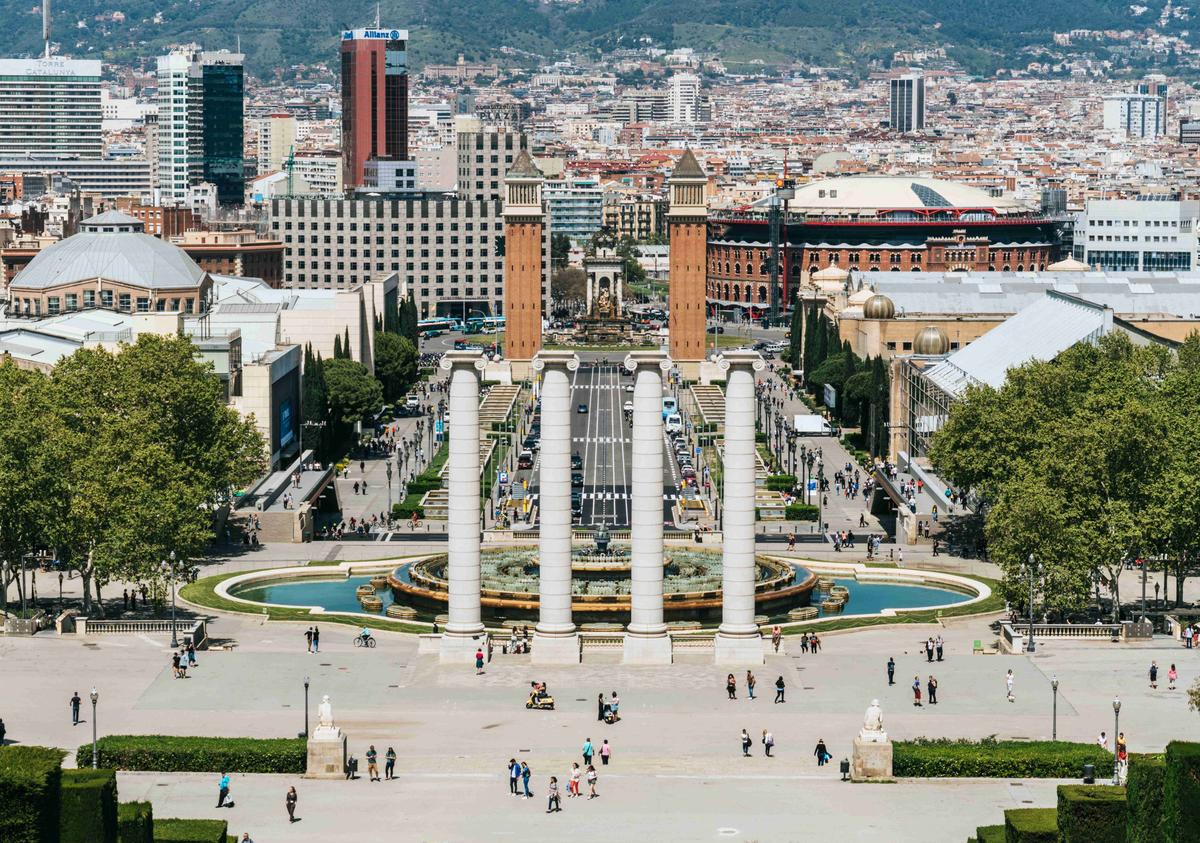
Barcelona, a hub of fashion and culture, offers Art Nouveau architecture, iconic landmarks like Sagrada Familia, and a vibrant Mediterranean ambiance.
From Madrid, a 5-hour drive to Barcelona is possible. Take the AP-2 and AP-7 routes, then enter the C-32 roadway.
Discover Barcelona:
- Sitges: Enjoy the white sandy beaches of this seaside resort, encompassing 17 beaches and charming cottages by the shoreline.
- Basilica of La Sagrada Familia: Marvel at Antoni Gaudi's brilliant design of this iconic temple, featuring intricate interiors and brightly colored exteriors.
- Palau de la Música Catalana Auditorium: Experience opera and entertainment in this historic auditorium, showcasing Catalonian Modernism architecture.
- Casa Milà "La Pedrera": Visit Antoni Gaudi's iconic secular building, a UNESCO World Heritage Site, known for its unique aesthetics and functionality.
- Gran Liceu Theatre: Immerse yourself in the Catalonian Modernism style of architecture at one of Spain's major concert halls.
These destinations offer a diverse range of activities, from exploring historical landmarks to enjoying the sun on beautiful beaches. Driving allows you to uncover the hidden beauty of Spain, complementing your overall experience. Don't forget to obtain your International Driver’s Permit from the International Driver’s Association for a seamless journey.
The listed tourist spots are not just famous; they are an integral part of Spain's cultural and historical legacy, drawing tourists with their tales and significance.
Make the Most of Spain with an IDP
Ready to make the most of your Spanish driving adventure? To meet the essential travel requirements , equip yourself with an International Driver's Permit from the International Driver's Association. It's the key to unlocking a hassle-free and confident driving experience abroad.
Don't wait; start your application now! Get your International Driving Permit here .
Get your International Driving Permit in 8 minutes
Instant approval
Valid for 1-3 years
Worldwide express shipping
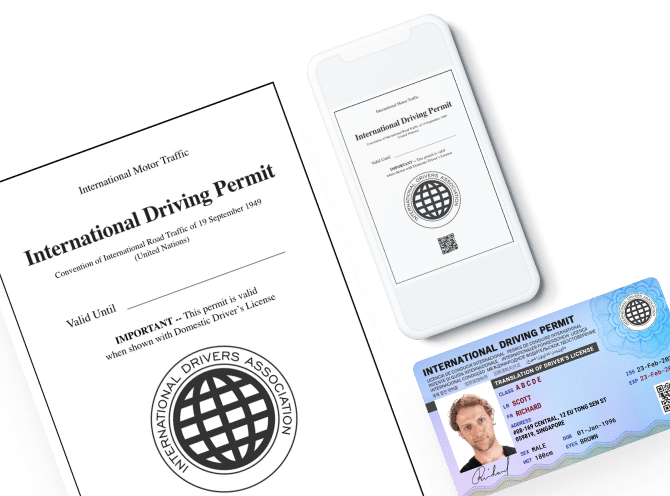
Back to Top

10 Epic Spain Road Trips - Maps, Itineraries and Tips
Want to experience an amazing Spain road trip but not sure where to go? Choose from these 10 stunning routes for your road trip in Spain with our guides, detailed itineraries and insider tips.
Whether you're looking to relax in the mountains off the Costa del Sol, navigate the narrow streets of Toledo or take a stroll down Barcelona's Las Ramblas, we can help you plan the perfect Spanish road trip for you.
Best Spain road trips comparison
We have driven up and down and across Spain a lot of times over the past 15 years. Before we dive into the ideas, here's the complete list of the best road trip routes with key information. Scroll down to see more detail on each one.
Whether you want a relaxing drive along the coast or drive around the entire country of Spain, here are the 10 amazing options for a Spain road trip to pick from.

1. Andalucia road trip
A perfect way to explore Spain is to drive around Andalucia . If you love the sun, beaches and perfect mountain hideaways overlooking the sea, Andalucia is the place for you.
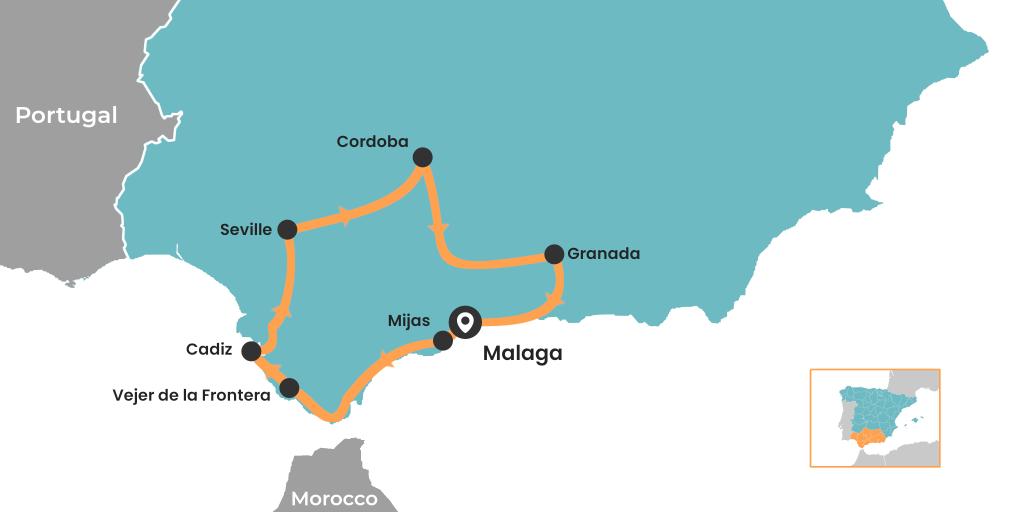
If you are more into culture and love grandiose cathedrals, medieval fortresses and jaw dropping architecture, Andalucia is also a place for you.
If, however, you just want to walk around historic towns and love traditional hearty Spanish food, you guessed it - Andalucia is your perfect destination.
The perfect Andalucia road trip will take you on a loop including coastal destinations such as Nerja, Malaga, Marbella, Gibraltar and Cadiz before going inland to discover Ronda, Seville, Cordoba and Granada.

This drive will scale mountains with breathtaking views and take you to the mesmerising Mezquita cathedral in Cordoba and the unique Moorish Alhambra complex in Granada.
You'll relax in the world famous Andalucian white villages of Mijas, Benahavis and Casares and mingle with new money in Puerto Banus' marina full of expensive supercars, people with too much plastic surgery and the world's biggest yachts.
Road trip length: 11 days
Total distance: 518 miles
2. Drive Spain's Mediterranean coast
Spain's Mediterranean coast is perfect for a Spanish road trip - just make sure you put sun screen on your left arm if you're driving - the sun gets hot!
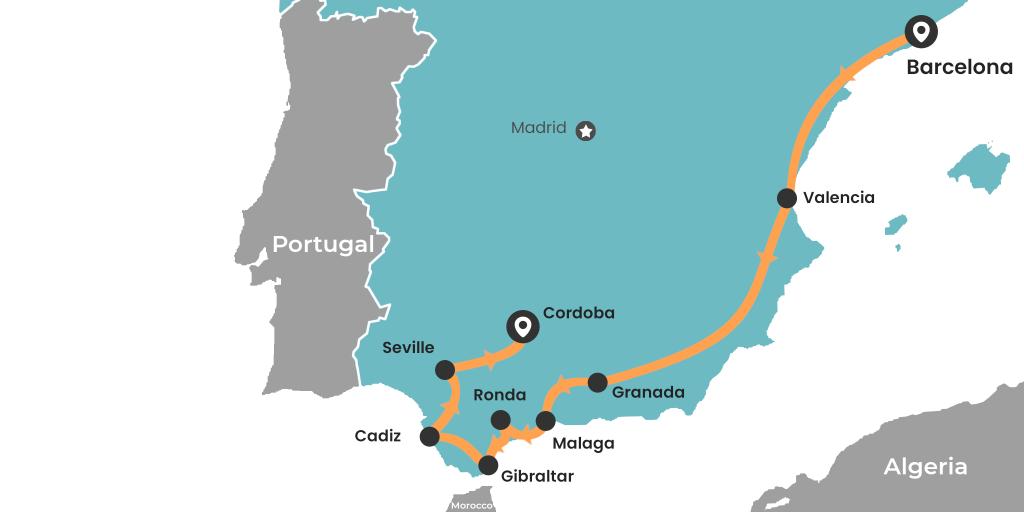
Start your road trip with a mini-break in Barcelona where you can visit sights such as La Sagrada Familia, Las Ramblas and unique buildings designed by Gaudi. There are few cities that offer as much as Barcelona so it's a perfect start to the Mediterranean coast trip.
Next leg takes you south to Valencia - a seriously underrated Spanish city that offers culture, food and sunshine aplenty with an amazing historical centre.
Once you've crossed over the Sierra Nevada mountains, your trip continues to Granada, Costa del Sol, Seville and Cordoba.
You will do an abridged version of the Andalucia road trip above, but get a much broader view of Spain having driven from one corner to another.
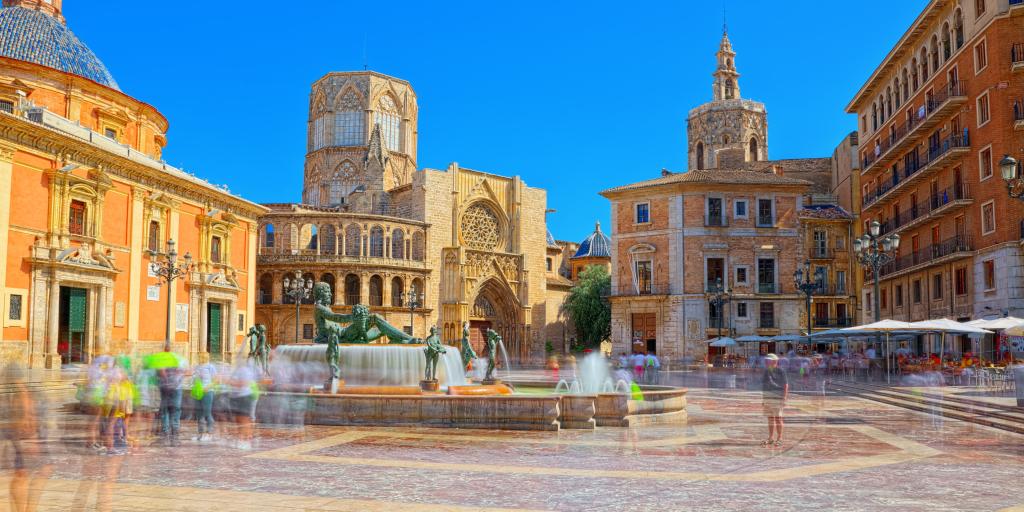
Hugging the coast for virtually the entire trip means that you are always a few minutes away from a beach - something that can provide welcome distractions on your way.
This road trip is a perfect mix of culture and relaxation so if you want to blend the two, give it a go. You will see the world's finest architecture in Barcelona, La Mezquita in Cordoba, the Seville Cathedral and Granada's Alhambra fortress but have time to relax in Puerto Banus, lay on the beach in Nerja and roam the narrow streets of Andalucian white villages.
Road trip length: 14 days
Total distance: 1,385 miles
3. Castille Leon - visit the heart of Spain
If you're flying in and out of Madrid, the Castille and Leon road trip can be an amazing way to explore Spain without having to drive all the way to the coast or spend weeks on the road.
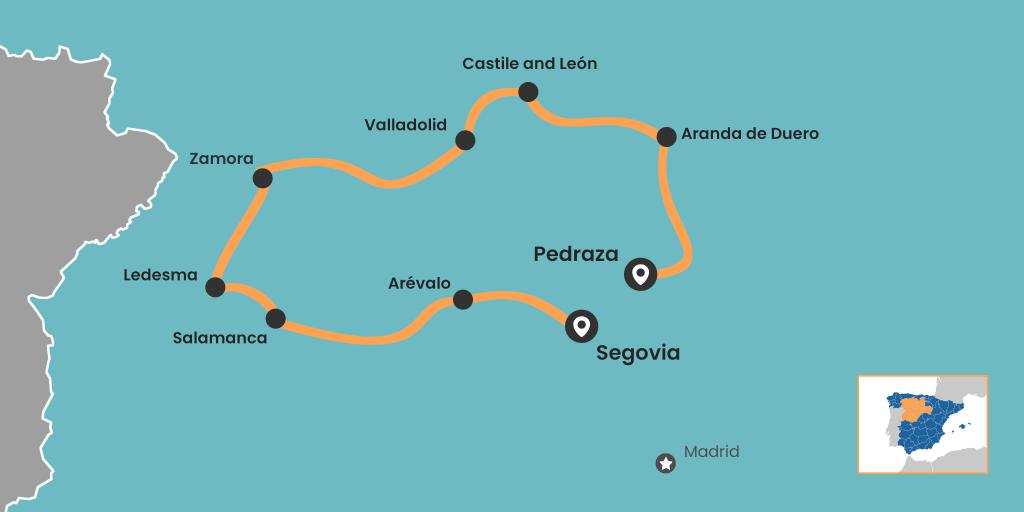
This road trip through Spain's heartland comes in a loop that starts and ends in the Segovia province.
You will start in the historic city of Segovia itself - famous for some of Spain's best architecture and declared a UNESCO World Heritage site.
After a day of exploring, the route heads west towards Salamanca via Arévalo. Arévalo is a small historic town famous for its Mudejar architecture and art giving it a special protected status in Spain and Salamanca is an ancient city with two cathedrals - the New one (it is actually called that) began construction in 1513!
From Salamanca, you can check out other beautiful historic towns of Ledesma and Zamora before a stop in Valladolid - the assumed capital of the Castille and Leon province. Its medieval history can be seen throughout the city - the Spanish Monarchy even made Valladolid their home in the 17th century!
After a visit to the city that shares its name with the Castile and Leon region, the trip ends with a drive through the Ribera del Duero wine region - hugely underrated relative to Rioja and the Portuguese Douro wine further down the same river valley.
The end of the trip gets you to Pedraza back in the Segovia province before taking a short drive back to Madrid's airport.

You can extend this road trip to include the historic Spanish cities of Leon and Burgos in the north of the province, but that will add a lot of mileage and time to your trip and southern Castille and Leon has a huge amount to see already - you can easily spend 2 weeks exploring this part of Spain and see new places every day.
Road trip length: 7 days
Total distance: 345 miles
4. Northern Spain road trip
So often overlooked in favour of Costa Brava, Costa del Sol or Costa Blanca, Spain's northern coast makes for an amazing road trip exploring the mix of cultures, fantastic food and rocky shore scenery.
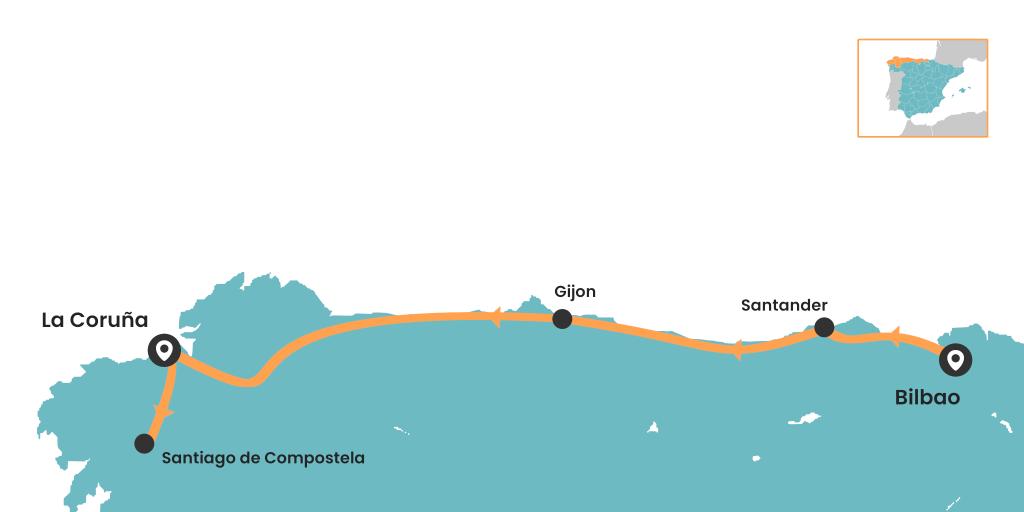
The road trip starts in the capital of Spain's Basque country - Bilbao. This is a place worth spending a couple of days in to explore its old historic centre, the surrounding mountains and the spectacular world-famous Guggenheim museum.
There is something for everybody in Bilbao with superb pintxos in street bars and michelin-starred restaurants, medieval streets and modern boulevards.
The road trip then moves west along the coast to Santander, before further stops in Santillana del Mar, the Picos de Europa national park and Gijon.

This trip includes a mix of beaches, historic Spanish cities and exploring nature - a perfect mix for a Spanish road trip!
Once you've hiked amazing gorges and filled yourself with pastries, it's time to hit the road and drive on to Oviedo and La Coruna.
Finishing off with a day trip inland to Santiago de Compostela, you will travel the entire length of Spain's Bay of Biscay coastline with everything to see along the way.
Depending on your flights, you might have to do a drive back along the coast to Bilbao or down to Porto or Madrid - this is one heck of a trip that you won't find in many recommendations or guides!
Road trip length: 10 days
Total distance: 737 miles
5. Basque country and Pyrenees
Spain's north-west corner lying on the Bay of Biscay and bordering France is full of history, tradition and... mountains.
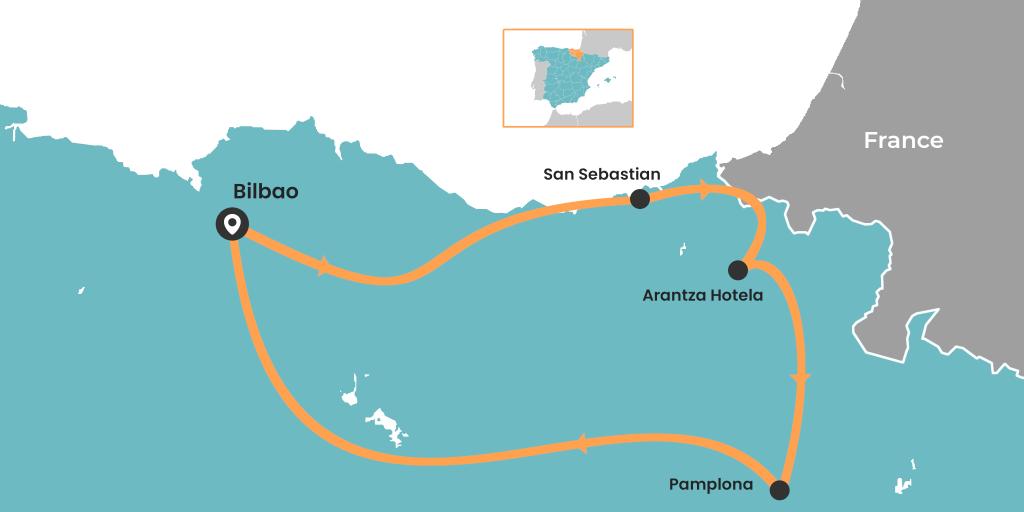
The Basque country is a unique part of Spain - they have a prominent local language, cities that make up two prominent medieval kingdoms (Basque and Navarre) and a unique link to the Pyrenees. In medieval times, Basque country spanned the mountain range, including parts of France on the other side.
Today the region fervently focuses on its culture. As you travel in major cities such as Bilbao, San Sebastian and Pamplona, you will get to try the local pintxos tradition. In some ways similar to tapas popular in the rest of Spain, pintxos are smaller bite-size snacks served in bars and charged by number or by plate.
If you get out of the tourist areas, you will find local pintxo bars where the snacks are free as long as you keep buying the drinks!

The Pyrenees are an amazing mountain range that is not high on many tourists' radars.
Often overlooked in favour of trips to the Alps or even Sierra Nevada further south in Spain, the Pyrenees are an older mountain range with a lot of peaks over 3,000m above sea level.
The roads through the Pyrenees are fantastic and can make for really great road trips with the added bonus of hardly any other cars as you drive around. There are some fantastic hotels if you want to really relax and go off the grid for a few days - we have stayed at The Arantza Hotela in the foothills of Pyrenees and cannot recommend it highly enough - it is expensive but super luxurious and worth it!
A small number of rooms have stunning views of the surrounding hills with morning fog climbing towards the peaks and you can relax in a jacuzzi looking out over the landscape before having an amazing dinner in the hotel's gastro restaurant.
After a few days of luxuriating, it's time to drive down from the mountainside and make your way to Pamplona - a historic city famous for its July bull running festival has far more to offer than the medieval tradition. Narrow streets, beautiful stone buildings and fantastic local coffee shops are great for unwinding in late morning.
The drive back to Bilbao airport is a little under 2 hours to get you back home!
Total distance: 240 miles
6. Driving tour of Catalonia
There is a whole lot more to Spain's Catalonia region than Barcelona. You can spend weeks travelling around the area and still not see dozens of amazing villages, secret beaches, mountain waterfalls or quirky museums.
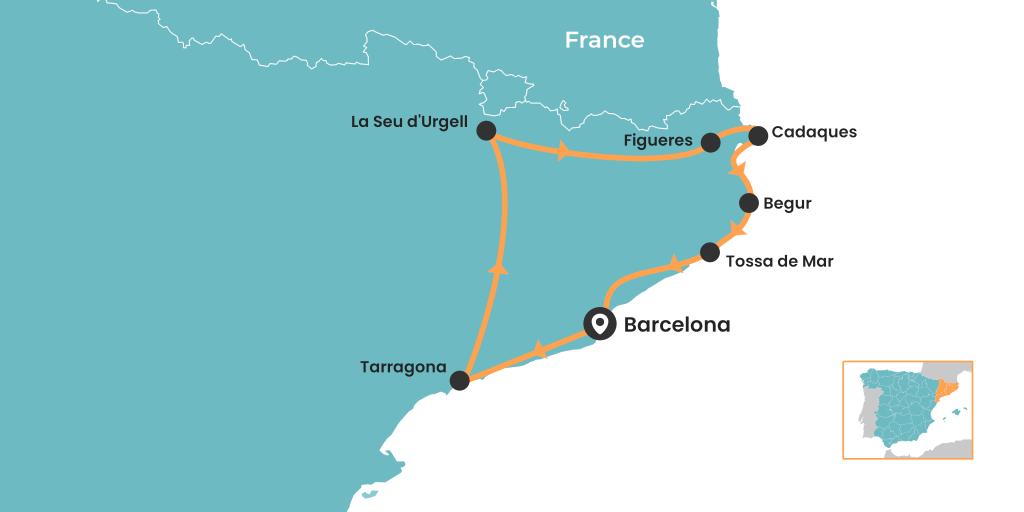
If you want to base yourself in Barcelona, instead of going on a road trip, check out our 40 day trips from Barcelona for inspiration on where you can get to!
A great route around the region can start and end in Barcelona to make it easy with flights.
From Barcelona, head south along the coast to Tarragona with a stop in Sitges and the option of relaxing in one of a few great beaches along the way.
From Tarragona, this trip goes inland towards Montblanc and all the way to La Seu d'Urgell in the Pyrenees via Solsona.
On your route across the north of Catalonia, you are spoilt for choice with the Garrotxa volcanic national park and the village of Santa Pau worth visiting, a detour into Andorra and towns like Besalu and Castellfollit de la Roca all great options before you arrive in Figueres.
After some cultural sightseeing, head on to Cadaques on the coast - there are some great beaches and a Salvador Dali House Museum.
The rest of the road trip follows the Costa Brava back down to Barcelona. There are tonnes of great places to stop including Roses resort, the canals of Empuriabrava, L'Escala and Begur. A drive inland to Girona is optional before you make it down to the relaxation end of the journey with beach stops in Tossa de Mar and Lloret de Mar on the menu.
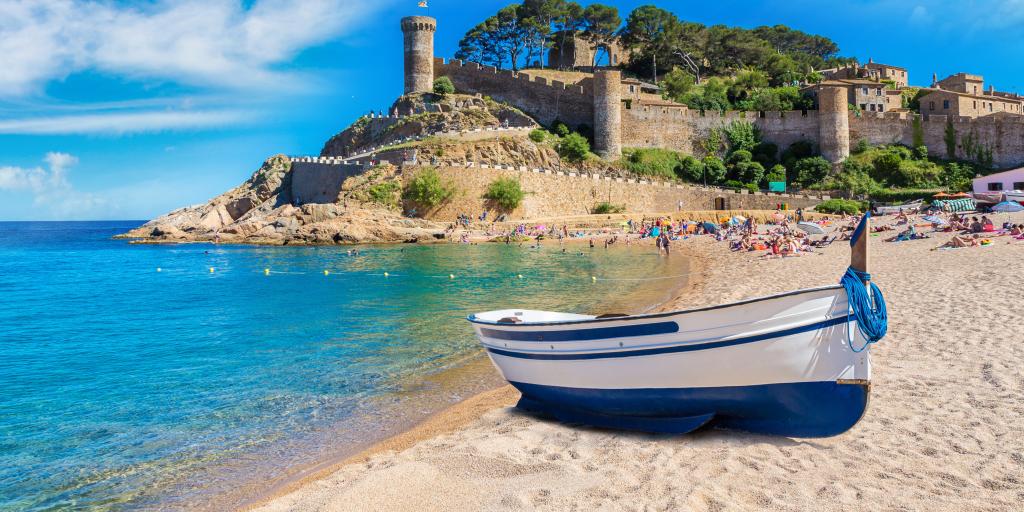
There are few parts of the world which have so much to see in such a compact region both culturally and in nature. If you love the mountains, hiking and being off the beaten track, a road trip around Catalonia is definitely the best choice in Spain.
Road trip length: 9 days
Total distance: 520 miles
7. Historic central Spain - Castilla-La Mancha
Castilla - La Mancha is one of the largest regions of Spain and also one of the least well known by tourists.
Hidden away in plain sight right next to Madrid, it stretches almost as far as Valencia and Murcia in Spain's south east.

Exploring this region brings a mix of natural sights and beautiful historic Spanish cities. As with the Castille Leon trip, it's easy to start and finish in Madrid if that's where you can get easy flights to.
This Spain road trip starts in the most famous city in the La Mancha region - Toledo. Toledo is famous as a blend of Christian, Muslim and Jewish religions and cultures. It was the capital city of the Visigoth Empire, Spanish Moors and later of Spain at some points during the course of history.
After a couple days of sightseeing, it's time to hit the road and head on south to Ciudad Real via Consuegra and Daimiel.
There is a lot to see in this part of Spain including the infamous windmills made famous by Miguel de Cervantes' Don Quixote. The majority of the region is set on a plateau with occasional barren hills.

The trip continues east to Cuenca and Siguenza - both stunning towns but in completely different ways and both very different from a lot of typical Spanish destinations.
If you're feeling adventurous, there are a number of national parks on the way where you can stretch your legs on a hike or just take a scenic detour.
Total distance: 380 miles
8. Galicia road trip
Getting to and from the region can be tough so you might have to adjust the route depending on where you're travelling from.
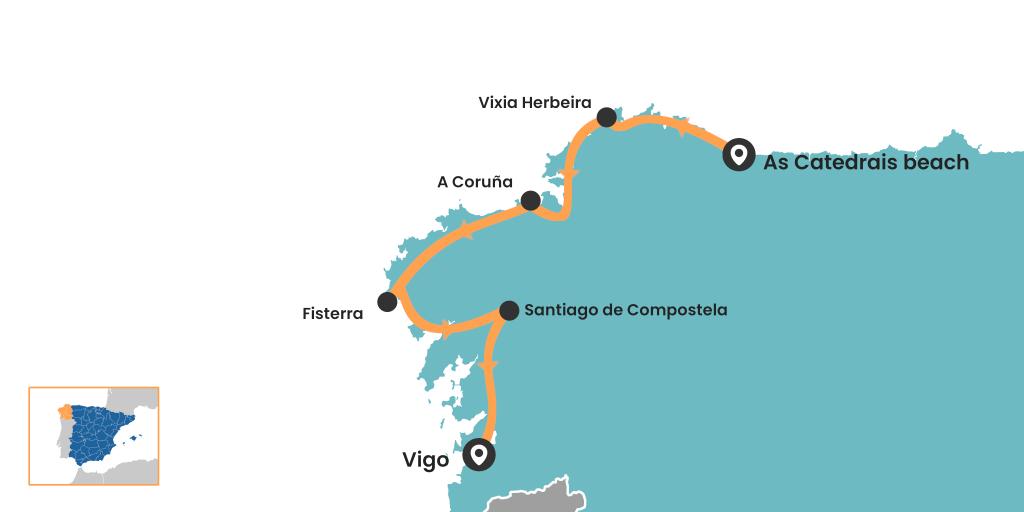
The plan with this road trip is to go all the way round the Galician coastline starting from As Catedrais beach. If you don't know it by name, you've definitely seen pictures of giant rocks and archways on the sandy beach before.
Although this trip is only 5 days long, you'll spend a few of these driving along small coastal roads. Our tip is to ignore the navigator which will send you inland along faster roads. Keep the sea to your right as you go and you're unlikely to go too far wrong.
After passing the Vixia Herbeira cliffs, you'll arrive in A Coruña. Other than the Hercules Tower, the main sight here is the light house. Naturally.
Take a day to see the city and its surroundings - seafood here is amazing as it's a functioning port supplying much of the region and beyond.
The trip then continues around the coast to Santiago de Compostela. You can take the direct short cut but you will miss out on a whole lot of stunning scenery, ocean-facing cliffs and spectacular locations for light houses - on the shoreline, on cliffs and even on their own islands.
After exploring the historic and religiously important city, the route goes back towards the coast and passes Pontevedra on the way to the pretty town of Vigo.
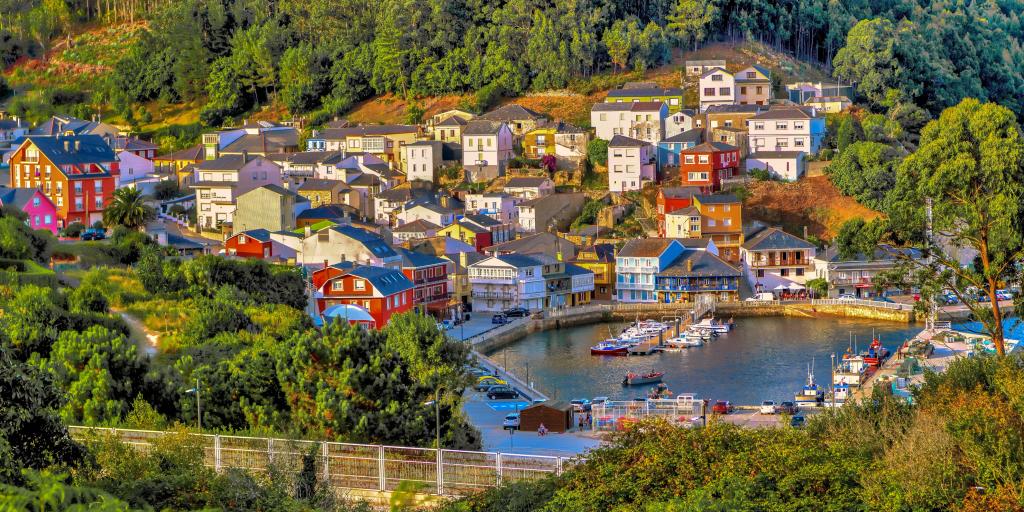
This might not be so much of a Spanish road trip as a gentle breeze along the coast (and there will be a lot of breeze!), but it's definitely one to keep in mind if you want to unwind and keep yourself away from the tourist traps around Spain.
Road trip length: 5 days
Total distance: 322 miles
9. Road trip around Mallorca
Many don't associate Mallorca with a road trip, but the island has a huge amount to offer beside the beaches and clubs.
Flying in and out of Palma means that's a great place to start and finish your trip.

Palma is the capital and often overlooked by visitors who go straight from airport to their preferred corner of the island. The city actually has a lot to offer so it's great to spend the first or last night here depending on your flight times.
Make sure you check out the huge Cathedral (you really can't miss it) and the part of the city around the market (only open in the morning).
Once you set off, the best way to see the island is to drive all the way around.
Start by heading along the narrow cliff roads along the coast to Valdemossa and Soler - the two very popular destinations to the north of Palma. After that the road trip continues all the way to Port de Pollença before heading across the island to Cala Mesquida.
Once you've navigated the tourists, a short drive down the coast takes you to Cala Agulla where the beaches are empty and the sun is just as hot for some relaxation.

To wrap up the trip, you've got to stop off at the resort town of Cala d'Or before making your way back to Palma.
A short trip with a lot of breathtaking views and cliffs in the north and resorts with fantastic beaches on the south can be the perfect way to unwind on a short break!
Total distance: 175 miles
10. The full circle - A complete road trip around Spain
If you have time on your hands and feel adventurous, a road trip around the entirety of Spain can be an amazing way to delve into the culture, see all the corners of this amazing country and really get immersed.

One key disclaimer is that while this one sits high on our list of bucket list trips, we haven't actually done the full trip - it's a long drive!
But if you're brave enough, you can start wherever along the route you like as you it goes in a loop.
Barcelona and Madrid are likely to be the best hubs for getting in and out of Spain and the route cycles down through Valencia to an Andalucian tour before heading back north from Cordoba.
After exploring central Spain with stops in Toledo and surrounding towns and a tour of Madrid, the drive continues into Spain's Duero valley, Valladolid and on to Galicia's Vigo, Santiago de Compostela and A Coruna while taking in breathtaking views of ocean-facing cliffs and huge waves.
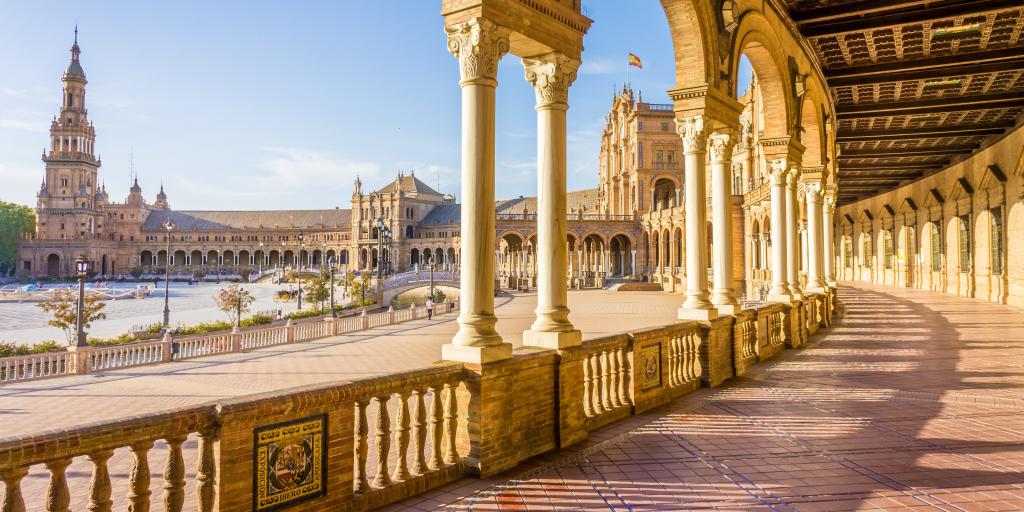
The trip continues along the north coast stopping off at Santander, Bilbao and San Sebastian before detouring off into the Pyrenees and the historic cities of Pamplona and Zaragoza. A mini Catalonia tour to end the trip wraps up the route that will take at least a month to complete if you want to do things other than driving.
If you do end up doing this one, please let us know! We'd love to see how you get on!
Road trip length: 35 days
Total distance: 2,800 miles
Join our email list!
By joining our email list, you give LazyTrips permission to use your email for sending you newsletters, emails and updates including for marketing purposes. Your email will not be provided to third parties.
Related posts
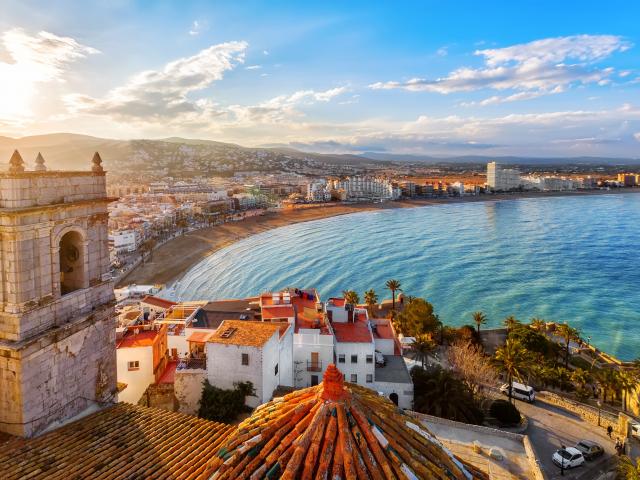

Spain Road Trip: 8 Amazing Routes for an Epic Trip
This post may contain affiliate links, from which we earn an income.
Our Pick of the Best Road Trips in Spain
Amongst the beautiful landscapes of Spain, in the mountainous interior and along the gorgeous coasts, you’ll find fascinating history, vibrant culture, and incredible cuisine. One of the best ways to experience Spain is by taking a road trip.
With the lively attractions of Barcelona, UNESCO World Heritage Sites, the historic medieval cities of the interior, and endless summer days in Andalucia, Spain is an eclectic place to take a road trip.
We base ourselves in Spain when not traveling and have explored much of the country on four wheels and two! Whether you want historic cities, gorgeous landscapes, beaches and sun, or something a bit different, our detailed guide has the best Spanish road trip routes plus itineraries and travel tips, to help you plan the perfect trip.
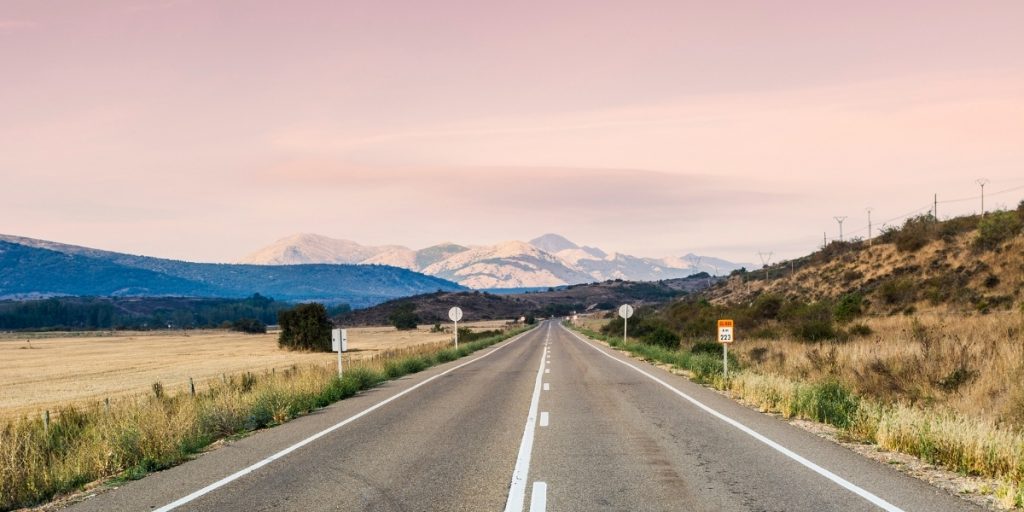
Getting to Spain
Whether you’re taking a Spain road trip in a car, motorcycle, campervan, or motorhome, self-driving is absolutely the best way to explore this spectacular part of the Iberian Peninsula.
When you road trip Spain you can stop whenever you want, try new activities, visit places you see along the route, and have the freedom to change plans at the last minute.
Spain is an easily accessible country from the UK and most of Europe, with a direct ferry route from England to Santander or Bilbao, and an established network of autovias to help your road trip across the country. Plan on getting to Spain as part of your trip and enjoy an epic road trip to Spain, followed by one in the country itself!
RELATED POST: Driving from UK to Spain – Routes & Tips
Book with Skyscanner and fly into the well-located international airports of Madrid , Malaga , and Barcelona are ideal starting points your Spanish road trip – you can be anywhere in the country within a day and that’s the beauty of a viaje por carretera , or road trip in Spanish!
Are you planning to rent a car in Spain? As one of the largest car hire aggregator companies in the world, we recommend Rentalcars.com because they have massive purchasing power which enables them to secure the best car rental prices, which benefits you when you’re planning a roadtrip in Spain.
For a real adventure , hire a motorhome or campervan in Spain. We recommend Motorhome Republic , an aggregate booking site who pull together all the best deals from a number of rental agencies, to offer you a wide choice of options alongside an excellent English speaking expert motorhome Concierge Team.
Best Spanish Road Trips Map
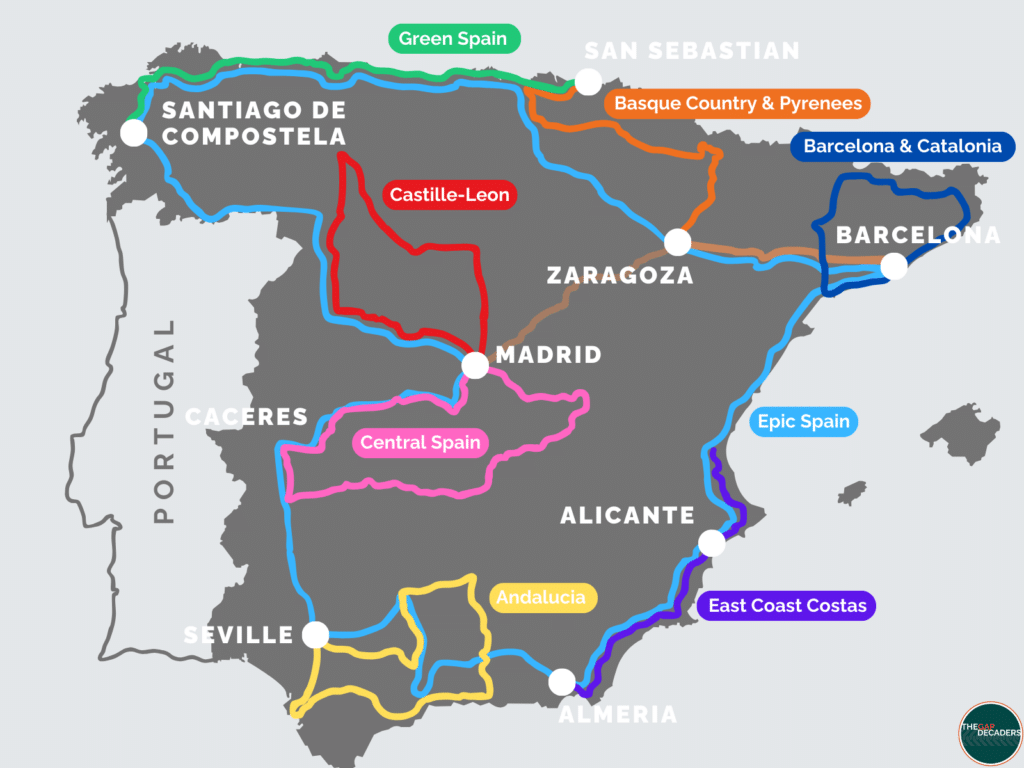
Which is the best road trip in Spain?
- Castille-Leon for historic cities, vineyards, and empty roads.
- Barcelona and Catalonia for beautiful beaches and lively party vibes.
- The Basque County and Pyrenees road trip is perfect for foodies and hikers.
- Andalucia for gorgeous Moorish cities, flamenco, and fantastic beaches.
- East Coast Costas for vibrant seaside resorts and sunny days year round.
- Central Spain for wild natural landscapes and off-the-beaten-path towns.
- Green Spain for quiet beaches, mountain hiking, and fab food.
- Epic Spain for an amazing journey through the best of Spain.
Is this your first time visiting Spain? Get all the information you need in our Spain Travel Guide , including what to pack, the best time of year to go, getting there, and practical tips to help you have the best trip!
Castille-Leon
Madrid – segovia – salamanca – zamora – león – valladolid – penaranda del duero – madrid.
- Distance: 915km
- Duration: 7-10 days
- Drive Time: 11 hours
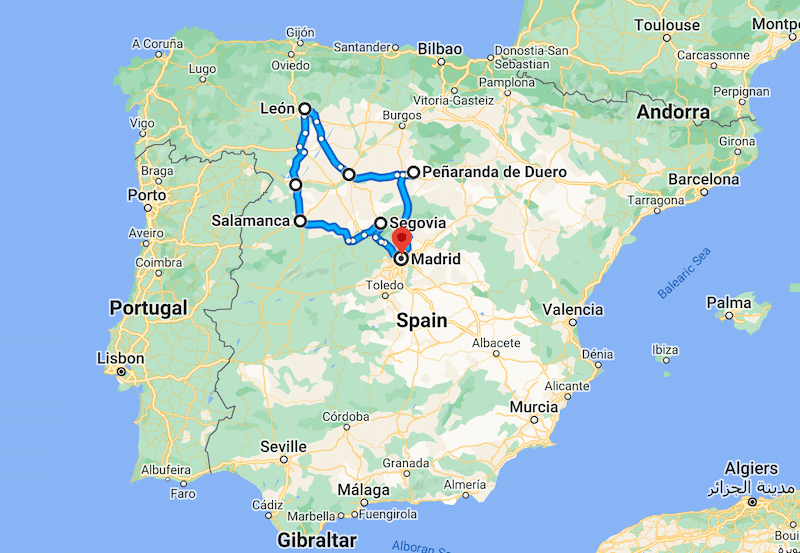
This fantastic seven to ten day Spain road trip itinerary through the land of frontier castillos and roads that stretch into the distance for miles will take you across the high plateaus and rugged mountains of central Spain. This is a road trip for those who want the real Spain.
It will be unbearably hot in summer and bitterly cold in winter in this part of Spain. This road trip in Spain should be taken in spring when the fields are carpeted with colorful wildflowers, or in autumn/fall for the late summer sun and the beautiful ochre and red of the Duero vines.
Pick up your hire car at Madrid airport and spend a day in Madrid , the largest city in Spain, seeing the most important attractions, including Plaza de España, the Prado Museum, Plaza Mayor, and the nearby Baroque Royal Palace before heading to the UNESCO World Heritage Site of Segovia, a walled city with grand squares and mansions from its days as a royal holiday resort, and one of the most distinctive medieval castles in Europe.
Next up, visit Salamanca , known as the Golden City because of the prolific use of honey-colored sandstone in the civic and religious buildings of the city. Salamanca is beautifully graceful, with learning at its heart, and the most elegant Plaza Mayor in Spain.
Zamora is your next destination. With its Romanesque churches and charming streets and squares of the old town, this makes a great stop for an overnight stay. Onwards to Leon, a sociable city with a fabulous casco antiguo, packed with great architecture and atmosphere, and a notable Gothic cathedral.
Valladolid, your next stop is high on the mesta (plateau) and has been lived in by many of Spain’s famous historical figures. Despite that, it is a more modern town than its neighbors. You’ll find restored plazas and churches along with some excellent museums.
To the east, the small town of Penaranda del Duero is deep in the lush rolling vineyards of La Rioja, where some of the best wines in Spain are produced. This gorgeous town, on the Ribera del Duero Wine Route, sits beneath an impressive castle and is a popular weekend getaway for Madrilenos .
Spain is famous for its history and if you have an extra day at the start or end of your road trip, visit Toledo , an hour’s drive to the south of Madrid. Known as the Imperial City, this UNESCO World Heritage Site has one of the most well-preserved old towns in Spain and more historical sites per square meter than Rome!
- Eat suckling pig in Segovia, a truly delicious local specialty.
- Head for the tapas bars of the cathedral quarter in Leon. Order a small beer and get a complimentary tapa!
- Visit a bodega along the glorious Ribera del Duero and enjoy a wine tasting.
Where to Stay
Madrid ⇒ Only You Hotel Atocha for its hip vibe, contemporary luxe decor, and fantastic public spaces.
Leon ⇒ Hotel Real Colegiata San Isidoro for its superb location, complete uniqueness, and fabulous history.
Valladolid ⇒ Abadia Retuerta LeDomaine for sheer luxury, fabulous restaurants, and an incredible spa. A fabulous hotel for the perfect end to your road trip.
RELATED POST: Madrid in One Day – Itinerary, Map, Tips & Guide
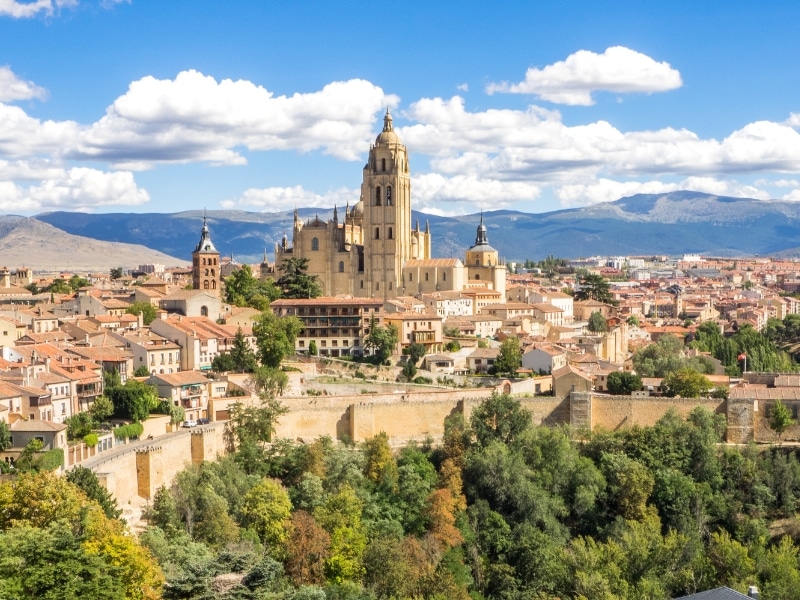
Make sure you have travel insurance you can trust when visiting Spain . We recommend True Traveller for their excellent TrustPilot reviews, variety of cover options, best activities cover as standard, great prices, and excellent service.
Barcelona & Catalonia
Barcelona – sitges – tarragona – la seu d’urgell – figueres – calella de palafrugell – tossa de mar – barcelona.
- Distance: 642km
- Drive Time: 10 hours
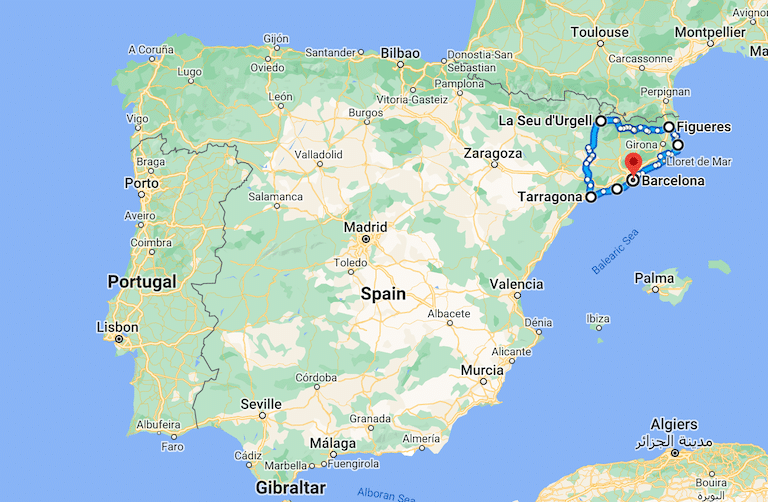
This seven day Costa Brava road trip from Barcelona takes you through one of Spain’s most distinctive regions. Catalunya is fiercely independent with a unique identity, and like nowhere else in the country. With its own language, Catalan, the region has long been an intersection of cultures and influences.
We start on the Costa Brava in the second biggest city in Spain, Barcelona. This is Gaudi’s city and home to the sublime but unfinished La Sagrada Familia cathedral. Once you’re done admiring his masterpiece, head for the Gothic Quarter, a great spot to while away an evening bar hopping in this most lively of cities.
If you have enough time, try hiking in Montserrat , just a short drive from the city. Famous for the cliff-hugging monastery and distinctive serrated rocks, you don’t even have to hike, you can get a cable car to the top!
Head south along the coast to beautiful Tarragona, stopping at Sitges if partying is your thing …but be prepared to party hard, the town is famous for its nightlife.
Tarragona is situated on a rocky hill above the sparkling Mediterranean Sea. With a fine historic center and a scattering of Roman ruins, this is a great place to spend the day visiting the must-see 2nd century Amfiteatre Romà, Necropolis, and Forum before wandering the Passeig Arqueològic for sweeping views of the city. Or you could just relax on one of the many beaches.
From here it’s inland and north to the Pyrenean medieval town of La Seu d’Urgell, overlooked by the Sierra de Cadí mountains. Replete with the Romanesque style architecture of Catalonia in the 11th and 12th centuries, this is a town for meandering.
From La Seu d’Urgell, it’s a hop and skip to Andorra, the sovereign landlocked country that crowns the Pyrenees. We’re on the fence about this tiny microstate, which we thought was a little… odd. But, if you want to tick another European country off your list, now is the time!
From here, a spectacular drive through the foothills of the Pyrenees takes you to Figueres, via La Garrotxa Natural Park, known for its many extinguished volcanoes. Figueres, the birthplace of artist Salvador Dalí, houses the Teatre-Museu Gala Salvador Dalí, which is worth a visit if you like Surrealism.
You’re heading south now, bypassing Girona (which is worthy of a visit all of its’ own if you have time) in favor of the Costa Dorada beach resorts of Calella de Palafrugell and Tossa de Mar.
Calella de Palafrugell is one of the most beautiful coastal villages in Spain, with cute white houses, colorful wooden boats on the beach, and rocky inlets and hidden coves, and makes a perfect spot to stop and relax for a couple of days.
Tossa de Mar has a beautifully preserved old town, complete with cobblestone streets and fortifications and a fine beach, at total odds with its near neighbor, Lloret de Mar, which was one of the first places to Spain offer package holidays in the post-Franco tourist boom in the 1970s and has the highest concentration of hotels in the Mediterranean.
- The works of Gaudi define Barcelona and the Sagrada Familia and La Pedrera are must-sees.
- Bar hop and eat pintxos, delicious small snacks on sticks, local to Catalonia and the Basque region.
- Take out a kayak or paddleboard from El Golfet Beach to enjoy a different perspective of the coast, and the clear turquoise waters.
Barcelona ⇒ B Hotel for its handy location between the airport and the city, glitzy rooftop terrace with pool, and welcoming staff.
Tarragona ⇒ Plaça De La Font for its excellent old town location, lively vibe, and superb breakfast.
Tossa de Mar ⇒ The Hotel Delfín for its beachside location, supremely stylish decor, and pool with a view.
RELATED POST: One Day in Barcelona – Itinerary, Map, Tips & Guide
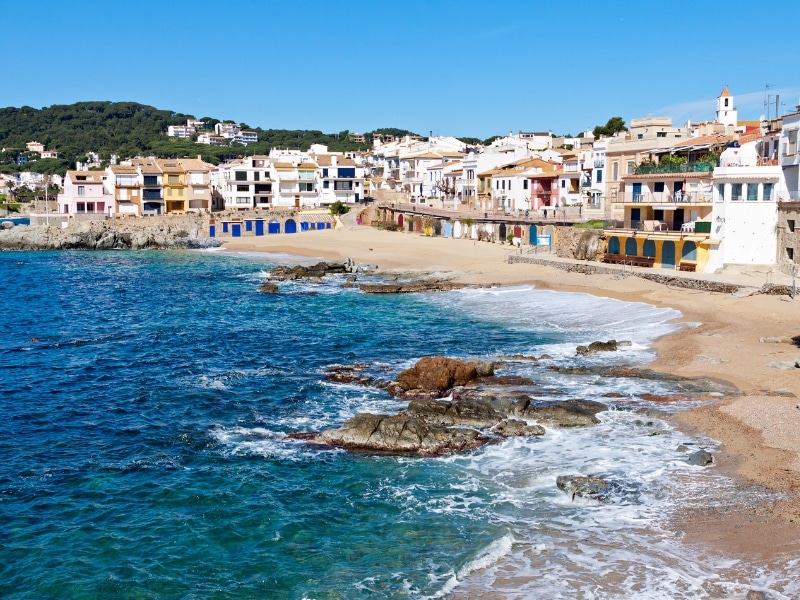
Don’t forget your road trip essentials! Our free road trip checklists help you remember everything, including road trip snacks , podcasts , and road trip songs for the journey!
Basque Country & Pyrenees
San Sebastián – Bilbao – Pamplona – Torla Ordesa – Ainsa – Zaragoza – Barcelona or Madrid
- Distance: 962km
- Drive Time: 12 hours
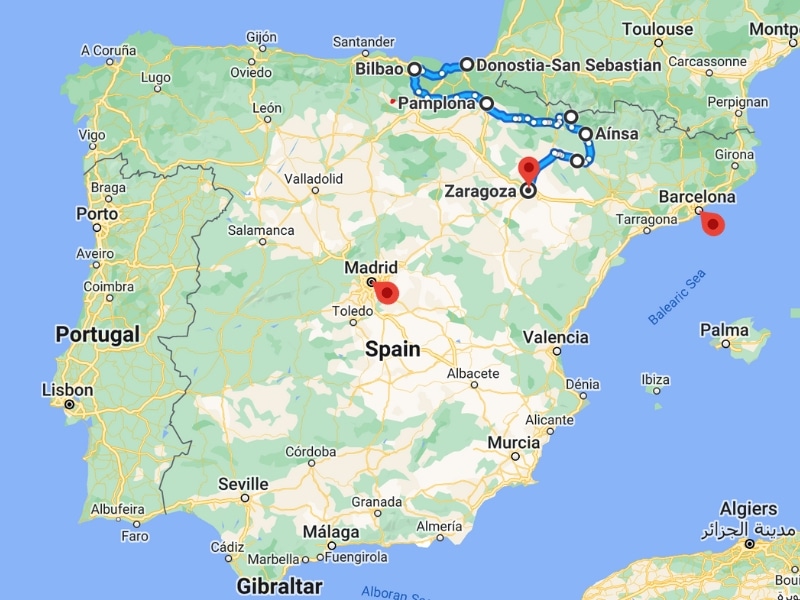
This northern Spain itinerary takes in the cities and coasts of the Basque Country, and the magnificent Pyrenees mountains that extend for more than 400 kilometers between Navarre, Aragon, and Catalonia, and create a natural barrier between the Iberian Peninsula and the rest of continental Europe.
Start in Donastia-San Sebastian, the jewel in the crown of the Basque resorts. A picturesque city with fabulous beaches, San Sebastian is perhaps best known as a foodie town, with some of the finest restaurants in Spain gracing its leafy boulevards and squares of the city center.
Bilbao makes a natural next stop and now rivals Donosti, as it’s known locally, as one of the top coastal cities in Spain. The beautifully curved and sweeping architecture of Museo Guggenheim and the fine Basque cuisine and freshly caught seafood served in its lively restaurants and bars make Bilbao a worthy stop.
In the northern Spain foothills of the Pyrenees, Pamplona is a town with a compact and enticing casco antiguo and a hulk of a citadel to visit. From its powerful fortress city history to the modern-day Fiestas de San Fermin (Running of the Bulls festival), this city is as swashbuckling and red-blooded as they come.
Visit in early July for the festival and nine days of riotous partying and entertainment, but book early as thousands of visitors descend and everything gets booked up at least nine months in advance.
From Pamplona, the mountains are enticingly close. Torla-Ordesa is the nearest village to the breathtaking Ordesa y Monte Perdido National Park where you can explore lush meadows, gushing waterfalls, and incredible gorges formed by glaciers millions of years ago.
The best way to see all this natural beauty is to hike the Circo do Soaso, a Pyrenean cirque that surrounds the vast Ordesa Valley. With sheer walls stretching up the 3,355m peak of Monte Perdido looking down, and over twenty cascades along the tumbling Rio Arazes to accompany your hike, this will undoubtedly be the highlight of your Pyrenees road trip.
Capital of the old kingdom of Sobrarbe, which became part of the kingdom of Aragon in the 11th century, Ainsa is a fantastic example of medieval city design and has the best views back to Monte Perdido from the preserved citadel.
From here, it’s south to Zaragoza, famous for the Baroque Nuestra Señora del Pilar basilica, a pilgrimage site with a shrine to the Virgin Mary and the Mudéjar-style Aljafería Palace, an 11th-century Moorish palacio. Together with La Seo Cathedral, the Mudéjar architecture of Aragon forms a UNESCO World Heritage Site.
And now you have a choice! From Zaragoza, it’s almost equidistant to Madrid or Barcelona, give or take 10km. So, Spain is now your oyster and you can go south for the museums and classical architecture of Madrid, or east for the laid-back vibes of Barcelona.
- Arriving at the Cola de Caballo horsetail waterfall at the far end of the Ordesa Valley, and having lunch under the mist.
- Sample the Basque seafood cuisine, like baked spider crab and clams marinière in the old town of San Sebastian.
- Watch the bulls (from a distance!) get a fair chance at Pamplona’s Fiestas de San Fermin.
San Sebastian ⇒ Zenit Convento San Martin for its central location, stylish decor, and rooftop pool.
Pamplona ⇒ Pamplona Catedral Hotel for its beautiful design, friendly customer service, and very comfy beds.
Zaragoza ⇒ Hotel Sauce for cozy rooms, great location, and exceptional homemade breakfast in their bakery.
RELATED POST: How to Hike the Circo de Soaso and Ordesa Valley
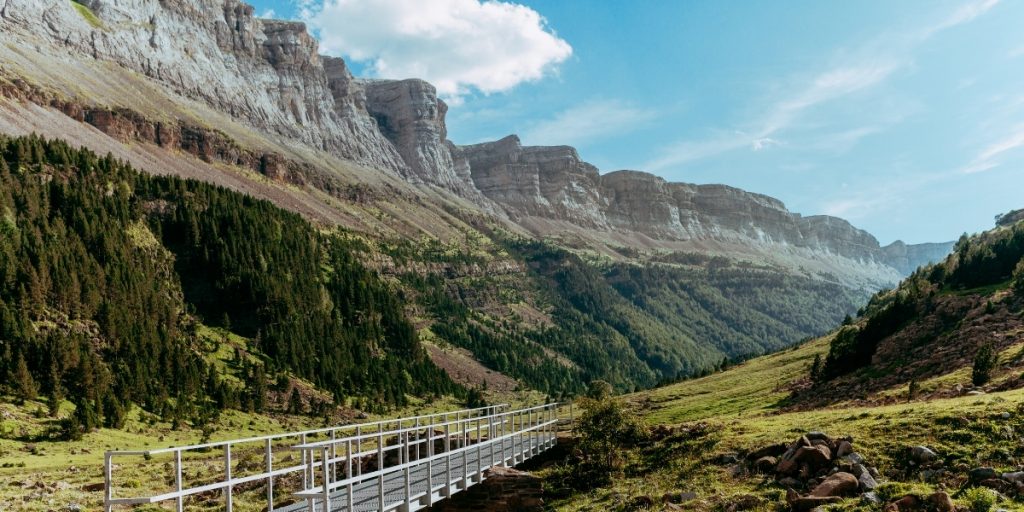
Malaga – Marbella – Ronda – Cadiz – Jerez de la Frontera – Seville – Antequera – Cordoba – Granada – Malaga
- Distance: 1041km
- Duration: 10-14 days
- Drive Time: 13 hours
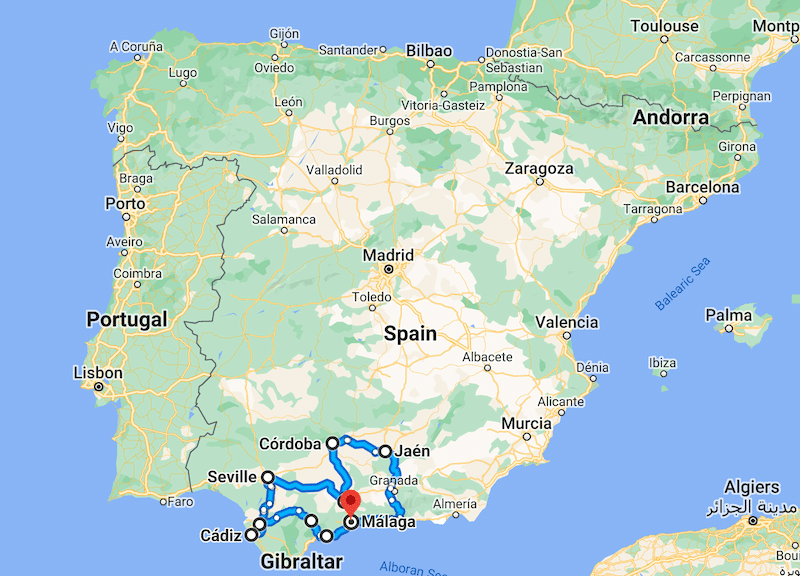
Andalucia in the south of Spain is the quintessential Spanish region and is home to some of the most colorful and vibrant cities in the whole of the country. Heavy with Moorish influence, evident in the fantastic food and historic architecture, the cities of Andalucia are a feast for the senses.
This south Spain road trip starts on the Costa del Sol, in the lively coastal city of Malaga , which comes to life on the seafront. A favorite place for Malaguenos to go for a stroll post siesta , a fiercely protected custom in the south of Spain, the seafront comes alive after 5pm. You’ll find whole families out, enjoying the sunshine and stopping for a beer and tapa along the paseo .
From Malaga, the seaside resort of Marbella beckons, where you can spend a day soaking up the sun on one of the three immaculately kept sandy beaches and enjoying the people-watching before visiting the charming old town. Head for Plaza de los Naranjos at the center of the Casco Antiguo and enjoy a coffee whilst watching the world go by. For lunch, find Taberna Casa Curro Marbella where you’ll enjoy great tapas and fruity Spanish wine.
Up next is beautiful Ronda, surrounded by the dramatic mountains of Sierra de Grazalema and Sierra de las Nieves. The drive from Marbella to Ronda is simply stunning, with white villages on every hillside and spectacular views as the road dips and swoops between lakes, valleys, and peaks.
Known for its Ronda its arched bridge of Puente Nuevo which spans the 120m deep river gorge of El Tajo, the bridge is best seen from the beautiful La Casa del Rey Moro , where you’ll find lush and fragrant gardens and a spectacular view. There’s also a spectacular bullring here, and whatever your views about the divisive sport of bullfighting, you should visit Plaza de Toros.
Just north of Ronda are the Pueblo Blancos of Zahara de la Sierra and Setenil de las Bodegas. Both are worth visiting, and the latter is known for its whitewashed houses built into the surrounding cliffs and that image, the one with the rock covering half the narrow street and its houses.
The faded splendor of the sea city of Cadiz , one of the oldest cities in Europe, will beguile you. Just across the water in the famed sherry triangle is Jerez de la Frontera, the home of sherry since the 14th century. The nearby towns of Sanlúcar de Barrameda and El Puerto de Santa María are the other points of the triangle.
Make sure to stop for a tour of a sherry bodega for a taste of Spain’s most famous alcoholic drink. Whatever you think you know about sherry, think again!
As well as sherry, Jerez is also famous for its flamenco tradition and is one of the best places to watch the steamy and seductive dance whose name literally means ‘hell-raising’!
Next is hot and steamy Seville, one of the most popular places in Andalucia, if not Spain! Seville boasts the Gothic Seville Cathedral, the imposing Giralda Tower, and the stunning Alcazar, all conveniently clustered together in the historic center, and located right next to the narrow streets of the Barrio Santa Cruz, the heart of Seville’s lively tapas culture offering some of the best plates in Andalucia.
Past the ancient dolmens and lover’s rock of Antequera is Cordoba, known for the UNESCO Mezquita mosque cathedral, which will take your breath away when you step inside for the first time. Meander through the nearby Jewish quarter where you’ll find narrow lanes and pretty squares where many of the whitewashed houses are covered in blooms from window boxes providing the perfect images of this gorgeous city.
Next up is one of Spain’s most underrated cities. Well off the beaten path, Jaén is known for its olive oil production, and its medieval fortresses, including Santa Catalina Castle. The Renaissance Jaén Cathedral houses the Holy Veil which is said to have been used to wash Christ’s face.
From Jaén, it’s a beautiful drive south to Granada, in the Sierra Nevada mountains and very possibly Spain’s most romantic city. The Alhambra, the spectacular Moorish palace sits high on a hill overlooking Albaicin, the old town of Granada, and is the jewel in Andalucia’s crown.
Finish this southern Spain road trip by hitting the Costa Tropical and the seaside resorts of Almuñécar, Salobreña, La Herradura, and Nerja.
- Watching live Flamenco in Seville , passionate, sensual, and a true art form.
- The Alhambra Palace is the most exciting and romantic of all of Europe’s ancient palaces.
- The Mezquita in Cordoba is one of the most spectacular mosque cathedrals in the world.
Malaga ⇒ Hotel Molina Lario for its perfect location, buzzy rooftop bar, and incredible cathedral views.
Seville ⇒ Case del Poeta for its perfect Santa Cruz location, live Spanish guitar gigs, and stunning roof terrace views.
Granada ⇒ the Hotel Santa Isabel la Real for cozy rooms, spectacular Alhambra views, and an exceptional cooked breakfast.
RELATED POST: The Perfect Andalucia Road Trip: Itinerary, Map & Tips
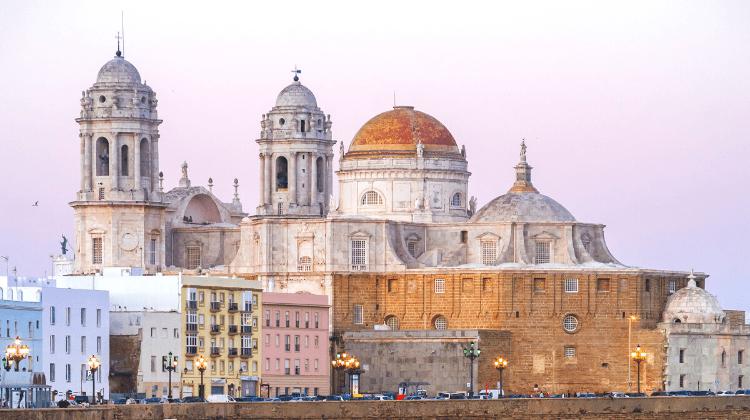
Looking for the best SIM card deals in Europe for your trip? Check out our guide to the best data SIMs in Europe and get the best deal for your trip to Spain.
East Coast Costas
Valencia – denia – xabia – altea – alicante – cartagena – almeria.
- Distance: 553km
- Drive Time: 8 hours
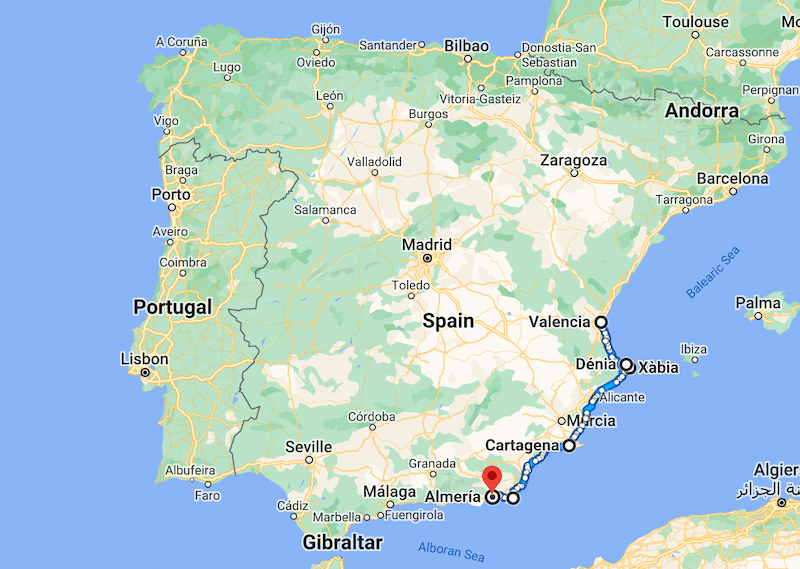
This delightful and easy seven day trip down Spain’s eastern Mediterranean coast bypasses the worst of the high-rise excesses and explores the best of the Spanish Costas, including some you’ve never heard of! Costa de Valencia, Costa Blanca, Costa Calida and Costa de Almeria.
Valencia is a seriously underrated city and is preferred by many Spaniards to Barcelona. The city is much less touristy than Barcelona but has the cultural variety of Madrid and the charm of Seville. Alive with noise and color, the city will surprise and delight you.
Visit Valencia during the fabulous Las Fallas when the city erupts with bonfires, music, and life. Don’t forget to sample a traditional drink of horchata (made from tiger nuts) when you’re in Valencia, it’s not to be missed!
Head south and make for La Albufera, a huge lagoon separated from the sea by a sandbank and surrounded by rice paddy fields, still irrigated by systems installed by the Moors.
An important wetland and the stopping-off point for thousands of migratory birds, the area is also where paella originated, due to the perfect growing conditions for rice. You can take a guided tour through the lagoon on a boat trip, and check out the ‘paella’ villages, including Perel-Lonet, the best place to get a taste of the real thing, not with seafood but with chicken, rabbit, and snails.
Next up is the old port town of Denia, less touristy and ex-pat, and the closest departure point in Spain for the Balearic Islands. From here, you can sail to Ibiza, Formentera, and Palma, to start your Mallorca road trip (if you have a few extra days!).
There’s more to Denia than the port though. Home to a modern marina surrounded by cool bars and an old town lined with fish restaurants and Spanish fusion food, this is a wonderful place for an overnight stop. Check out our favorite, Els Magazinos, for street food Spanish style.
Javea, or Xabia in the local dialect of Valenciano, is a pretty seaside resort close to Cabo de la Nao, a beautiful rocky promontory where you’ll find hidden coves and beaches. Lively in the evenings in summer, you’ll also find a beautiful sandy beach and a pretty old town.
For the best beach in the area, head south by around 5km to Playa la Barraca, a shingle beach with perfect turquoise water and a fantastic seafood restaurant.
Altea is your next stop, a small resort that sits below a historic hilltop village, which has incredible views. The old village is gorgeous with bougainvillea and jasmine in bloom, alongside alleys lined with alfresco dining and interesting boutiques and gift shops.
Bypass built-up Benidorm and head for the very Spanish city of Alicante, with its wide and spacious esplanades and seafront paseo. The renovated old town is a perfect place to stroll and people-watch, especially in the early evenings. You’ll also find good tapas restaurants and bars in this area.
Swing by the pink lake at Torrevieja . Las Salinas Torrevieja is a real sight, with its bubblegum pink water and fascinating history of salt production.
Head south, ignoring the outskirts of Cartagena, and make for the medieval narrow and twisting streets of the old town. The city will surprise you with its eclectic architecture, historic sites, and modern feel.
It’s quite a long drive down this part of the coast but the unspoiled and undeveloped resorts of Aguilas and El Puerto de Mazarron make good stopping points before arriving in the wild and beautiful region of Almeria , one of the driest places in Europe and home to some weird and wonderful landscapes and coastal rock formations, both on dry land and in the surrounding sea.
The Cabo de Gata particularly is a scuba diving hotspot and a kayaker’s and hiker’s paradise, and whales are sometimes spotted along these shores.
- The authentic and vibrant city of Valencia, where there are more Spanish than visitors.
- Exploring the gorgeous Mediterranean beaches of the Cabo de la Nao that are perfect for snorkeling.
- The sheer exuberance of Alicante, with its magnificent beaches and atmospheric old town.
Valencia ⇒ One Shot Mercat 09 for its historic location, rooftop pool, and hip vibe.
Alicante ⇒ Melia Alicante for its stunning views, casual style, and excellent service.
Cartagena ⇒ NH Cartagena for its central location, contemporary style, and welcoming feel.

More Spanish Travel Inspiration
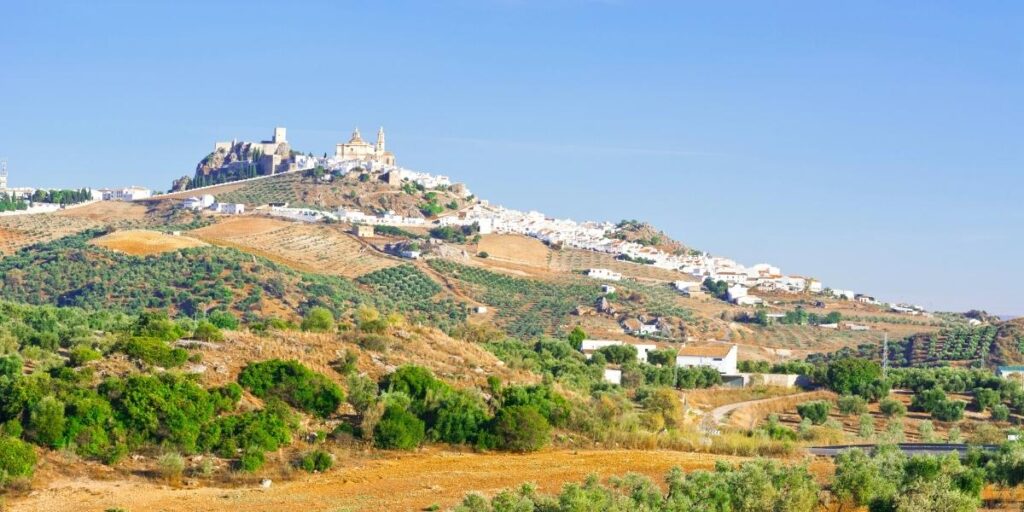
The Perfect Andalucia Road Trip: Itinerary, Map & Tips
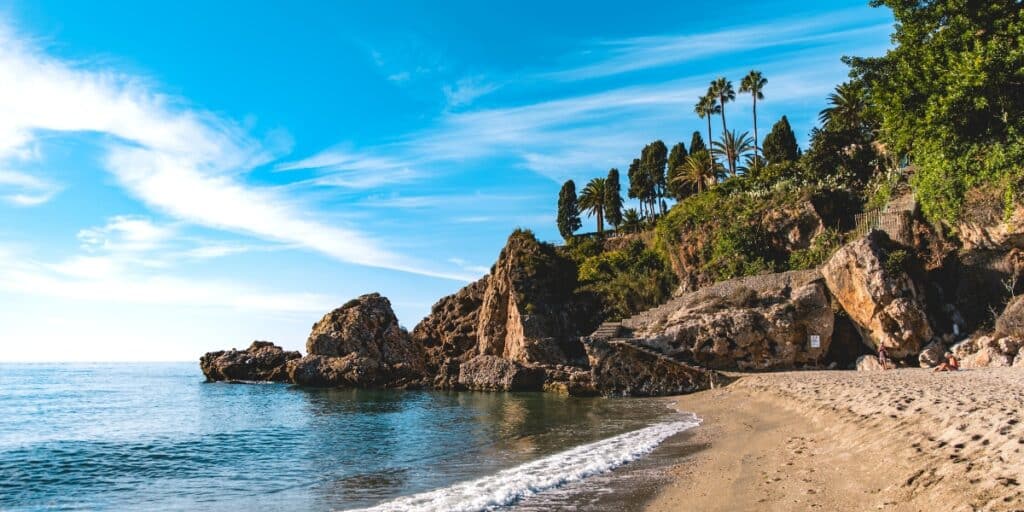
Wintering in Spain: Best Winter Destinations in Spain
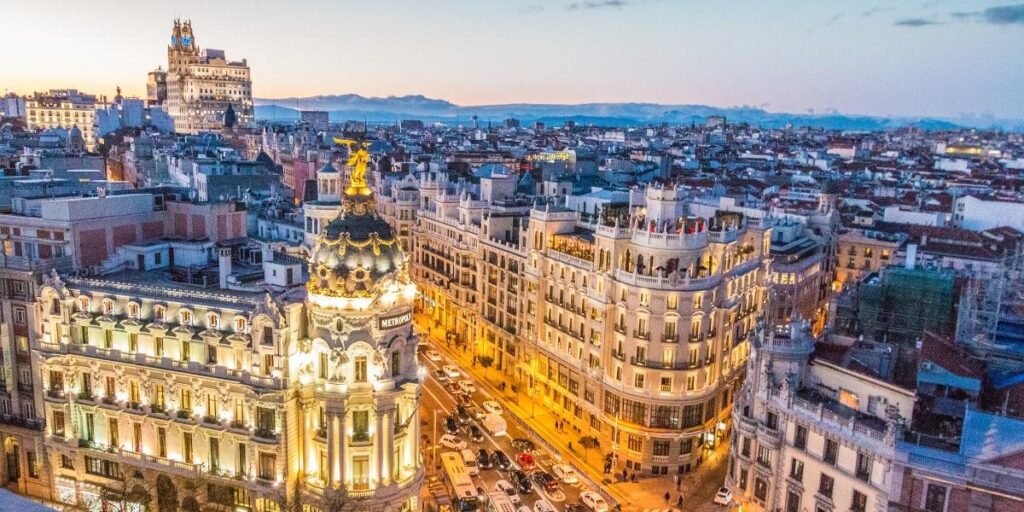
Madrid in One Day – Itinerary, Map, Tips & Guide
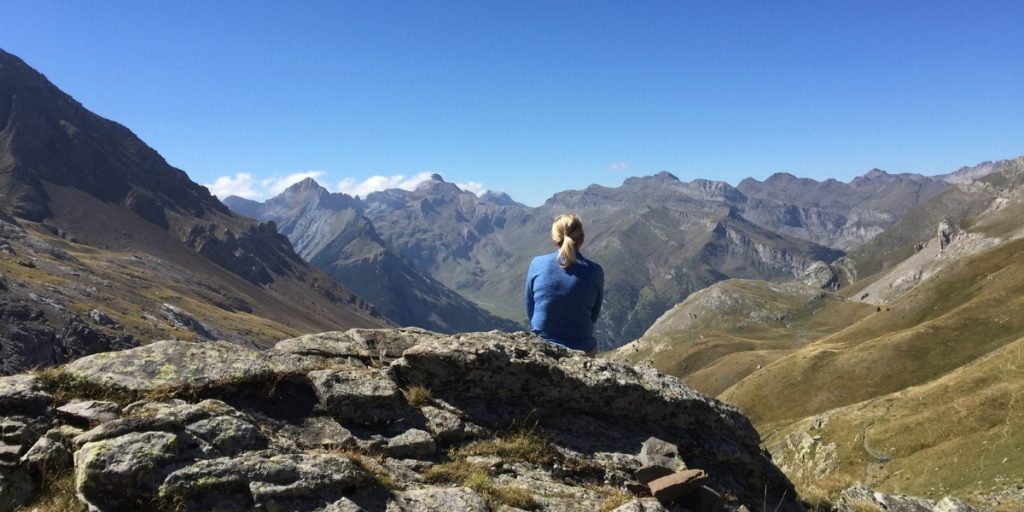
A Seven Day Pyrenees Hiking Tour

One Day in Barcelona – Itinerary, Map, Tips & Guide
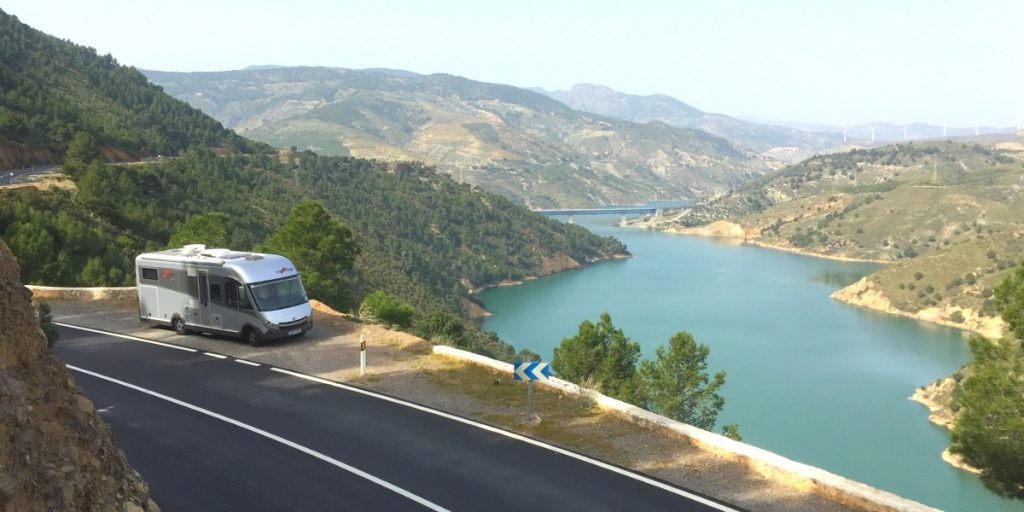
Motorhoming in Spain: Your Complete Guide for 2024
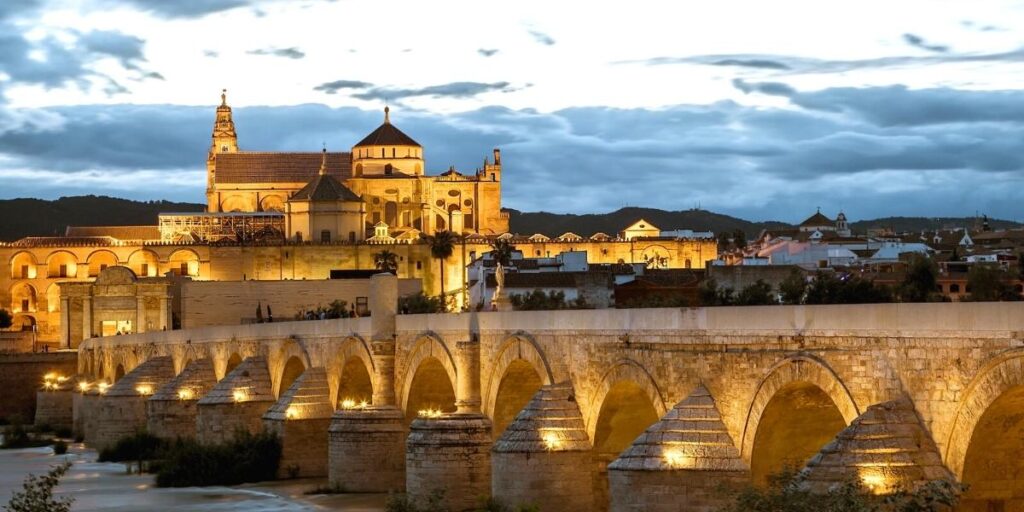
Cordoba in One Day – Itinerary, Map, Tips & Guide
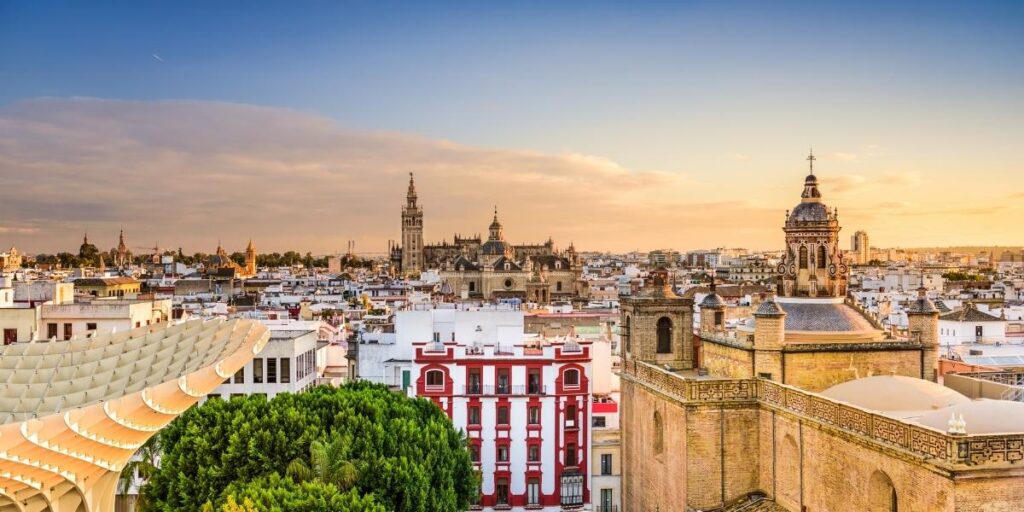
One Day in Seville – Itinerary, Map, Tips & Guide
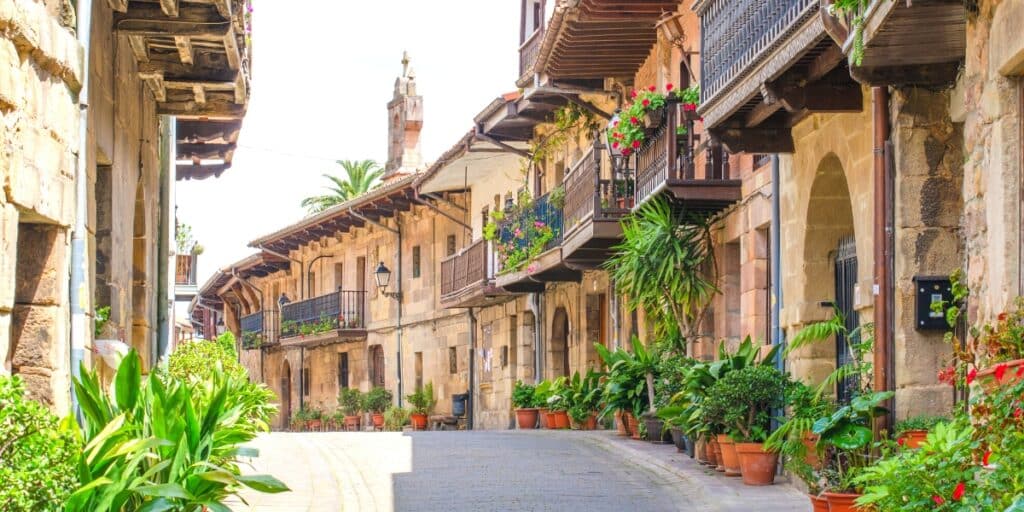
North Spain Road Trip: Itinerary, Route & Tips
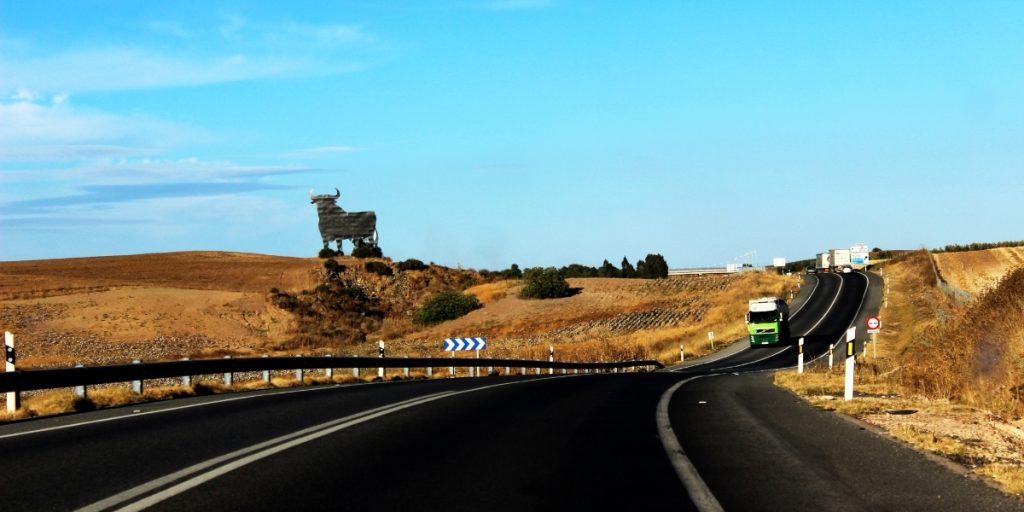
Driving to Spain from UK: Best Routes & Driving Tips
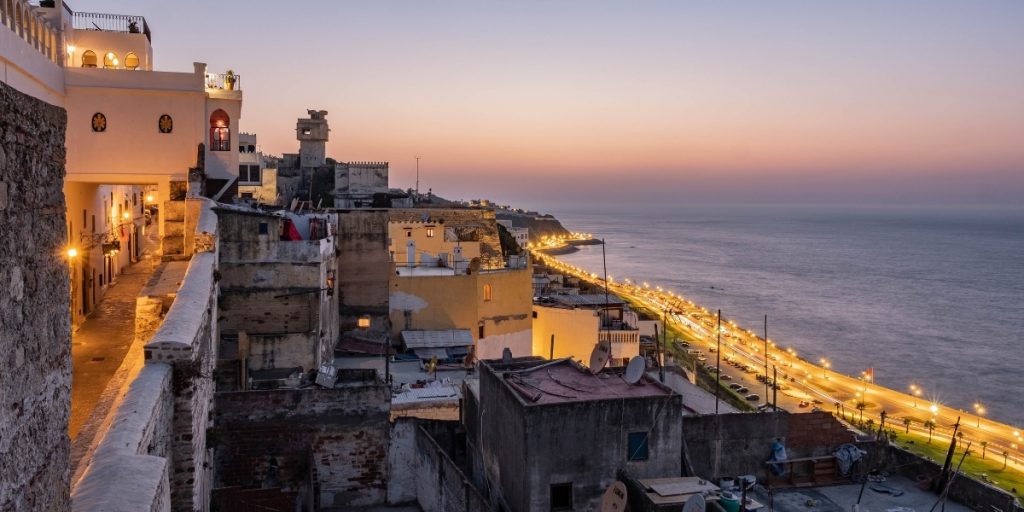
Tarifa to Tangier: Tips & Tricks for a Day Trip to Morocco
Central spain.
Madrid – Toldeo – Cáceres – Ciudad Real – Consuegra – El Toboso – Cuenca – Madrid
- Distance: 1085km
- Duration: 10 days
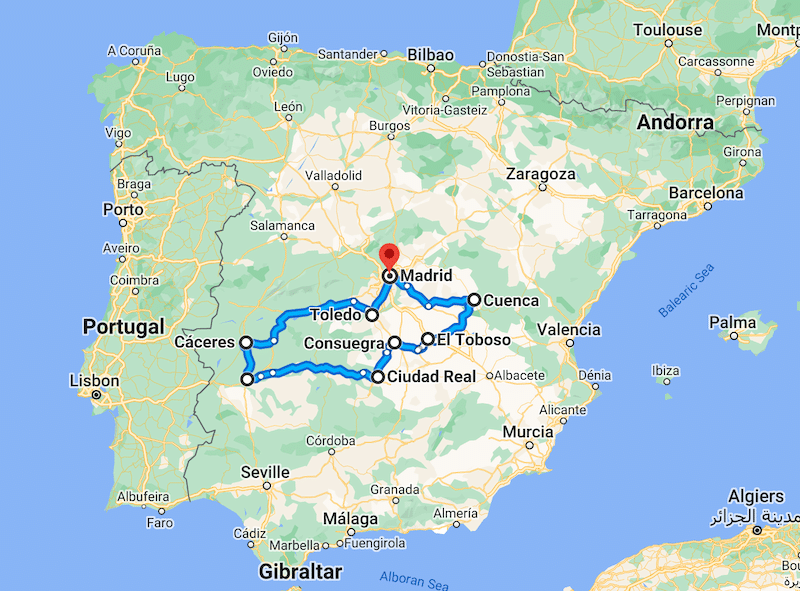
This road trip from Madrid explores the wild and windswept plateau of Castilla-La Mancha and Extremadura, parts of Spain’s interior that are really on the road less traveled. Amongst the hidden gems and architectural surprises expect abandoned villages and huge swathes of, well, nothingness.
For us, the the rolling steppe and vast plains, rich with birdlife and craggy outcrops more than compensate for its remote nature and long hours on the road.
Toledo is up first, and what a start to your road trip! An ancient city set on a hill above the plains, Toldeo is known for the medieval Arab, Jewish, and Christian monuments in its walled old city, giving rise to its name ‘City of the Three Cultures’. There’s also a connection with Hannibal who used extra-hard Toledo steel for his swords in the Punic Wars.
It’s a gorgeous drive through forests and rolling plains to medieval Cáceres, a UNESCO jumble of narrow alleys, castles, palaces, and squares, where it’s easy to while away a few days eating tapas and admiring the olive trees growing in serried ranks across the rolling lands which surround the town.
Ciudad Real is a quick stop to admire the 14th century Puerta de Toledo, one of the city’s original Mudéjar-era gates, and visit the Quixote Museum, dedicated to Miguel de Cervantes’ classic Spanish novel, Don Quixote .
Next up, riding the Cerro Calderico mountain and with the 12th century Castle of La Muela as a backdrop, are the Consuegra windmills, a line of twelve tower mills described in the story of Don Quixote , that are one of the most iconic landmarks in Spain.
Initially built to grind grain, the mills were modeled on the Dutch windmills of the 16th and 17th centuries. These tower mills were passed down through the generations until being retired in the 1980s when twelve of the original thirteen mills were restored and opened as a tourist attraction.
El Toboso is your next stop. Famous for being the hometown of the fictitious Dulcinea, lover of Don Quixote, El Toboso has a great many pretty corners and traditional buildings of masonry and whitewashed walls. Don’t miss the House of Dulcinea, a traditional La Mancha structure from the 16th century, which has been beautifully renovated.
Your final stop before returning to Madrid is Cuenca. Founded by Moors, Cuenca is perched on a limestone spur above the Júcar and Huécar rivers and has a historic Walled Town with steep cobbled streets and medieval castle ruins. Cueunce is most famous for its well-preserved casas colgadas , or hanging houses which are dramatically cantilevered over the Huécar gorge as they cling to the cliffside.
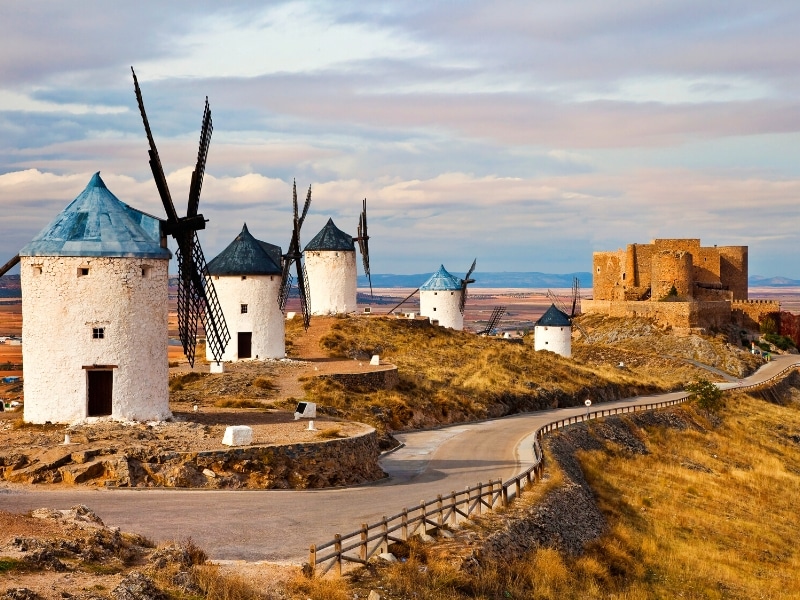
Green Spain
San sebastian – bilbao – comillas – oviedo – a coruna – santiago de compostela.
- Distance: 838km
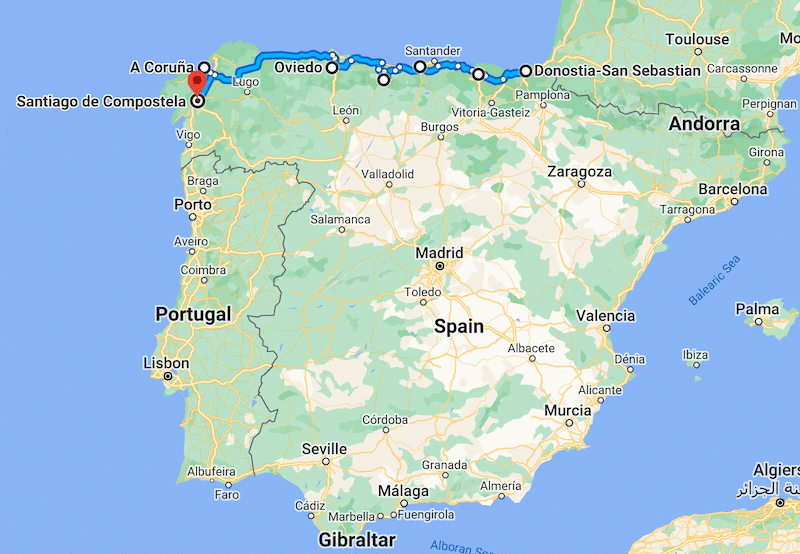
This north of Spain road trip will take you through the beautiful and lush, aptly named Green Spain, hugging the north coast along the Atlantic Ocean.
From San Sebastian through Cantabria, Asturias, and Galicia, you’ll see some of the most picturesque landscapes in Spain, enjoy amazing food, and crisscross the famous Camino de Santiago .
Start in gorgeous Donastia-San Sebastian, the most well-known of the Basque resorts. A picturesque seaside resort with fabulous sandy beaches, San Sebastian is known as a foodie town, and deservedly so. There is a great collection of fine restaurants and authentic pintxo bars here, serving world-class food produced from local ingredients.
Next is Bilbao, home of the incredible Museo Guggenheim and backed by beautiful green mountains. The museum itself is a work of art, with beautifully curved and sweeping architecture.
Bilbao now rivals San Sebastian as one of the top coastal cities in Spain , with its vibrant restaurant and bar scene, and offers fine Basque cuisine and freshly caught seafood in its atmospheric restaurants and bars.
Head west to the stunning Santillana del Mar, known as the town of the three lies. Not holy (santi), not flat (llana) nor by the sea (del mar) . This medieval town is well-preserved and worth a meander before you make your way to Comillas, further along, the coast.
Traditionally low-rise, you’ll find a lovely beach, a tiny fishing port, and a charming cobbled casco antiguo here. If you have a few extra days, head into the Picos de Europa National Park for excellent hiking in the beautiful peaks of this small, but perfectly formed mountain range.
Oviedo is the next stop and the starting point of the lesser-known Camino Primitivo (the oldest Camino). This compact and elegant city is another foodie delight, with a vibrant gastronomic scene.
Home to Spanish cider, you’ll find traditional sidrerías along Calle Gascona, known as Cider Boulevard. Visit in September for Fiestas de San Mateo, a live theatre and music spectacular. If you go in October, you’ll be in the middle of the apple harvest in Asturias, a region in which you could easily spend several weeks .
A Coruña is up next, passing by the spectacular Playa de Las Catedrales en route. The ‘beach of the cathedrals’ is one of Spain’s top natural landmarks and is best visited at low tide , when its possible to walk on the beach and get up close to the fabulous rock formations.
A Coruna is a dynamic city that is home to a busy port, a relaxed beachfront resort, and an atmospheric old town. The seafood here is some of the freshest and most delicious in Spain, with seafood tapas being a specialty. Take a walk out to the Tower of Hercules, a lighthouse that looks nothing like a lighthouse!
Finally, you’ll reach Santiago de Compostela, the end point of the famous Camino de Santiago, and your last stop. As you enter the city, you’ll see pilgrims covering the final few miles and proudly displaying their Vieira, the scallop shell badge that you’ll have seen along your route .
The UNESCO World Heritage Site of Santiago de Compostela is undoubtedly one of the most beautiful cities in Spain, full of labyrinthine alleys, dramatic squares, and historic religious buildings.
There are too many must-sees to list, but consider a walking tour with a local guide if you don’t have much time, you’ll get to see the most important things and learn about the history of the city too.
It’s a hop and a skip from here into tiny Portugal, via fascinating Vigo. Portugal packs a powerful punch with incredible coastlines and vibrant cities and a Portuguese road trip makes the perfect complement to your Spanish road trip.
- Visit the highly recommended Guggenhei m Museum Bilbao and be awe-struck by both architecture and art.
- Explore the cathedral in Santiago de Compostela and make the climb to Las Cubiertas , the cathedral roof, for incredible views of the city and the landscape beyond.
- Walk along the boardwalks at Playa de Las Catedrales and marvel at the extraordinary natural arches and racing sea.
Bilbao ⇒ Hotel Tayko for its minimalist style, hip location, and excellent restaurant.
Oviedo ⇒ Barcelo Oviedo Cervantes for its laid-back vibe, modern decor, and smooth service.
Santiago de Compostela ⇒ Parador De Santiago de Compostela for its history, traditional decor, and HUGE breakfast buffet.
RELATED POST: North Spain Road Trip: Itinerary, Route & Tips
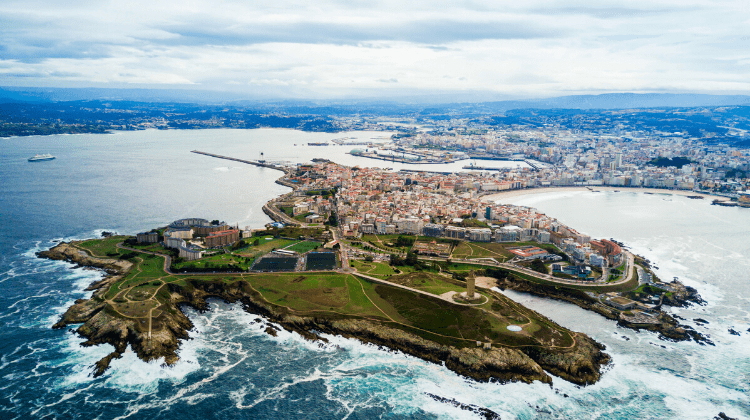
Madrid – Salamanca – Santiago de Compostela – San Sebastián – Barcelona – Valencia – Alicante – Almeria – Granada – Malaga – Cordoba – Seville – Cáceres – Toledo – Madrid
- Distance: 3791km
- Duration: 3-4 weeks
- Drive Time: 38 hours
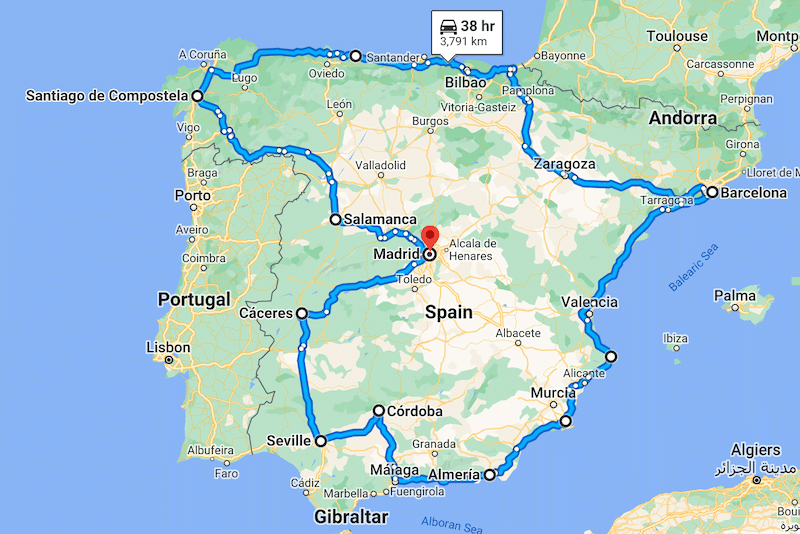
If our seven great driving tours of Spain have whet your appetite but you have a bit more time and want to experience all that Spain has to offer, why not try this combination of all our Spain road trips together?
Stop in the major cities on this eclectic itinerary, and take day trips as you go to see the main attractions along the route. Enjoy local gastronomy, learn about regional customs, and marvel at the variety that Spain has to offer.
From coast to mountains and taking in all the major cities and must-see places, this ultimate Spain road trip will give you the drive of your life and show you the best of Spain in all its wonderful guises.
Want to plan your own road tri p? Get our step-by-step road trip planning guide to help you organize the perfect trip., or check out our favorite road trips in Europe for inspiration.
Planning Your Spain Road Trip
Spain road trip resources.
Here are the websites and services we personally use and recommend for traveling in Spain.
- Search for affordable flights to Spain with Skyscanner
- Search for availability and book hotels and accommodation in Spain with Booking.com
- Find and book the best campsites in Spain with Eurocampings
- Book the cheapest and most reliable hire cars in Spain with Rentalcars.com
- Find and hire your perfect motorhome or campervan with Motorhome Republic
- Get highly rated, reliable, and trustworthy travel insurance with True Traveller
- Check if you need a visa and arrange your documents with Visagov
Best Time to Visit Spain
Spain has varied weather and different climate systems, depending on where you are in the country.
The weather of Spain in spring is just perfect for those who want to enjoy the beautiful climate and it’s no wonder that this is also considered to be one of the peak seasons for travelers in Spain.
From March to May, the weather is pleasantly warm and you definitely won’t need your winter woolies! You may need a long-sleeve top for the evenings, and if you’re visiting the north of Spain, it’s a good idea to pack a cozy fleece or jumper and a waterproof.
A visit in spring also offers the opportunity to experience Easter or Semana Santa . Catholics in Spain celebrate Holy Week through traditions that commemorate the crucifixion and resurrection of Jesus and each day has its special traditions, like processions on the streets and bringing olive branches to church. It really is a spectacle, and best seen in Seville or Granada.
Summers in Spain can be punishingly hot, especially in the south, and there will be a greater influx of European tourists heading to the popular beach resorts and historic cities, although most Spaniards will stay at home during these months.
Lower temperatures in the green north make it a great option during the summer, but be aware that prices for flights, accommodation, car hire, and activities increase everywhere.
Similar to spring, fall sees milder temperatures and fewer visitors, making it a good option for a post-summer break. Spain turns the most beautiful shades of russet and yellow during fall and hotels and other accommodation are reasonably priced at this time.
Winter temperatures are where the extremes really show. Northern Spain may see snow and Madrid in winter can be super cold, just as Malaga is one of the hottest winter destinations in Europe with the sea warm enough to swim in!
This is also a good time for budget travelers to plan Spain trips as prices tumble and there are real bargains to be had. Avoid the north and Pyrenees though, which regularly see snow in winter.
RELATED POST: Autumn in Europe: 23 Stunning Destinations for Fall
Fiestas in Spain
Right across Spain, from the largest cities to the smallest villages, fiestas or parties, are an important annual marker and a great excuse to celebrate life.
Usually held to mark a religious day, these riotous parties are one of the greatest pleasures of traveling in Spain.
The streets are adorned with decorations, street food is prepared, wine flows, and live music is played as people come together. Everyone is welcome; to visit Spain and not join a fiesta is to miss the ethos and spirit of this country entirely.
You can find a fiesta calendar here to help you plan your trip and coincide your visit with the best of them.
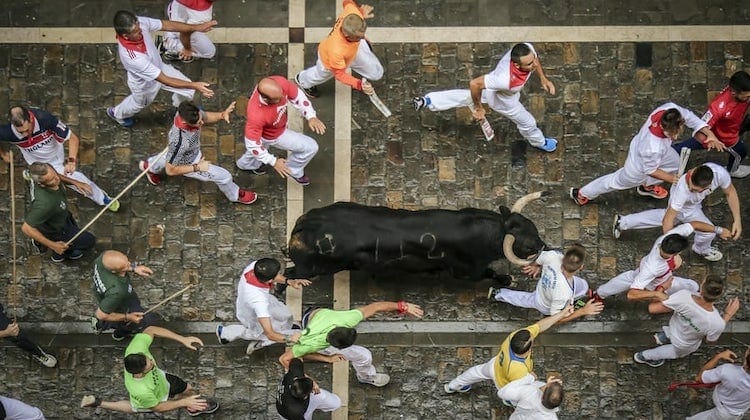
Driving in Spain
Car travel in Spain is easy, with a good network of Autovias (A) and Autopistas (AP). The latter were toll roads until 2020 when many (but not all) became toll-free.
Fuel and car hire are some of the cheapest in Europe making Spain a really cost-effective place to take a road trip.
Touring Spain by car in rural and mountainous areas can take longer than you think although the standard of non-motorway roads in rural areas is generally good. Allow time to get off the beaten track and experience the real Spain as you tour this fabulous country.
Whether you’re driving your own vehicle to Spain or you’re in a rental car, follow our driving in Spain tips;
- You must have at least three months remaining on your passport (issued in the past ten years) at your intended date of departure from Spain.
- You must have at least 3rd party insurance for your vehicle when you roadtrip Spain.
- Citizens of non-EU third countries may require an IDP, you can check here .
- You must carry two warning triangles for the front and rear. These warning triangles are now being phased out and from 1st July 2021, a new law requires that a V16 flashing emergency light is used, although both means of advising other traffic will be legal until the end of 2024.
- You must also carry a reflective jacket (for the driver and all passengers) a spare wheel and the tools to change a wheel or a tire repair kit.
- If you wear glasses you must also carry a spare pair in the vehicle.
- UK cars will need headlight beam converters to be fitted (unless they adjust automatically).
- The use of winter tires in Spain is regional. Look out for traffic signs indicating that winter tires or snow chains are compulsory where you are.
- Anything with a screen (television, video, DVD, etc.) that could distract you when driving should be positioned where you can’t see it. This doesn’t apply to a sat nav but you must not touch or program your sat nav unless parked in a safe place.
- Using radar detection equipment is prohibited under Spanish law and new regulations from January 2021 mean that it will also be illegal to be in possession of such equipment .
- On roads with single carriageways, the speed limit established may not be exceeded by more than 20km/h when overtaking.
- Free parking is almost impossible to find in Spanish cities. A better way is to book a hotel or accommodation with its own parking.
Are you looking for more incredible road trips? Check out these top posts…
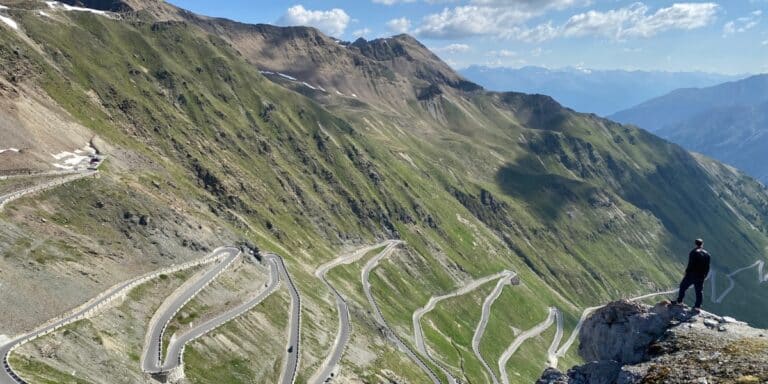
Stelvio Pass: The Best Mountain Road in Italy?
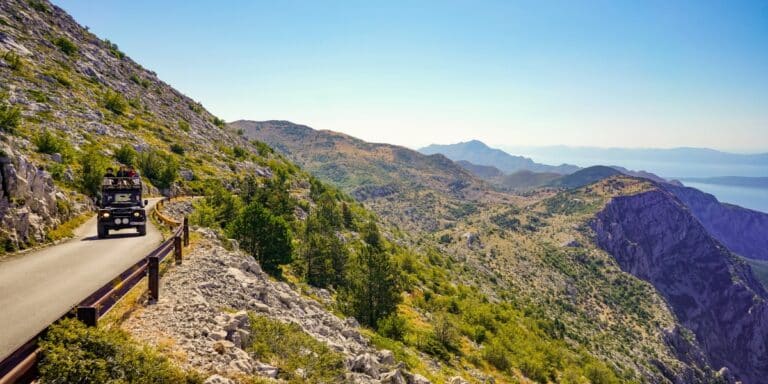
Croatia Road Trips: Five Incredible Routes
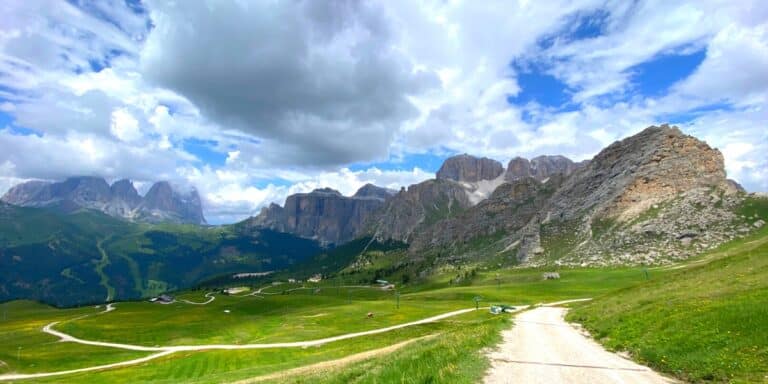
Dolomites Road Trip: Explore the Best of Northern Italy
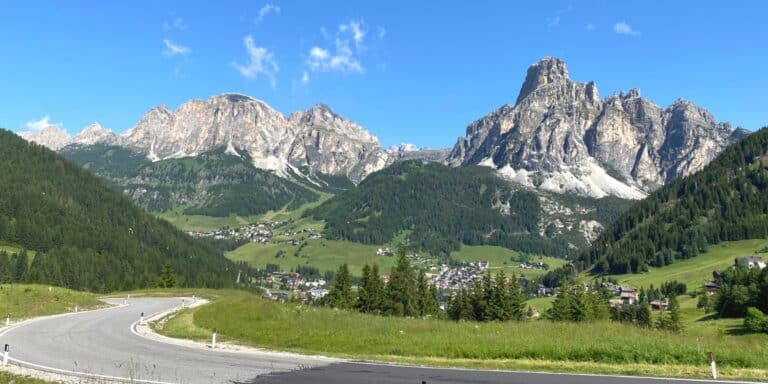
Great Dolomites Road: Absolutely Everything You Need to Know!
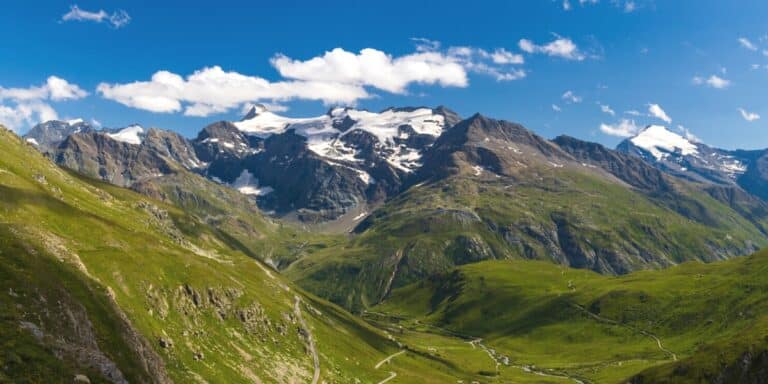
Route des Grandes Alpes: An Epic French Road Trip
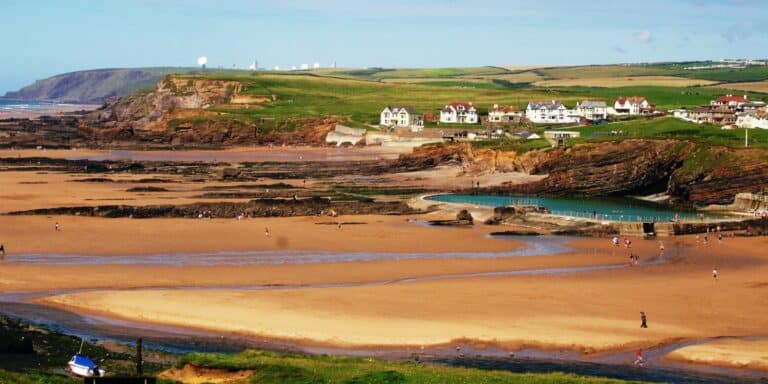
Atlantic Highway: An Epic Devon & Cornwall Road Trip
Love it pin it.
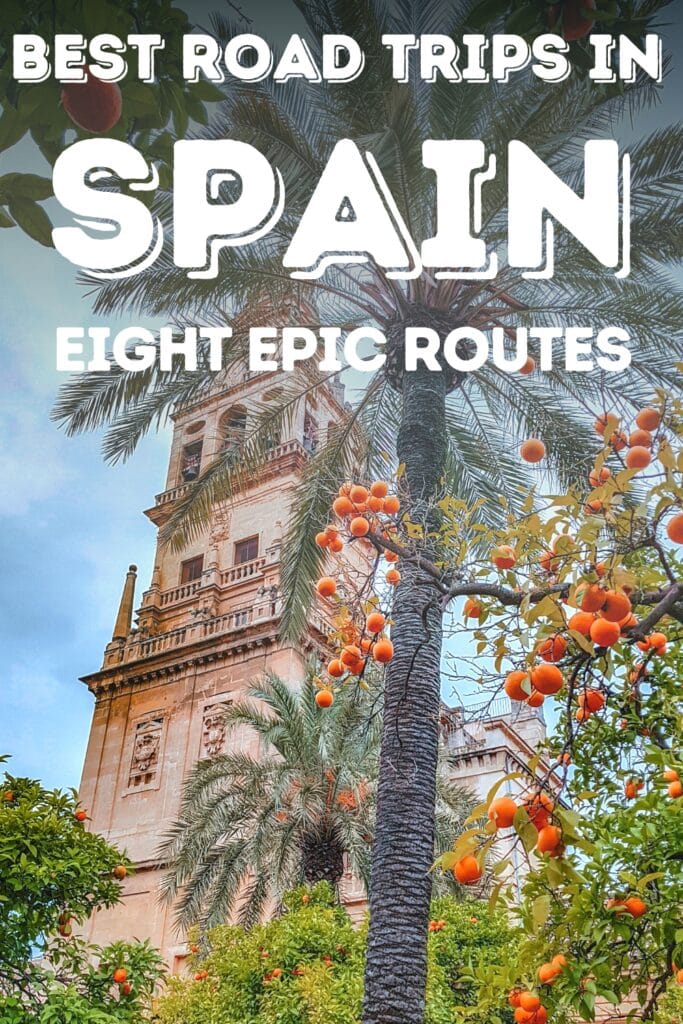
Drive in Spain with an international driver’s licence

You should definitely get an International Driver’s Licence if you intend to drive during a road trip around Spain .
Please note that in Spain, as of May 1st 2008, driving without a license is a criminal offense, and punishable with imprisonment. Furthermore, it could render your vehicle insurance, including compulsory third party insurance, null and void.
Have a look at a complete guide on where to book your rental car online .
Table of Contents
What’s the International Driver’s Licence?
It’s basically a translation of your existing drivers license into different languages, and provides some identifying information. In fact, the document has a picture of you, your name and date of issue on it.
You must use in conjunction with a valid driving license issued in your home country. It’s not intended to replace it. It’s usually valid for a year after its date of issue (NOT a year after the date you arrive in Spain) and NOT renewable.
If you plan to stay longer than one year in Spain you’ll need to apply for a Spanish driver’s license.
Do you need an International Driver’s Licence?
One of the recurrent questions I usually get is the following:
“Do I need an International Driving Licence in Spain?”
Well, there’s not a “yes” or “no” answer since it depends on your nationality.
You’re a European Union national
Spain is a member of the European Union. And in the same way we Spaniards are allowed to drive in other countries members of the UE using our Spanish license, citizens of the European Union can drive in Spain with their national driving license – for as long as it is valid, of course.
So, if you’re Irish, German, French, Dutch, or Austrian, to mention just a few of the EU country members, you’ll only need to bring your home country driving license to Spain.
You’re a member of the European Economic Area
The European Economic Area, also known as EEA, is formed by all European Union countries and a few others that don’t belong to the UE. Namely Norway, Iceland and Liechtenstein.
Citizens from the EEA can drive in Spain with their national driving permit.
So if you’re Norwegian, Icelandic or from Liechtenstein, you can drive in Spain with your home country driving license only.
You’re a UK national
Now, this is tricky. After the Brexit resulting into the United Kingdom’s departure from the European Union, many rights associated with the membership are gone too.
Unless Spain passes a piece of legislation recognizing UK driving licences, the best advice I can give you is to get hold of an International Driving Licence just in case .
You’re a Swiss citizen
Theoretically, Swiss driving licenses should be accepted in Spain. Car rental companies are unlikely to raise any issues when you show your Swiss driving permit, but the same cannot be granted for road police officers.
So, if in doubt, get an International Driving Permit (IDP) to carry along your driving license.
USA, Canada, Australia, and other countries
Under Spanish law, visitors on a 90-day limit stay or having a Schengen Tourist Visa may drive a vehicle in Spain if they hold a valid home country driving license and a valid International Driving Permit . In other words, you need BOTH licenses.
On top of it, it’s seen as proof to the police and the rental company that you have passed a test in your home country allowing you to officially drive.
How can you get your International Driver’s Licence?
You’ll only be able to apply for an International Driver’s License in your own country and at you place of residence. There is no point in asking for one in Spain, as this procedure is available only to Spaniards.
Generally, in order to apply for it the requirements are 2 passport pictures, a filled in permit application, the permit fee and your valid license. If you have any doubt, contact the driver licensing authority back home and they will provide all the information that you need.
To get an International Driving Permit in
- The UK, visit your local Post Office .
- Switzerland, visit Switzerland ACS or Switzerland TCS .
- The US, visit the American Automobile Association (AAA Travel National Office) .
- Canada, contact the Canadian Automobile Association .
- Australia, visit the Australian Automobile Association (AAA) .
- New Zealand, visit the New Zealand Automobile Association (AA) .
So make sure you have yours in case the police ask you to pull off. You should know that as of late driving laws in Spain are more restrictive and the police have increased their control (especially regarding alcohol and speed limits).
In most cases, the International Driver’s Permit won’t cost you a fortune. Don’t be tempted to save your money. Spanish fines for not having the mandatory documents to drive are extremely high (and the police will make sure you pay).
This article is part of a complete tutorial about car rental in Spain where you can read all the information you need to organize your road trip around the country.
Here is a complete summary of all the guide:
1. What’s the best way to travel across Spain: a road trip or take the train? 2. Traveling to Spain by car 3. 10 epic Spain road trips 4. How to book your rental car online 5. How to find cheap car rental rates? 6. 8 Rental car tips & hacks for your Spain road trip 7. Do you need an International Driver’s Licence? 8. Getting around Spain: rental car 9. 6 tips for driving in Spain 10. Car parking in Spain

- Driving in Spain
Rules of the road, motorways, tolls and other roads
- Site menu ►
- Travel in Spain
- Car hire in Spain
- No tolls through Spain
- Spanish road and motorway map
- Trains in Spain
- Main attractions in Spain
- Roman Spain
- Moorish Spain
- Castles in Spain
- Best cathedrals in Spain
- The coasts of Spain
- Hidden gems
- Best walled cities in Spain
- Interactive map
- Cities of Andalucia
- Western Andalucia
- E Andalucia & Murcia
- Cantabria & Basque country
- Castile & Leon
- Castile la Mancha
- Extremadura
- Valencia region
- Where to stay in Spain
- Camping in Spain
- Food and eating
- Understand the menu
- Travel
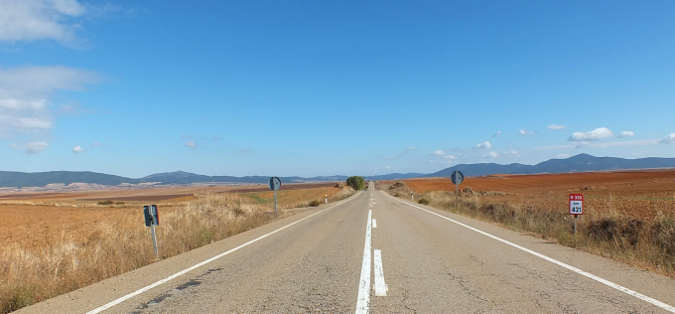
- International Vehicle insurance , normally in the form of a Green card (A Green card is recommended but not compulsory for vehicles from other EU countries. Within the EU, any vehicle insurance policy automatically includes third party cover throughout the European Union).
- European union driving licence (or Swiss, Norwegian or Croatian); for drivers from other countries, an international driving permit (IDP) may be required, particularly if the national licence is not in Spanish or English .
- Two hazard warning triangles to be used in the event of immobilization of the vehicle at the roadside.
- A high-visibility waistcoat for driver and each passenger, to be put on in the event of breakdown or immobilization.
- Front and rear seatbelts , that must be used.
- For right-hand drive cars (from Britain or Ireland), headlamp converter for night driving
- If you need glasses for driving, you must carry a spare pair in the glove compartment.
- Use of mobile phones while driving is strictly forbidden (except fully hands-free units)
- Children up to 12 years old must travel in the back of the car.

Spanish Motorways
Autovias and autopistas, motorway tolls in spain:, avoiding tolls on the spanish ap7 mediterranean motorway, avoiding tolls on the spanish ap1 motorway - to the south via madrid, speed limits in spain.
- Motorways (autovias and autopistas) : 120 km/h
- Main roads : 80 km/h, 90 km/h or 100 km/h as indicated
- Built-up areas : 50 km/h or 70 km/h as indicated

- Small hotels with character Independent hotels in Spain .
- Gitelink Spain : Rural holiday cottages in Spain
The pain in Spain: Where are Brits not so welcome this summer?
- Thursday 25 April 2024 at 12:14pm
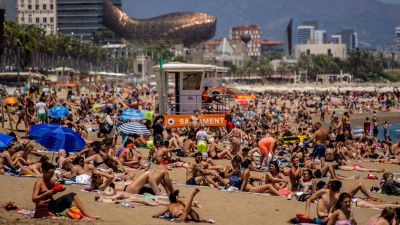
Tourists are facing a backlash from residents in Tenerife as islanders say they are struggling to cope with the influx of visitors, ITV News Europe Editor James Mates reports
Spain is one of the most popular destinations for British tourists, but the country is feeling the backlash of the cheap flights and sunny climes as large numbers of visitors are causing big problems.
A number of provinces have taken matters into their own hands and are providing guidance - and in some case strict rules - for tourists visiting over the summer, as they try and tackle overcrowding and the problems that come with it.
Tourism represents nearly 12% of Spain’s economy but there has been growing pressure from locals for governments to put measures in place to reduce the number of visitors.
So which parts of Spain might not be so keen for Brits to descend this summer?
Canary Islands
Protestors in Tenerife started a hunger strike on April 12 as part of a wider campaign demanding the Canary Islands government tackle the effects of excess tourism in the region.
Hundreds of people linked arms to form a human chain to demonstrate against the building of an additional hotel and beach resort, as well as future projects aimed at attracting more tourists. The hunger strike was still underway on Wednesday at the time of writing.
The wider movement is called Canarias Se Agota, which means 'The Canaries Have Had Enough'.
In an Instagram post the organisation said the Canary Islands are "exhausted" because of the "excessive tourism" and the "lack of attention to the basic needs of the population".
Last year the then-mayor of Barcelona described tourism as a "great challenge" for the city, and suggested there needed to be a way to limit the number of people pouring in during holiday season.
Ada Colau limited the number of hotel beds in the city during her tenure, highlighting that the city needs homes so there is space for residents to live in the busy centre.
Her successor, Jaume Collboni, banned cruise ships from docking at the Muelle Barcelona Norte and the World Trade Centre docks, a mile away from the Gothic quarter, in October.
Now cruises must dock at the Moll d’Adossat pier, which is a 30-minute bus ride from the historic centre.
Meanwhile one neighbourhood went as far as to get a local bus route removed from Google and Apple Maps to discourage tourists from using it as it was often too busy for residents to fit onboard.
“We laughed at the idea at first,” a local activist, César Sánchez, told the Guardian. “But we’re amazed that the measure has been so effective.”
Wider Catalonia region
Barcelona is the largest city in the Catalonia region, but authorities for the entire area are considering imposing water restrictions on tourists if domestic consumption does not decrease.
The Catalan government is considering a restriction of 100 litres of water per day per tourist for hotels for three months as it looks to tackle drought in the area.
According to Barcelona’s hotel guild, the average tourist to Barcelona in 2022 used some 163 litres per day, while the figure rose to over 240 litres for luxury hotels.
The limits for tourists would not include the water used to fill swimming pools.
Majorca has introduced a series of new rules over the last couple of years that aren't explicitly preventing tourists from enjoying the island, but do seek to weed out "drunken tourism".
A number of restaurants banned shirtless, costumed or football-shirt-wearing travellers, according to Juan Miguel Ferrer, the chief executive of Palma Beach.
Swimwear, trunks and novelty accessories bought from roadside vendors - such as gold chains - are also said to be banned.
"Since May 10, we’ve been suffering the arrival of large groups of tourists who are only looking to get drunk in the streets, or on the seafront or even on the beach,” Mr Ferrer said in 2022.
“You’re not going to come here in beach clothes or come straight from drinking in the streets."
Alicante introduced new noise-related restrictions in 2023 in response to influxes of tourists causing disruption for locals.
Rules had originally been put in place in 2019, but they were strengthened last year. The array of noises encompassed by the regulations include open air concerts, use of musical instruments on beaches, and shouting.
The local city council warned of hefty fines for anybody flouting the rules.
Money matters and passport pains
Post-Brexit, Brits are subject to the 'third states' rules Spain imposes on visitors from outside the European Union.
A traveller visiting Spain must "present proof of having sufficient financial means for the proposed stay", or at least the ability to legally obtain that money, according to the Spanish foreign ministry.
In 2023, the minimum amount required was $120 (£97) per person per day, and the traveller had to have at least $1100 (£885) or its equivalent in foreign currency regardless of the length of the stay.
Travellers can show they have enough money by presenting cash, travellers' cheques, a credit card with a bank account statement, an up-to-date bank book or similar. The ministry states that bank letters or online bank statements are not accepted.
Brits flying abroad are also being warned about post-Brexit passport rules , which have landed travellers with hefty fines.
Some families are finding themselves thousands of pounds out of pocket when they have been banned from boarding flights due to the rule changes.
When the UK was a member of the EU, British passports remained valid up to and including their expiry date for travel to other EU countries, but now passports need to be valid for valid for at least three months after the date you intend to leave the EU country you are visiting.
More details of the post-Brexit rules on passports can be found on the ITV News website .
Want a quick and expert briefing on the biggest news stories? Listen to our latest podcasts to find out What You Need To Know…
Thousands protest in Spain's Canary Islands over mass tourism
- Medium Text

Sign up here.
Reporting by Borja Suarez Writing by Ana Cantero Editing by Helen Popper
Our Standards: The Thomson Reuters Trust Principles. New Tab , opens new tab
The Russian Defence Ministry said on Saturday that its forces had carried out 35 strikes in the last week against Ukrainian energy facilities, defence factories, railway infrastructure, air defences, and ammunition stocks.

World Chevron

Socialist supporters call on Spanish prime minister to stay
Thousands of Socialist Party supporters travelled from across Spain for a rally in Madrid on Saturday to call on Prime Minister Pedro Sanchez to stay on, after he stunned the country this week by saying he might quit the premiership.

The Drinks Business
‘currency advantage’ driving down singapore sake sales.
Year-on-year sake sales in Singapore dropped significantly in 2023, but importer, distributor, and retailer Patrick Sng says this is down to a good exchange rate driving tourism to Japan.

Sake exports to Singapore in 2023 were just 64.9% of what they were in 2022, according to official figures by the Japan Sake and Shochu Association. This is despite a major spike in 2022, when sales of Japan’s national drink to Singapore were 393.8% up on the year before.
However, this is all down to a current “currency advantage”, according to Patrick Sng, who presented a talk entitled ‘Sip the Future: Expert Insights and Strategies for the Wine and Spirits Trade’ at ProWine Singapore this week.
The exchange rate is currently ¥1 to S$0.0087, and Sng argued that the relative affordability in Japan at the moment is pushing tourism from Singapore. As such, Singaporeans are drinking Japanese sake in the country from which it comes, rather than exporting it back home.
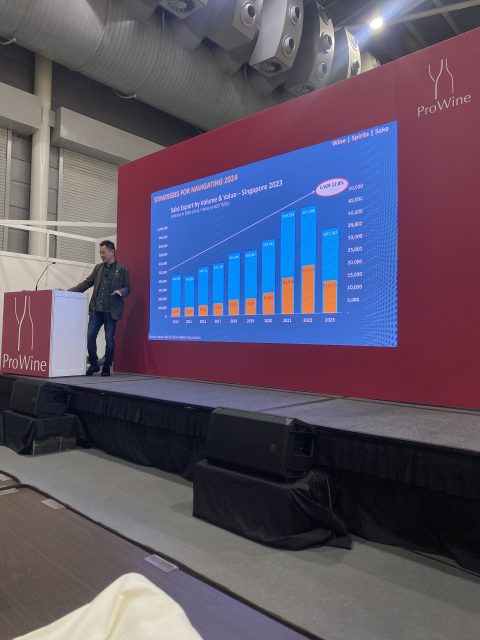
He argued that despite the drop in sales volumes, “we are more willing to pay for premium sake” in Singapore.
The numbers, however, show that while volume exports to Singapore in 2023 were 76.1% of the year before, value exports were 64.9% compared with 2022.
But economic headwinds could be to blame for these statistics. Sng argued that in Singapore, we’re seeing more “belt tightening” among consumers as cost-of-living concerns rise.
Singapore exports of Japanese sake may be down, but the trend is not shared across other countries on the continent. Sake exports to India have risen by over 900% in the last decade.
Rising interest in sake among Indian consumers has been spurred on by the proliferation of Japanese restaurants especially in the bustling metros like Delhi, Mumbai, Bengaluru and Chennai. And tier two cities are fast catching up on the trend. Read more about that here.
It looks like you're in Asia, would you like to be redirected to the Drinks Business Asia edition?
Yes, take me to the Asia edition No

- Privacy Overview
- Strictly Necessary Cookies
This website uses cookies so that we can provide you with the best user experience possible. Cookie information is stored in your browser and performs functions such as recognising you when you return to our website and helping our team to understand which sections of the website you find most interesting and useful.
Strictly Necessary Cookie should be enabled at all times so that we can save your preferences for cookie settings.
If you disable this cookie, we will not be able to save your preferences. This means that every time you visit this website you will need to enable or disable cookies again.
Travel Safe

Spring time is here! Spain is filled with plans for you
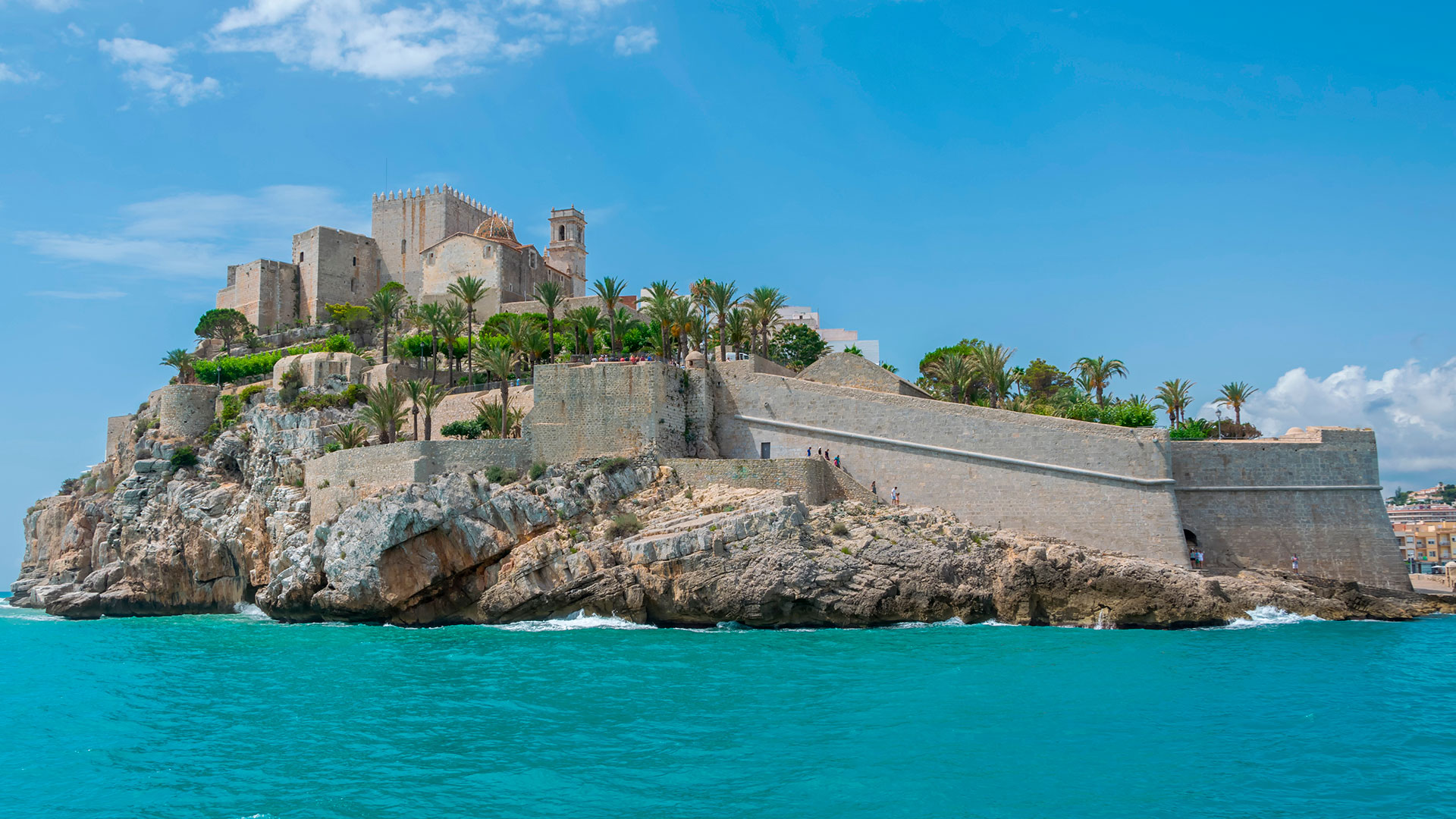
Visit fairytale castles in Spain's most beautiful towns

15 spectacular blossoms to experience up close

Route of the Monasteries in the Ribeira Sacra
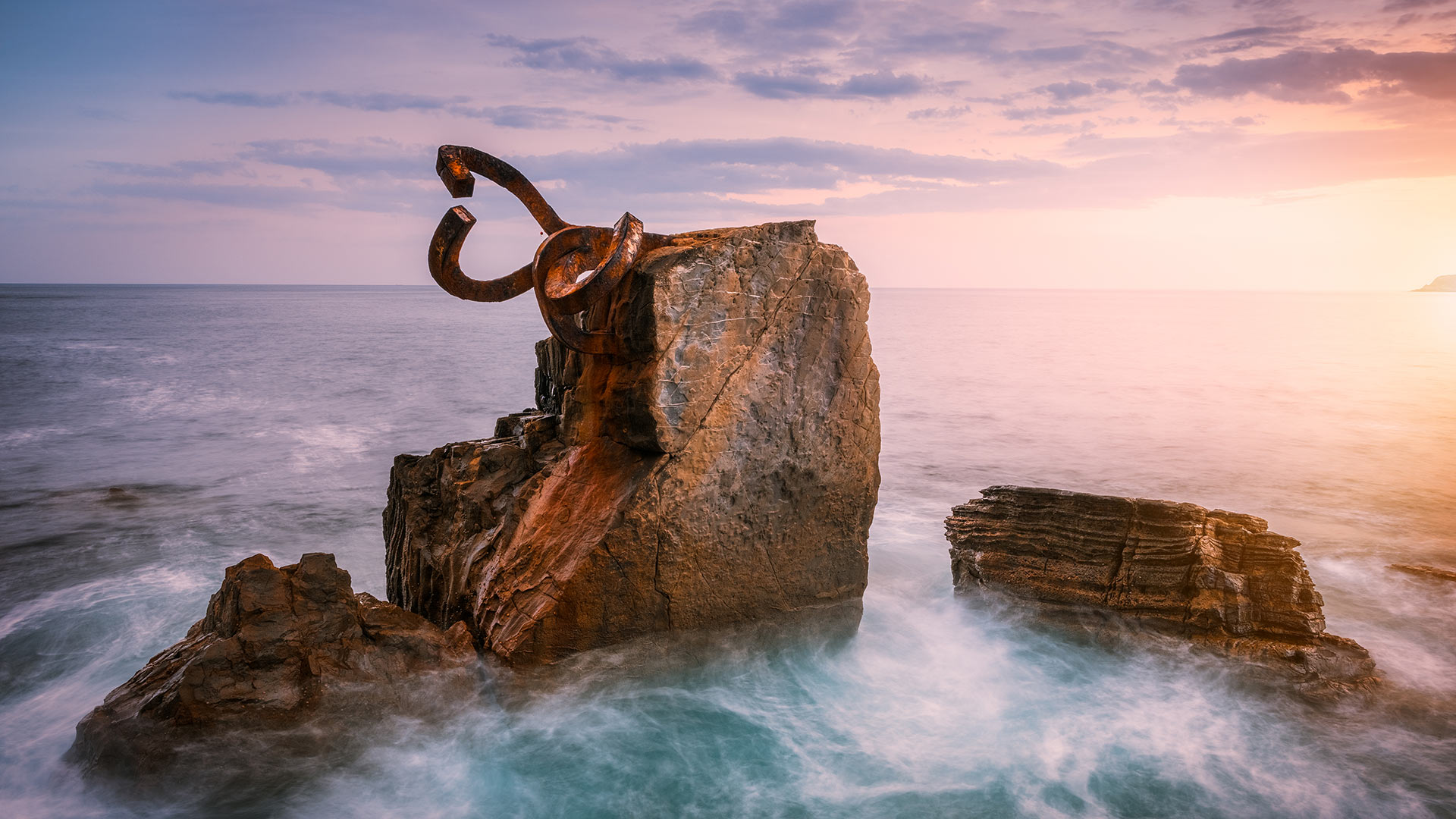
Chillida, 100 years of the universal Basque artist

Start the route with the best music festivals
Discover our destinations
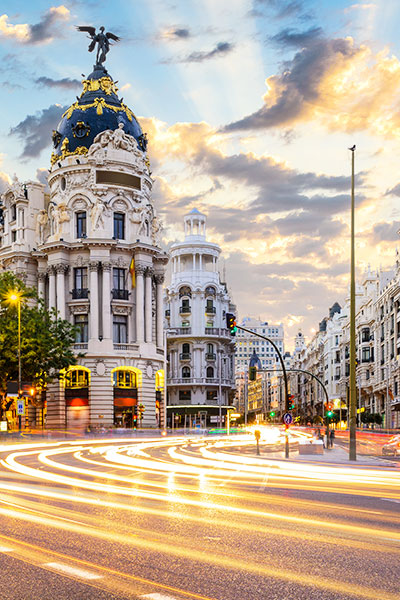
The capital city with a thousand options
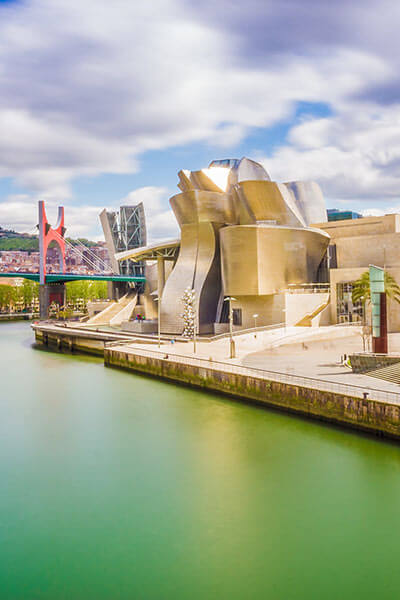
One of Spain’s most avant-garde cities
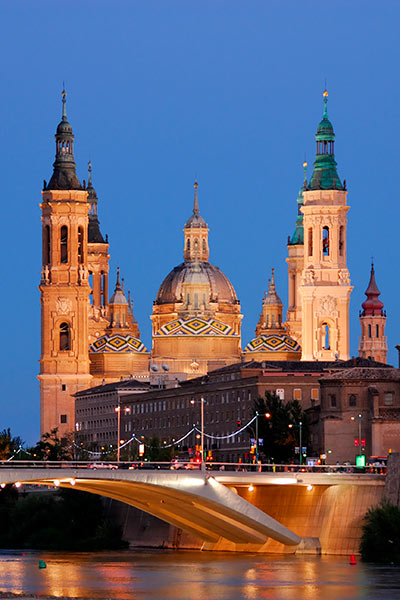
A great city with lots to discover
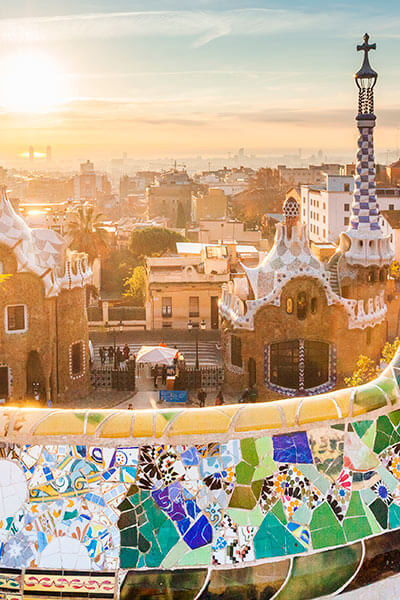
A cosmopolitan vibe
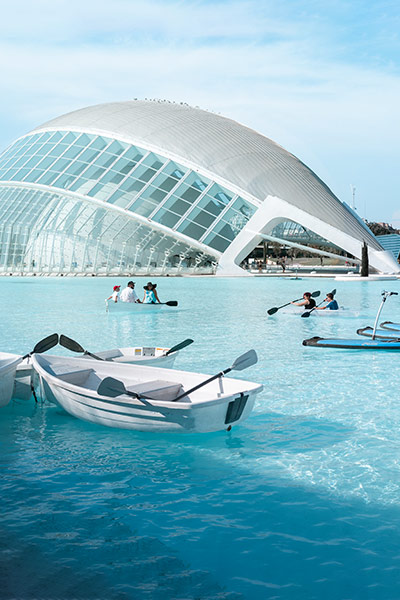
The essence of the Mediterranean
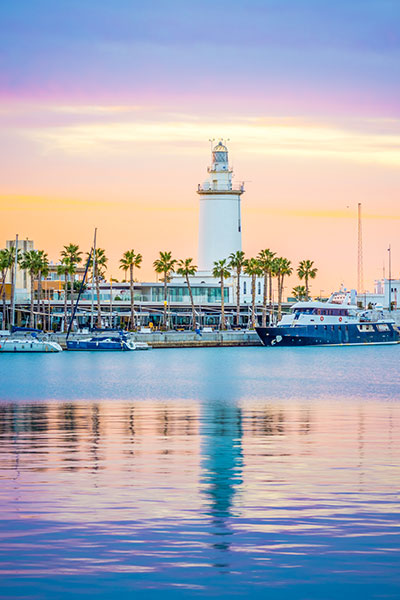
The capital of the Costa del Sol is reinventing itself
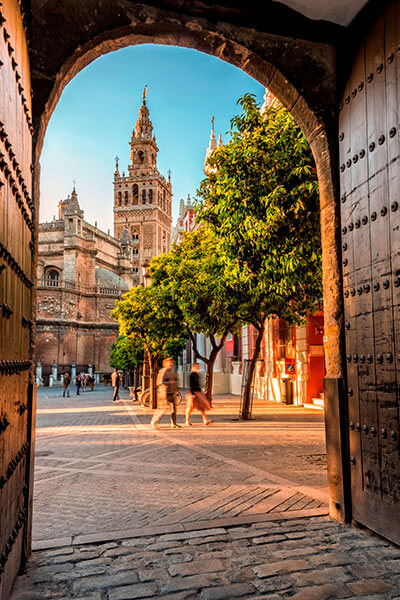
An inspiring destination
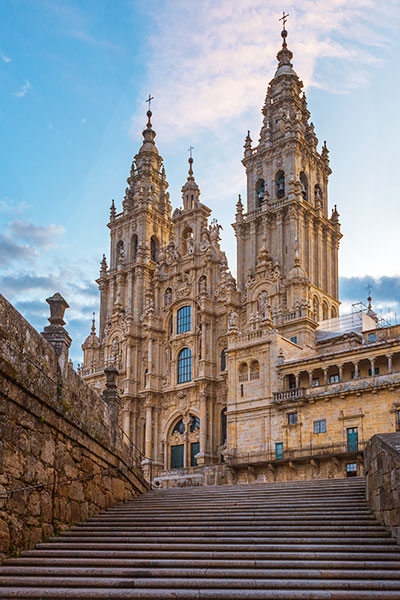
The final destination of St. James’ Way
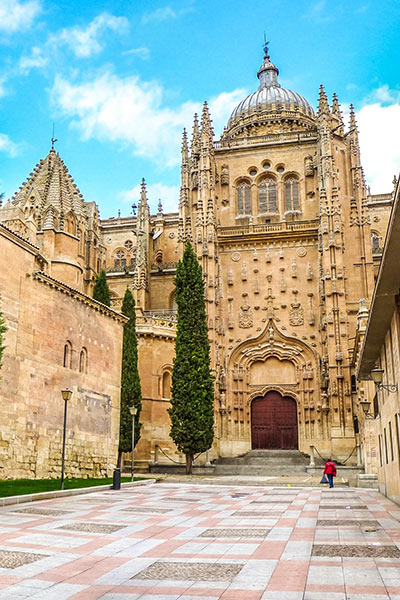
The Golden city of a thousand legends
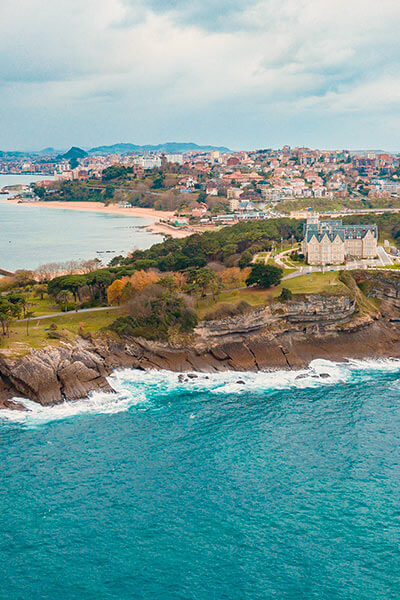
Ideal for a getaway
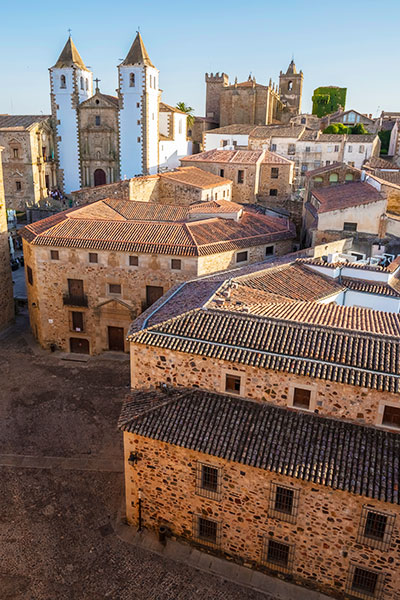
A picturesque medieval setting
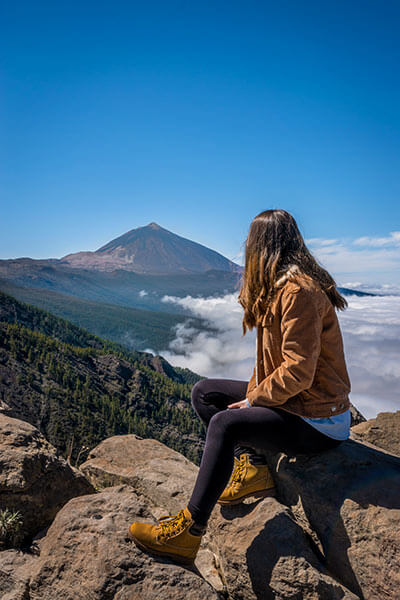
European sunshine capital
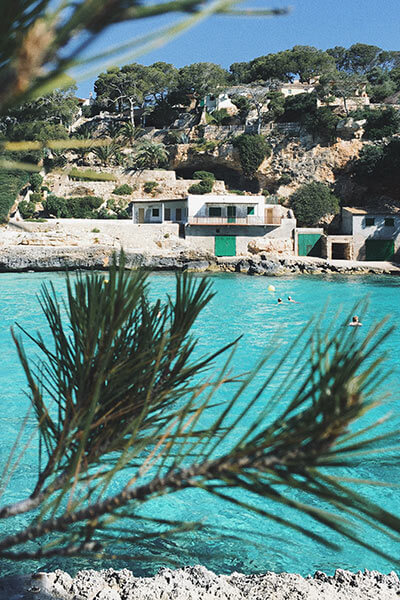
Idyllic coves, beautiful sunsets...
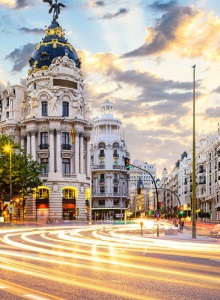
Santiago de Compostela
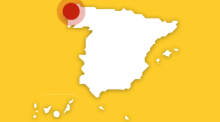
Canary Islands
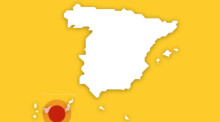
Balearic Islands
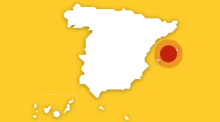
Not to be missed
Choose the travel plan you like the most to make your stay in Spain unforgettable

Holiday ideas in Spain, depending on how and with whom you travel
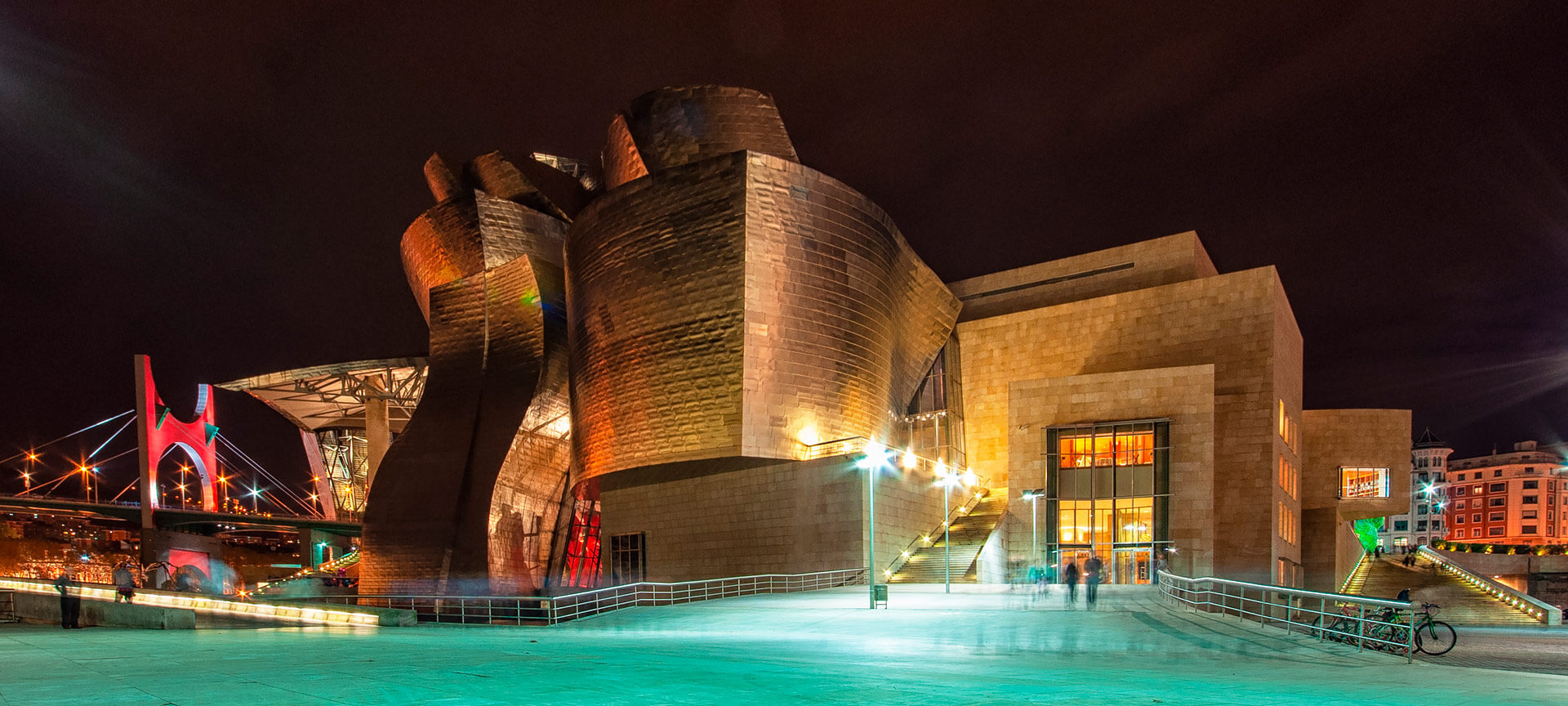
Museum Day is coming! Here are some ideas to make the most of it
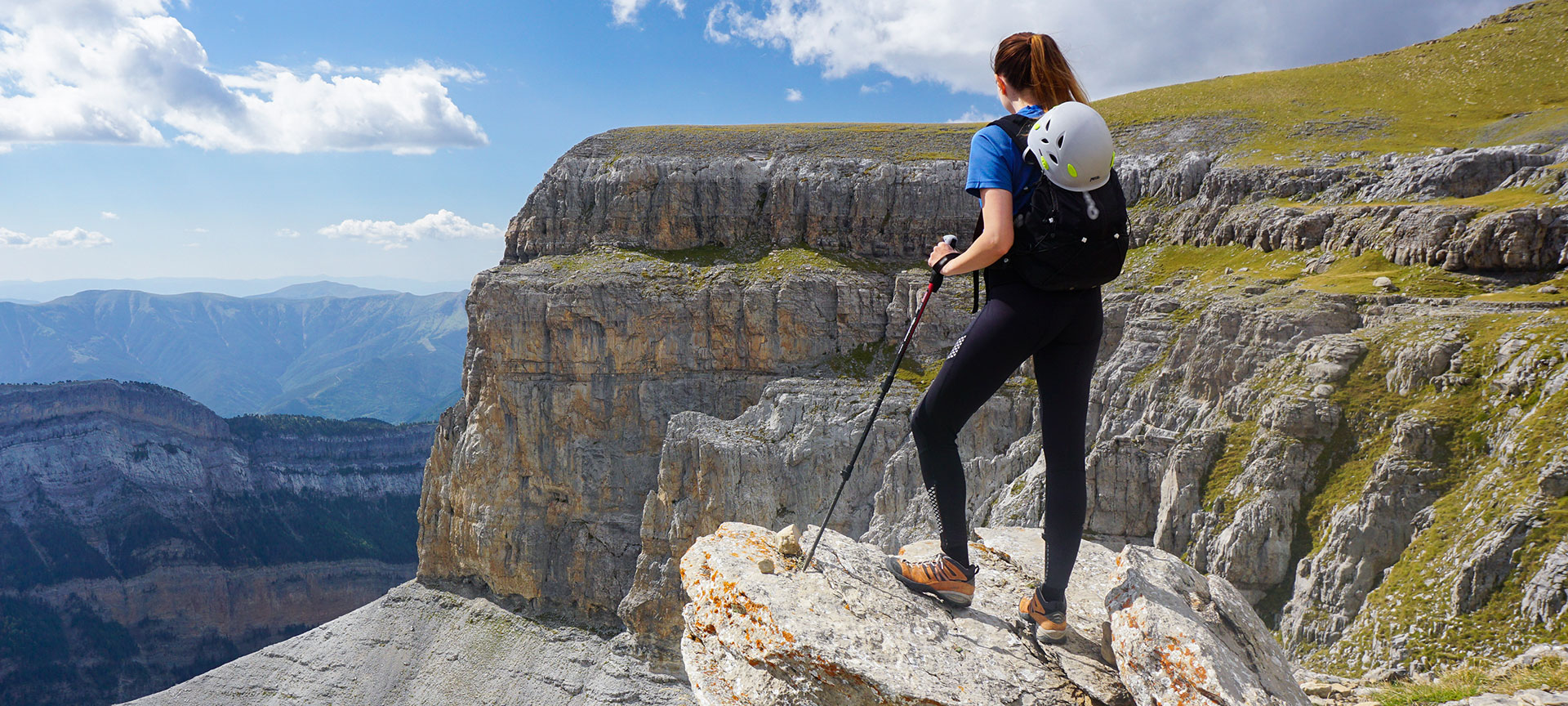
Sport and adventure
Come for a multi-adventure outing! Do you dare?
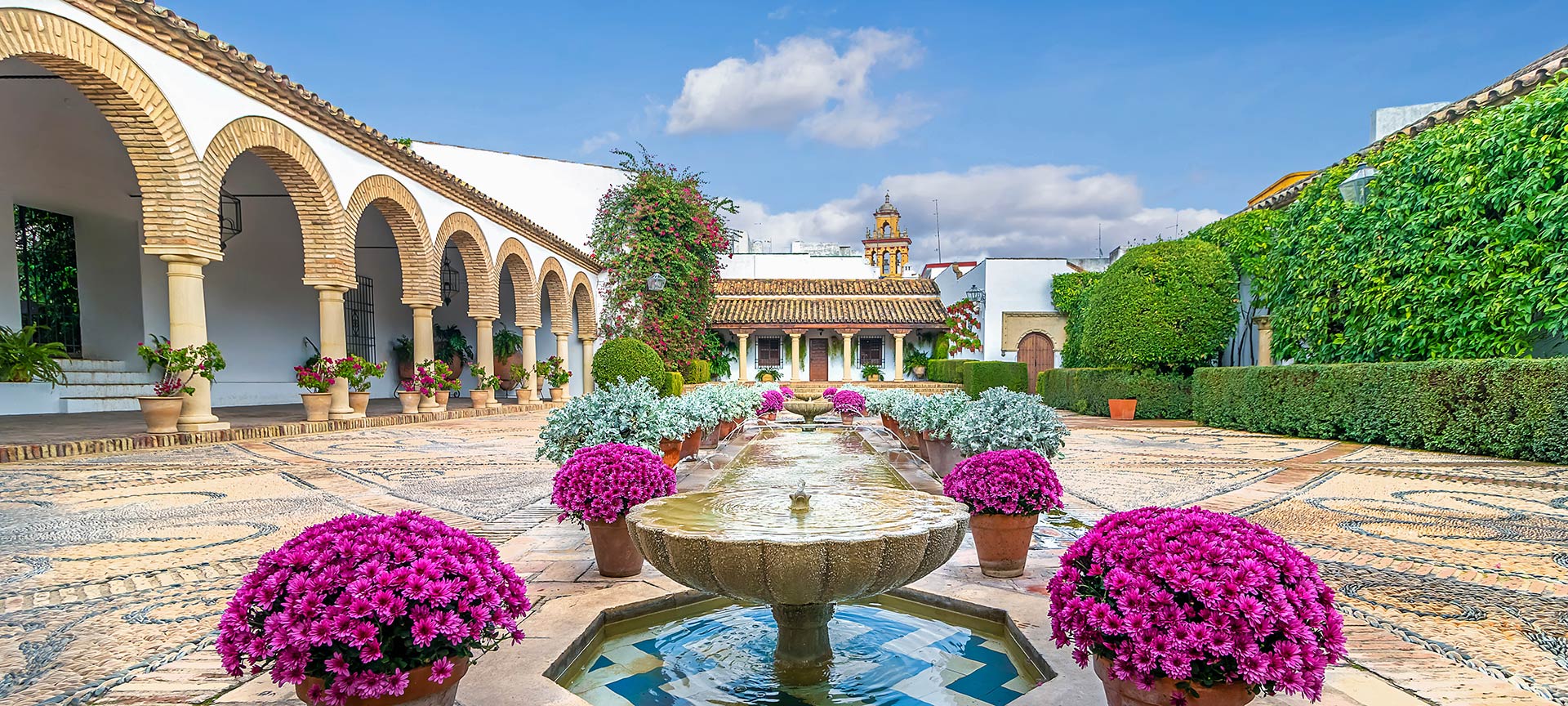
Urban tourism
Cordoba: the city with four visits to places considered as World Heritage sites, packed with festivals in May

Prepare a family getaway to the countryside

Other ideas for your trip
Do you want some more suggestions for your holidays?

Most popular spain.info TikTok videos

Our 10 most-liked photos on Instagram
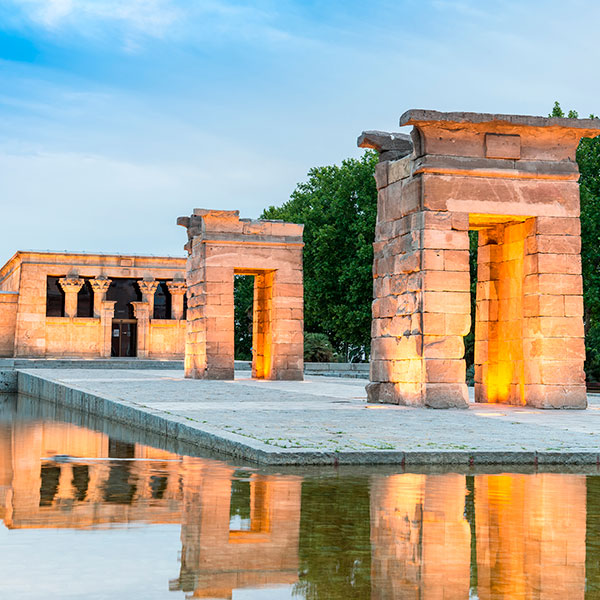
Rediscovering Madrid and Barcelona

Magical natural places in Spain
Are you sure you want to delete this route?

Route planner
Create your own plan for your trip to Spain with a route to suit your requirements
Enjoy the best events
Exhibitions, festivals, festivities... Don't miss a thing!

16 March 2024 - 03 May 2024
Cherry Blossom Festival

22 April 2024 - 05 May 2024
Tennis: Madrid Open

03 May 2024 - 05 May 2024
International Comic Fair
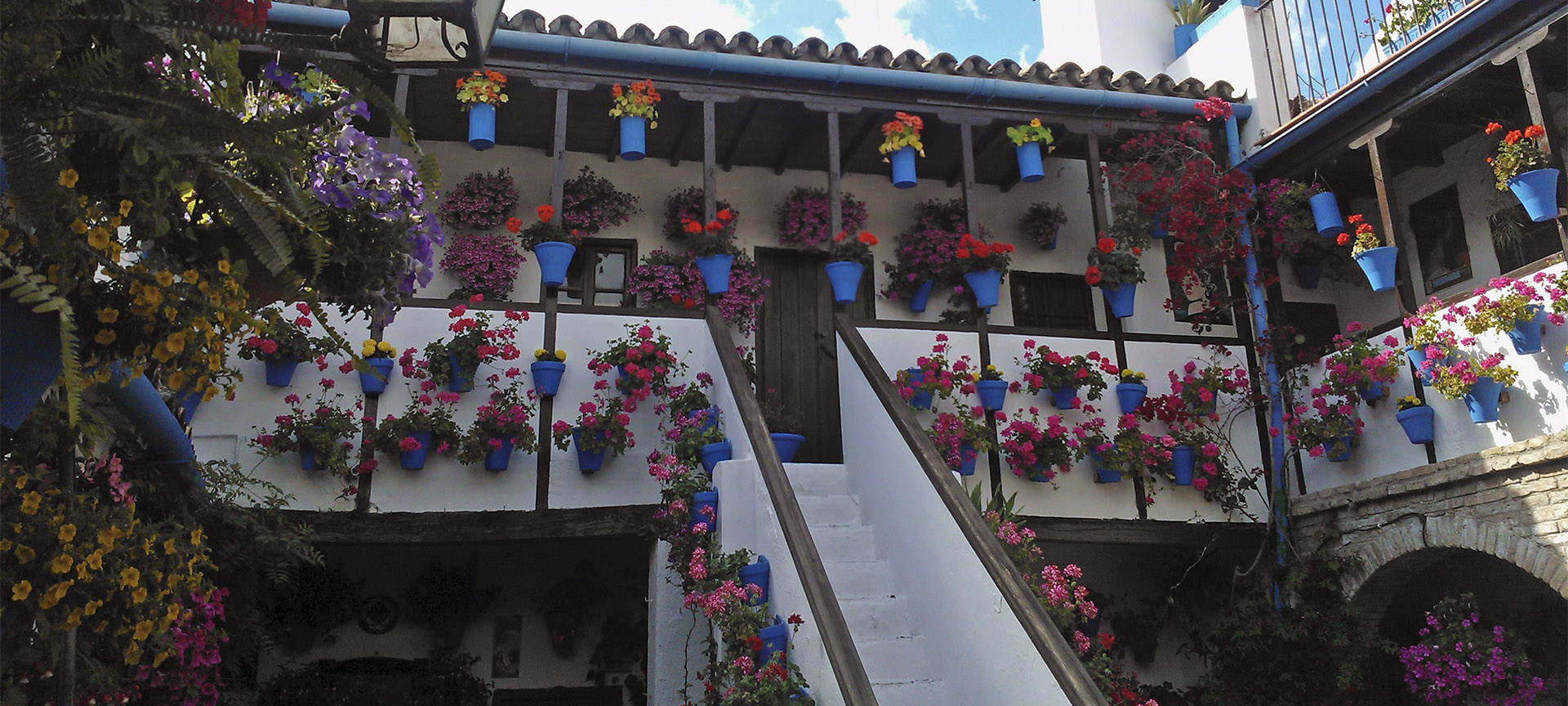
02 May 2024 - 12 May 2024
Festival of the Courtyards in Cordoba

17 May 2024 - 20 May 2024
Pilgrimage of El Rocío
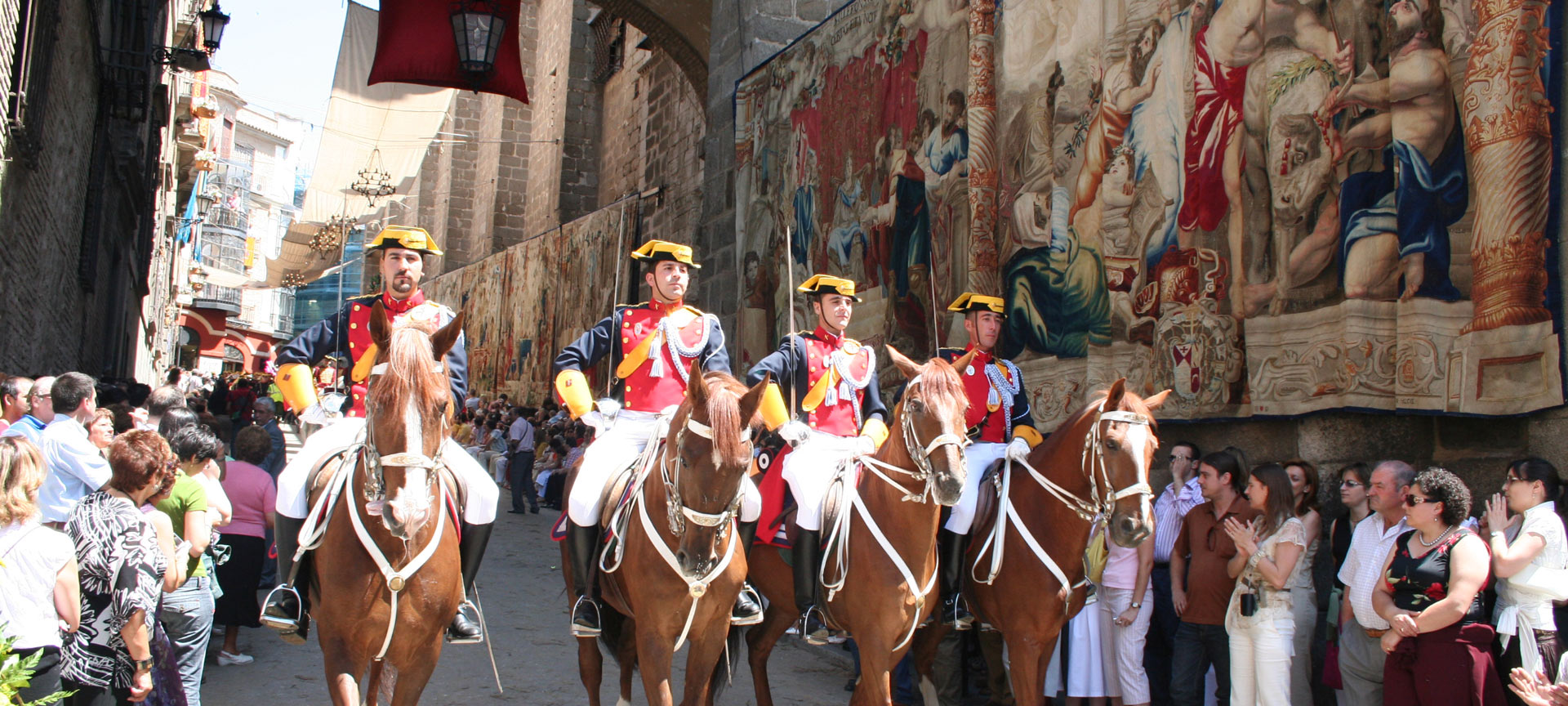
30 May 2024
Corpus Christi in Toledo
All the useful information you need.
Trip advice to get the most out of your holidays
The weather in Spain
Today in: Palma
How to get there
How to get around, practical information.

Book your experience
Thousands of activities thought out for you
#visitSpain
Share the best of Spain on our networks
The best ideas for travelling around Spain
Subscribe to receive monthly information with unique travel plans


COMMENTS
Seatbelts: All passengers in a car's front and back seats are required to wear a seatbelt. Driving age: You must be 18 years old to drive and 21 years old to rent a car in Spain. Alcohol: The legal blood alcohol limit for driving is 0.05 percent or 0.25 milligrams per liter in exhaled air. Drunk driving laws and punishments are strict in Spain ...
1. Drive on the right. One of the easiest things about driving in Spain as a tourist from the United States is that they drive on the right-hand side of the road. In fact, most countries in Europe do - with the exception of the United Kingdom, Ireland, Malta, and Cyprus. 2.
For all other drivers, the limits established are 0.5 g/l of alcohol in blood and 0.25 mg/l in exhaled air for general drivers, and 0.3 g/l in blood and 0.15 mg/l in exhaled air for professional and novice drivers. Helmets must be worn on motorbikes, mopeds and bicycles. In addition to the general traffic regulations, there are now specific ...
6 Safety Tips for Driving in Spain - Rules and Regulations. 6.1 Drive On The Right. 6.2 Adhere To Speed Limits When Driving In Spain. 6.3 Never Drive Under The Influence. 6.4 Wear A Seatbelt At All Times. 6.5 Mobile Phones Are Prohibited While Driving.
Driving in Spain as an American requires these two licenses: Your valid US driving license. An International Driving Permit (IDP) (valid for a year, and it has to be issued before traveling). If you are coming from another country, check the specific requirements that apply to your case. In some cases you will just only need your valid driving ...
Road rules for driving in Spain. Driving is on the right-hand side of the road, and overtake on the left. All drivers must carry two red warning triangles to be used in the event of an accident or breakdown to be positioned 50 meters in front of and behind the vehicle. You must also have a functioning spare tire and the tools to fit it and wear ...
Highlights of Driving in Spain. Travel Spain by car and you'll find all the following benefits. While the big cities can get the pulse racing, for the most part, driving in Spain is a beautiful experience. Here are five reasons why: 1) THE ROADS ARE EMPTY. Outside the main cities that is. Gleaming wide main roads covered with smooth tarmac ...
5. Don't panic if you're stopped. 6. Pay your driving fines as soon as possible. 1. Know the types of roads and gas. Spain's road system is made up of motorways and main roads: Highways ( autopistas) are marked with and A or E and the road number. Toll roads ( autopistas de peaje) are marked with AP and the road number.
Driving in Spain Checklist. What you will need to carry with you or in your vehicle to be able to legally drive in Spain. 1. Full and valid driving licence - ( permiso de conducir ) or a valid EEC driving licence. 2. Insurance documents - ( Poliza de Seguro ). 3. Identification - Some form of identification such as your passport, national ID or ...
And according to the Australian Embassy in Spain, "Under Spanish law, Australians on a 90 day Schengen Visa may drive a vehicle in Spain if they hold a: valid Australian State or Territory Driving Licence and valid International Driver's Licence. To obtain an International Driver's license contact your relevant State or Territory Automobile ...
While the minimum legal driving age in Spain is 18, most car rental companies require drivers to be at least 21 years of age before they consider renting them a car. In addition to meeting the age requirements, you will need to have a full valid driver's license, and a valid passport. You will also need a credit card to pay for the car rental ...
Practical information. Prepare for your trip in advance with our useful information on entrance requirements, money, safety, healthcare, opening times, etc.
Driving in the major city of Spain unveils the real magic of this diverse country, taking you beyond typical tourist routes and into the heart of Spanish culture. Imagine cruising through rolling vineyards, historic Spanish cities, and along the stunning Mediterranean coast while graced with the flexibility to discover hidden gems at your whim.
9. Road trip around Mallorca. 5 days, 175 miles. Lazy. 10. The full circle - A complete road trip around Spain. 35 days, 2,800 miles. Challenging. Whether you want a relaxing drive along the coast or drive around the entire country of Spain, here are the 10 amazing options for a Spain road trip to pick from.
Touring Spain by Car. As one of the most geographically diverse and culturally rich countries in all of Europe, from the spectacular sun-soaked beaches of San Sebastian, to the crisp mountainous vistas of Bilbao, a trip to Spain is something all travel enthusiasts should partake in at least once.Spain has the second highest number of UNESCO World Heritage Sites and the largest number of World ...
The Spanish drive on the right - the opposite to the UK. The national speed limit on motorways in Spain, unless otherwise indicated on local signage, is between 100km/h (62mph) and 120km/h (80 mph). On a main road outside a built-up area it's 90 km/h. For built-up areas it's 50km/h. Dial 112 in an emergency.
Driving in Spain. Car travel in Spain is easy, with a good network of Autovias (A) and Autopistas (AP). The latter were toll roads until 2020 when many (but not all) became toll-free. Fuel and car hire are some of the cheapest in Europe making Spain a really cost-effective place to take a road trip.
A2. Madrid - Zaragoza (continues to Barcelona with the AP2) To Zaragoza: 315 km / 3 hrs 15 min To Barcelona: 620 km / 6 hrs 15 min. A3. Madrid - Valencia. 350 km / 3 hrs 30 min. A4. Madrid - Seville (continues to Cádiz with the AP4) To Seville: 530 km / 5 hours To Cadiz: 650 km / 6 hours.
Toll Roads in Spain; Local Tips For Tourists Driving in Spain; Bonus- Rent A Car in Spain; Legal Requirements To Drive in Spain. You need to be at least 18 years old to drive a car in Spain. Note that all drivers must hold a valid driving license. Depending on where you are from, you may need an International Driving Permit as well.
So, if in doubt, get an International Driving Permit (IDP) to carry along your driving license. USA, Canada, Australia, and other countries. Under Spanish law, visitors on a 90-day limit stay or having a Schengen Tourist Visa may drive a vehicle in Spain if they hold a valid home country driving license and a valid International Driving Permit ...
Motorways (autovias and autopistas) : 120 km/h. Main roads : 80 km/h, 90 km/h or 100 km/h as indicated. Built-up areas : 50 km/h or 70 km/h as indicated. Speed traps: There are now plenty of speed traps, or radars, on main roads in Spain, and police can and do issue on-the-spot fines.
Drink-driving laws in Spain. Drink-driving laws are very strict in Spain, and the police regularly carry out roadside checks for alcohol and drugs. For drivers who have had their licence for 2 or more years, the legal limit is 0.5g of alcohol per litre of blood, which is just over half the 0.8 g/l limit in England, Wales and Northern Ireland.
Tourism represents nearly 12% of Spain's economy but there has been growing pressure from locals for governments to put measures in place to reduce the number of visitors.
Step 2: From Barcelona to the Costa Daurada and Terres de l'Ebre: southbound. A road for lovers of hairpin bends and cliff-top views, the C-31 runs from Castelldefels to Sitges. Its proximity to the coast means fantastic views are guaranteed, but remember to drive very carefully. Distance:240km Journey: By car.
SANTA CRUZ DE TENERIFE, Spain, April 20 (Reuters) - Thousands of people protested in Tenerife on Saturday, calling for the Spanish island to temporarily limit tourist arrivals to stem a boom in ...
Year-on-year sake sales in Singapore dropped significantly in 2023, but importer, distributor, and retailer Patrick Sng says this is down to a good exchange rate driving tourism to Japan.
Tourist information about Spain: art, culture, museums, monuments, beaches, cities, fiestas, routes, cuisine, natural spaces in Spain | spain.info